 USN Fleet Destroyers (1917-1947): 156 destroyers (DD-186 to DD-347)
USN Fleet Destroyers (1917-1947): 156 destroyers (DD-186 to DD-347)The Clemson-class were 156 destroyers built for the US Navy between 1918 and 1922. Second of the two wartime mass-produced classes of “flush deck” hull destroyers (“four-pipers”). They were near-repeats of the Wickes class, themselves derived from the experimental Caldwell design. The previous class was faster, the new one will have more range. Completed after the war was over, with most of the 162 planned effectively completed, the Clemson saw nothing of WWI were served at least ten years in the interwar. Between reconversions as fast minesweepers/minelayers and when WW2 broke out, fast assault transports (APD), and the 50 lend-lease ship going to the RN, RCN or Royal Norwegian Navy, Soviet Navy, they saw overall a lot of action, with 20 lost. #ww2 #usn #usnavy #royalnavy #usdestroyer #clemson #flushdecker
Improving on the Wickes class

Barely a year and half separated both designs, the Wickes and Clemson. Both were ordered to be built en masse and in emergency ans the United States entered the war, first to answer the U-Boat perile alongide the entente navies. It was an unprecedented effort for US naval yards to answer a combined, massive order for 280 ship on April 1917, an unprecedented (and beaten since by the WW2 Fletchers, 171 ships) record for that category of ship, the destroyer.
The Wickes derived from the novel design that was the semi-experimental Caldwell class but the initial order for 200 destroyers was cancelled mid-course, curtailed to 111 completed, whereas the design was completely modified for the Clemson class, more tailored towards the anti-submarine role and especially given a better range. This new serie was started a year later, and on 162 ordered, most would be built despite the end of the war in November 1918. Indeed, production went on until 1922, stopped in effect by the signing of the Washington Treaty which drastically reduced tonnage.
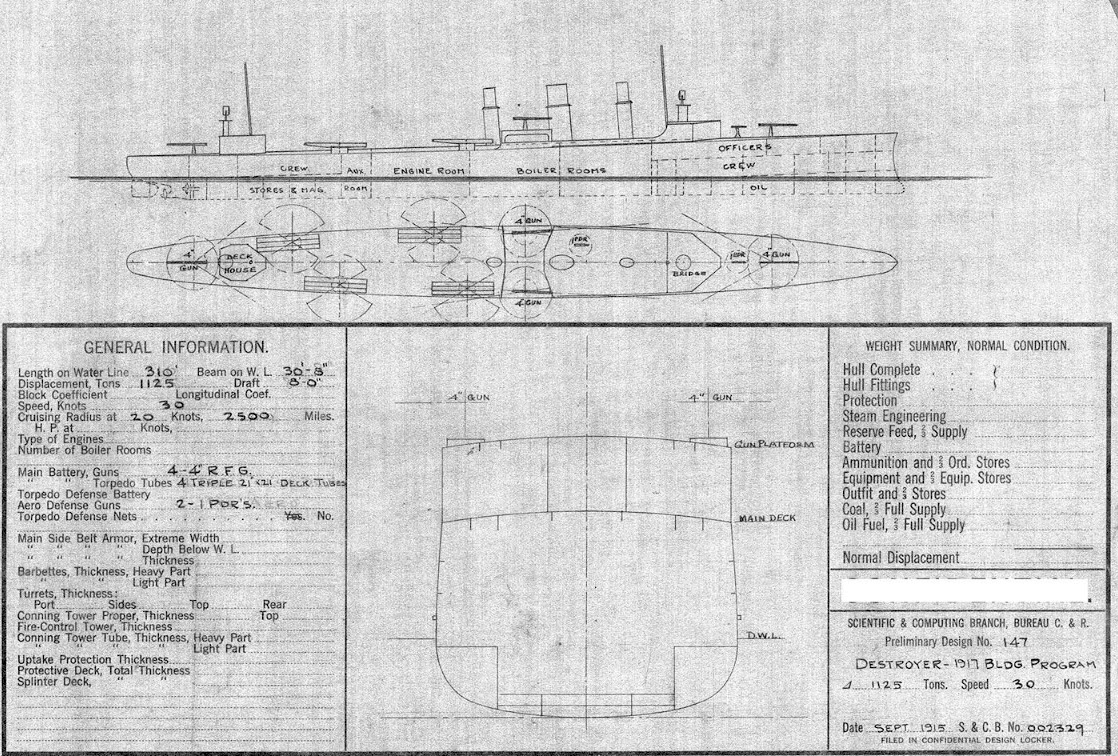
Preliminary design for the Wickes class in 1917.
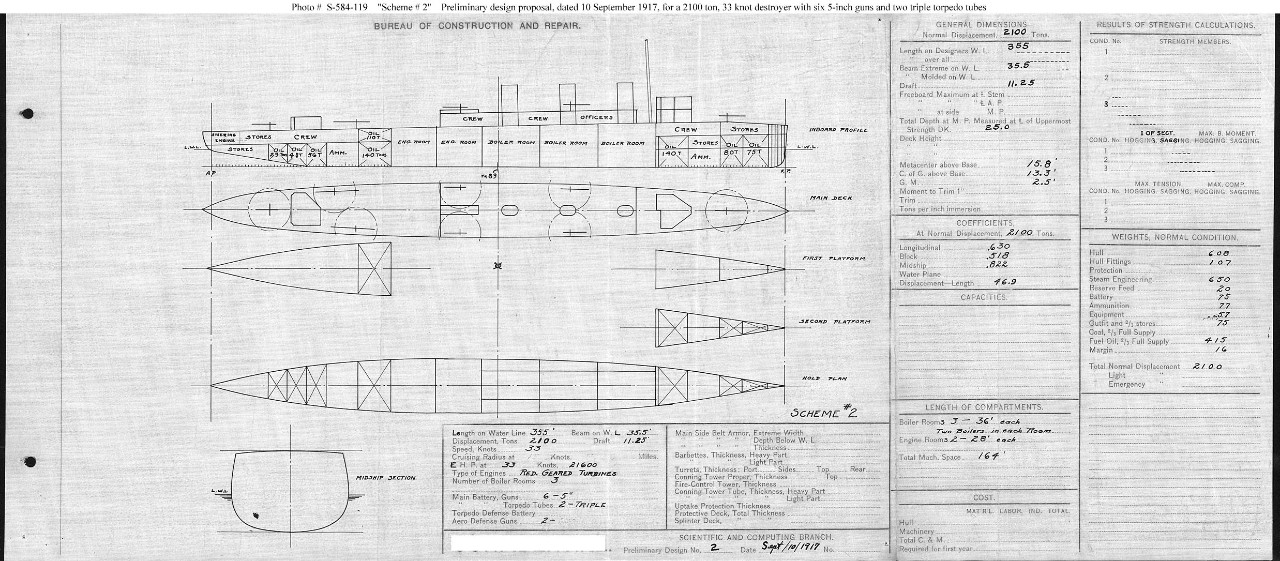
S-584-119 Large Destroyer “Scheme # 2 in September 1917 src
The Wickes and Clemson were a product of their time, superior to most destroyers in service at the time by speed and armament but they were crudely built with spartan accomodations and a design that made them “wet” in heavy weather especially in the North Atlantic. In fact during the post-1935s renewal of destroyer construction, most were sent to souther ports and the Pacific. But they were incomaratively less attractive to young sailors than the “gold platters”, contrasting by their size, accomodations, and seaworthiness.
The interwar was cruel to these boats, as tonnage limitations had many mothballed and in and out of commission to reduce cost. Since none saw WWI and many were just discarded before the start of WW2 they even never shot a round in anger. Despite being surplus to peacetime requirements, these destroyers at least helped cementing a standard of interwar destroyer tasked not only to defend the east and west coast, but also Cuba, Panama and the Philippines, as well as take their place in the battleline. At last the Clemsons were most often used in that role unlike the previous Wickes, since they had “legs”.
This long post will see their caracteristic, interwar service and WW2 service in a condensed way due to the number of ship to examine, but with few examples of their own category, which will be also seen in detail.
Design of the class

Clemson class plan: USS Doyen, DD-280
Design Changes compared to the Wickes class
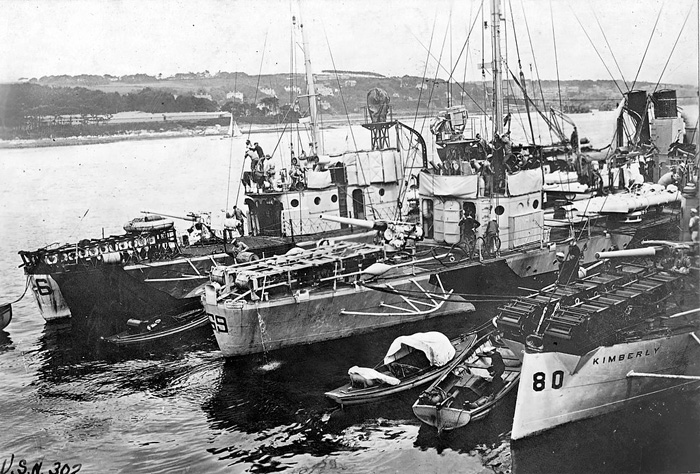
USS Caldwell (DD-69) and USS Allen (DD-66) at Queenstown, Ireland, showing their different stern from a Wickes-class ship, USS Kimberley, “V-shaped”.
The Clemson class were a wartime, emergency, straightforward expansion of the Wickes-class destroyers. The Naval staff indeed wanted a class more appropriate for ASW, and several design studies were completed, including some hull design revisions (the stern mostly), a few changes in superstructures, but overall a redesign of the interior to allow more fuel bunkerage in order to improve their range. This first proposal was quite dramatic as it was paid by accepting a dramatic loss in speed, down to 26–28 knots (48–52 km/h; 30–32 mph) with the removal of two boilers and the space freed in part used to store more depth charges (and fuel). In short, despite their appearance, these destroyer are considered the forerunners of the destroyer escorts of World War II.
Like for the previous Wickes at some point it was decided to uUpgrading the gun armament, from 4-inch (102 mm) to 5-inch (127 mm) guns but ultimately one DD-231 to DD-235 were so. However there were questions also of adapting twin mounts instead of single ones, but this was done only for three destroyers (see later).
One of the biggest change was to get rid of the tapered stern of the Wickes-class destroyers, made to ease minelaying. This proved a bad idea as its shape acted as a “brake” in hard speed turns, resulting in a large turning radius. This was to be corrected by returning to the proven previous “V” shape, which was still fine for depth-charge dropping and did not had effects on hard turns, and confirmed by the adoption of an enlarged rudder to further enchance agility. But again, to not disturb production, it was chosen to keep the tapered cruiser stern. Again it was still believed to make for a nice depth charge deployment feature. But was found to equally dig into the water and increasing turning radius, the only alleviating feature there being the increased rudder size. The ships were also proved to heavy roll in light load conditions (a reason why the twin guns solution was not implemented) but if the hull had a great strength thanks to the flush deck configuration it was still also very damp.
But the propulsion change was the greatest. At the start, the General Board decided that a 35 knots (65 km/h; 40 mph) speed was preferrable to allow the Clemson class to be used as a fleet escort, however the need for more for destroyers precluded any change that can slow production, compared to the Wickes class. So in the end, Wing tanks for fuel oil were installed on both sides, resulting in a better operational range. The fuel oil however was stored above the waterline. This created an additional vulnerability, clearly. But the naval staff estimated that for the remote chance of a hit there (remember the very low rate of shell hits at the time, even reduced for a small, very fast target) a 4,900-nautical-mile (9,100 km; 5,600 mi) radius of action was worth it. There were also built-in provisions for extra 5-inch guns to be later installed (and the quesiton of twin mounts) and a second 3-inch (76 mm) anti-aircraft gun was installed on the after deck-house.
The General Board recommendation for more of these redesigned destroyers more specialized in ASW tasks was confirmed by the vote of a larger total of 160 destroyers, and for a final count of 267 combined. If considering the Wickes and Clemson were closed to the point of making the single same class of destroyer, this is a world record, never surpassed. Still, production compromised led to a design far less ambitious as anticipated for ASW warfare, and they still remained optimized enough for regular fleet operation, justifying their existence in the postwar years.
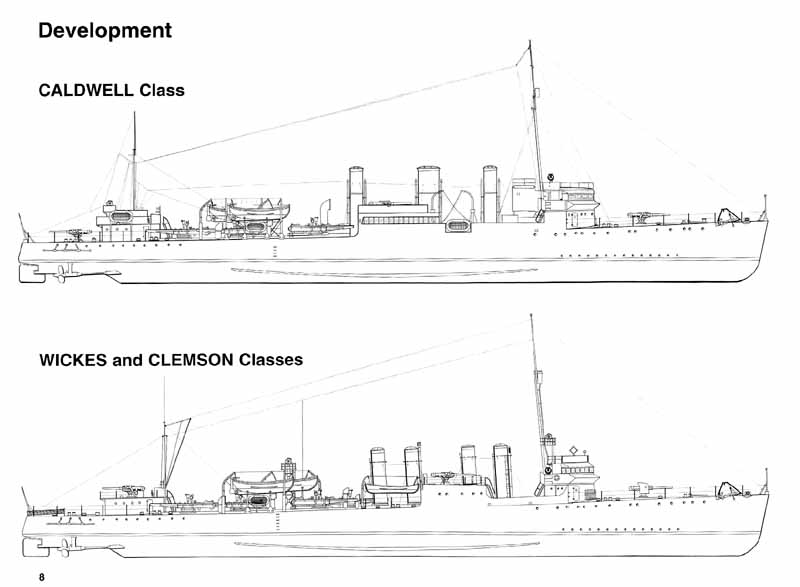
Differences between the Caldwell and Wickes class
Powerplant
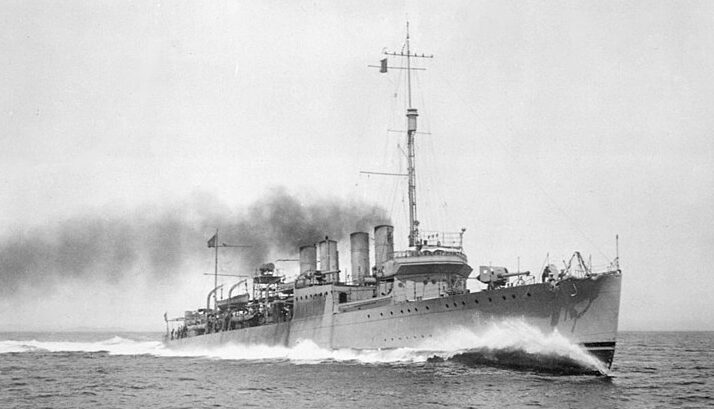
USS Brooks in sea trials, 1920
The Clemson like the Wickes class had two propellers, planted on shafts driven by two geared steam turbines. They were fed by four boilers of various types depending of the yard, working at 300 psi (2,100 kPa) with saturated steam. This was a virtual duplicate of the previous class and produced a total of rated for 24,610 hp (18,350 kW) instead of 26,000 horsepower (19,000 kW) but on forced heat.
The machinery arrangement was partly separated to alleviate the risk of a torpedo hit, and the same 3-bladed leaf-style bronze propellers were adopting, also helping not creating any rupture in production. The same system was reused for the reduction gears allowing the propeller shafts to be made nearly horizontal and so shorter and lighter overall as they were a solid piece.
The class in general reached 27,600 hp (20,600 kW) on average whatever their boilers (chosen by the yard) and a top speed of 35.5 knots (65.7 km/h) was maintained, a bit more than for the Wickes class (35.3 kn or 65.4 km/h/40.6 mph).
As for the range it was of course improved, with a total of 425 tonnes carried thanks to the extra tanks. This enabled a radius of action of 4,900 nmi (9,100 km) at 15 knots (28 km/h), rather than 3,800 nm at the same speed, based on 225 tons of oil. Or 2,500 nm at 20 knots. They had the same issues of agility as the precious Wickes due to the design of the stern.
DD186-199, 231-250 had Westinghouse geared steam turbines, White-Forster boilers
DD206-230 had Parsons geared steam turbines and four White-Forster boilers
DD251-295 had Curtis steam turbines and perhaps a single extra geared steam turbine for cruising but Yarrow boilers
DD296-335 combined General Electric Curtis geared steam turbines and Yarrow boilers
DD336-347 combined Parsons geared steam turbines and Normand boilers
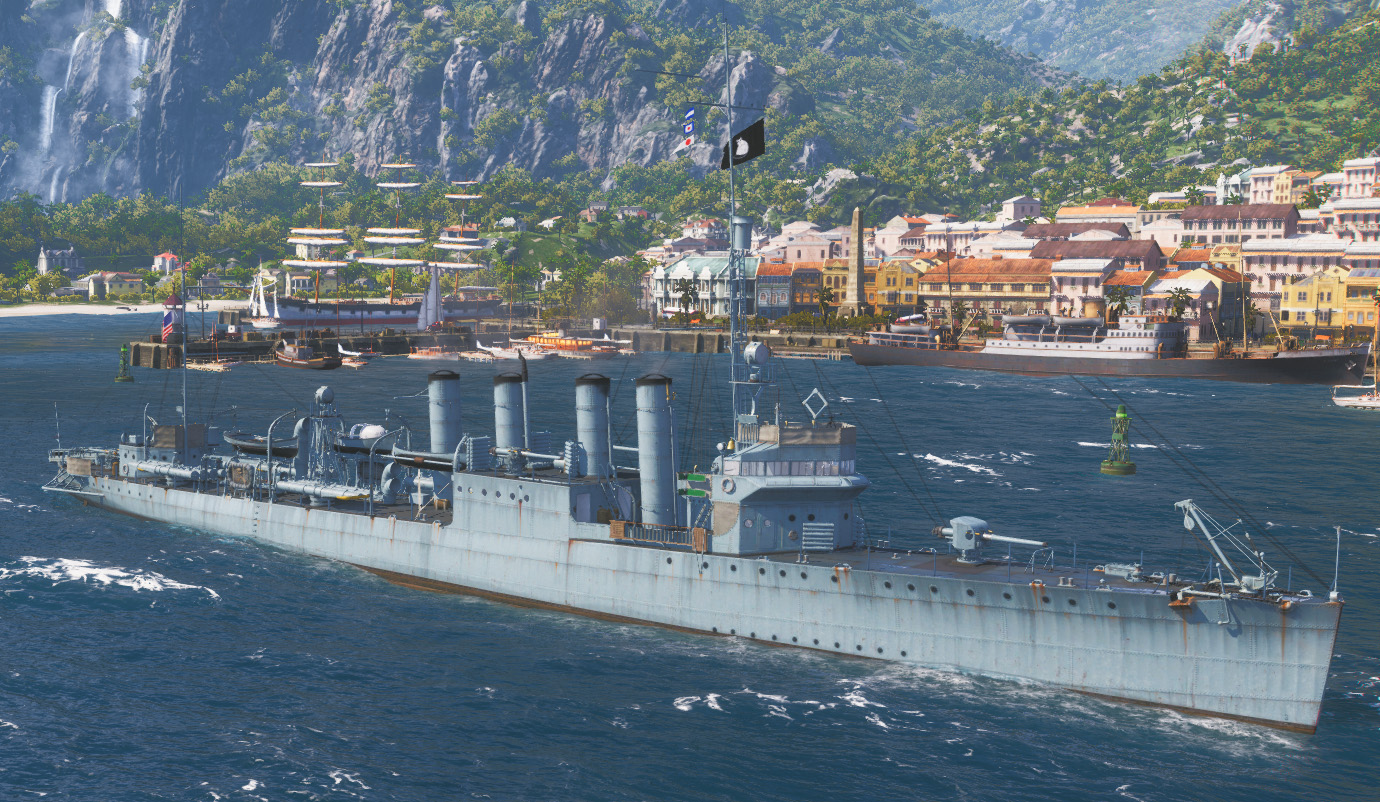
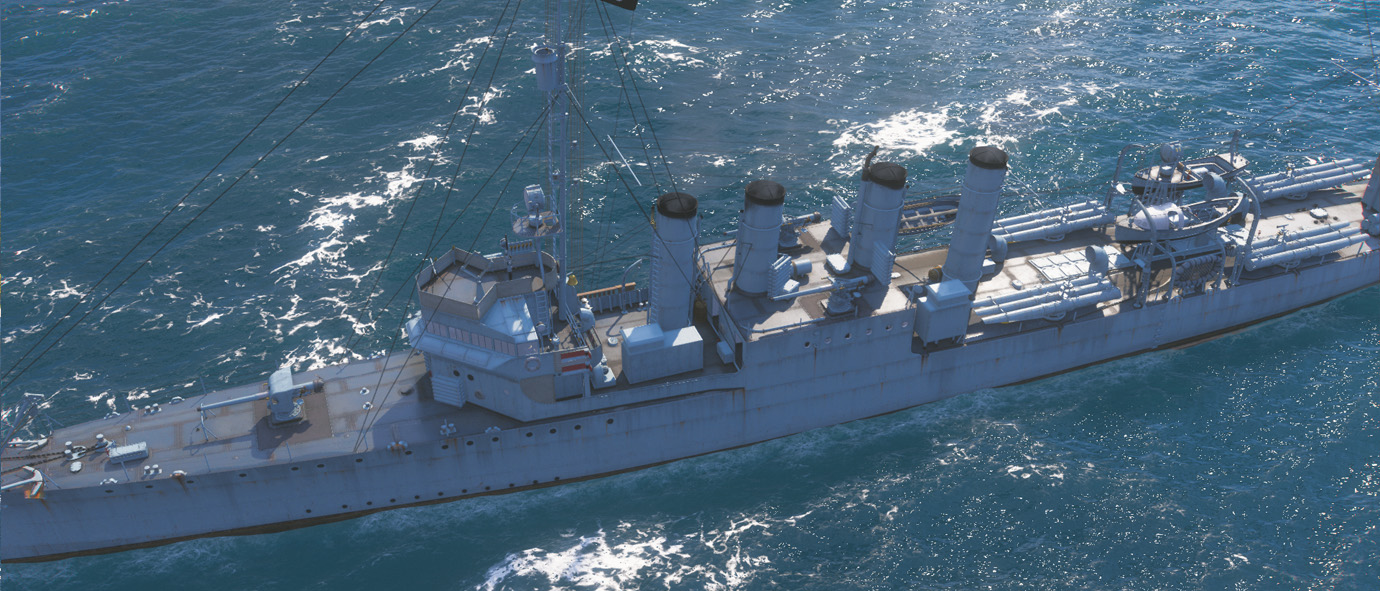
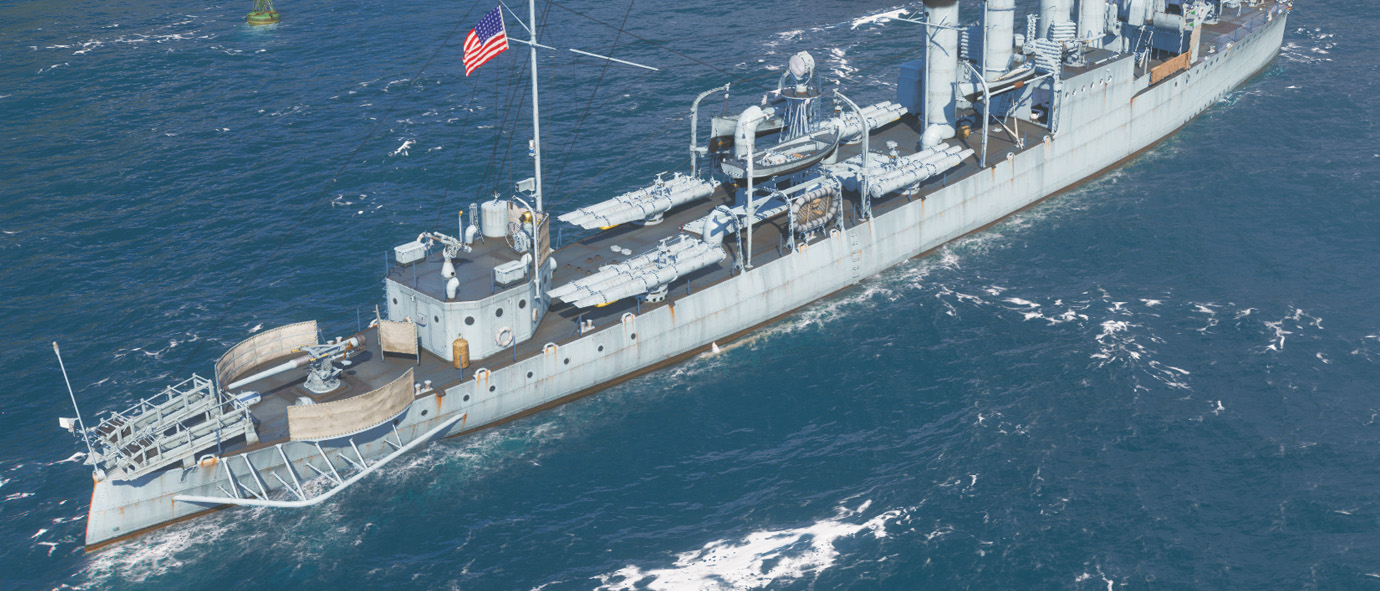
Full view, WoW 3d rendition of the ship (in Cavite). Details, overall view, amidships and stern view.
Armament
The Main armament was a repeat of the Wickes class, itself one of the Caldwell scheme: Four 4-inch (102 mm)/50, and twelve 21-inch (533 mm) torpedo tubes in four triple banks, still in 1918-19 the largest largest torpedo load of any destroyer. Gun armament formed a lozenge pattern: One at the bow, one at the stern, two on a bandstand amidship. The triple torpedo tubes banks were staggered and placed broadside. The placement was still to avoid a captain “spending” all his torpedoes at once but at the time the feature was reconducted without a thought. It was not the priority and the fleet commanders had their close-in defensive torpedo array.
Main Guns
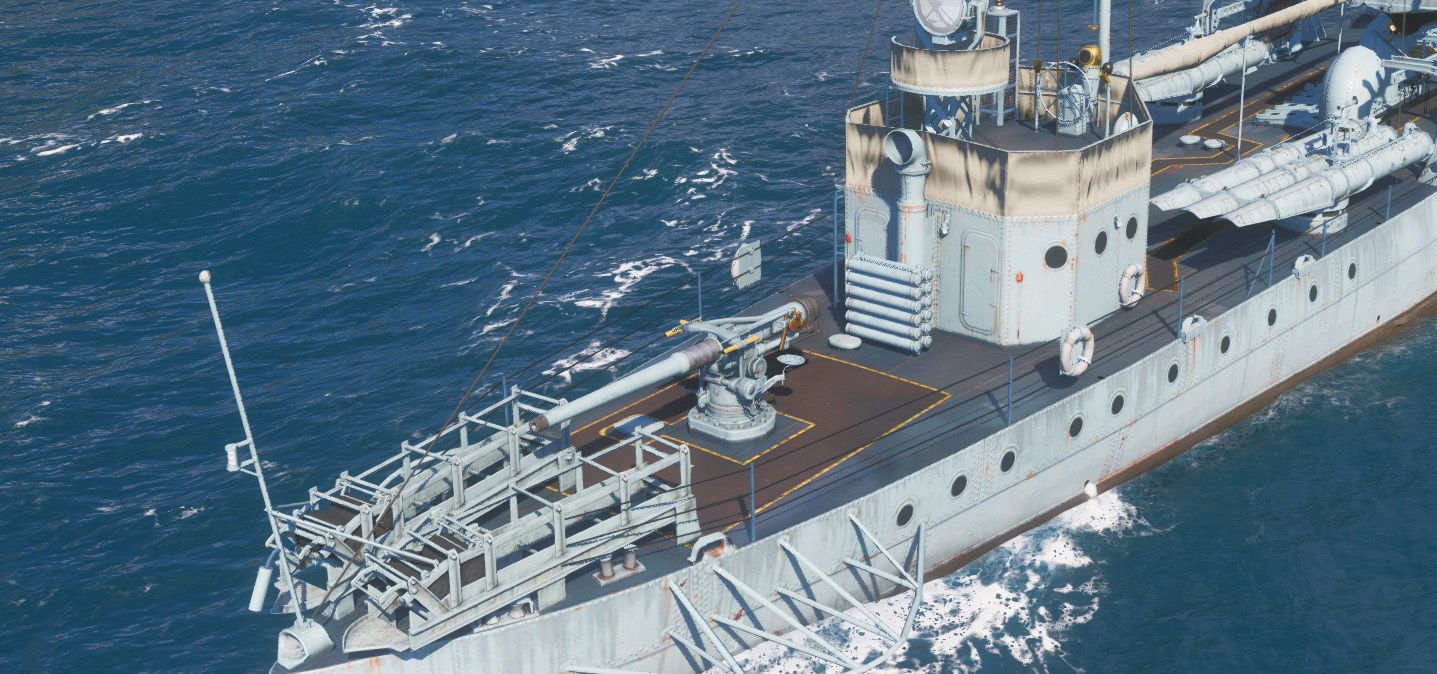
close view of the main aft gun, showing also the stern depth charge racks. Note the 12 read-rounds stored just behind (WoW)
The 4-inch (102 mm)/50 Mark 9 guns of the Clemsons were the same reliable model from the Caldwell and before, placed in a way to cover all angles, and with the advantage of having two of these guns amidships placed high enough so to have a bit less restriction in arc, while being out of reeach of sea spray, a common issue of previous forecastle destroyers since the Smith class ten years prior.
Specs: Mount/Barrel Weight 6,100 pounds (2,800 kg), 33-pound (15 kg) armor-piercing shells (2,900 feet per second or 880 m/s) range 15,920 yards (14,560 m) at 20°.
Just like for the Wickes class, the “nose-heavy” flush deck saw the fore gun always “wet” in heavy weather, something usual in the Atlantic. But at least it had a shield to protect at minima the gun crews. This was not the case for the aft gun, and rarely also for the bandstand gun.
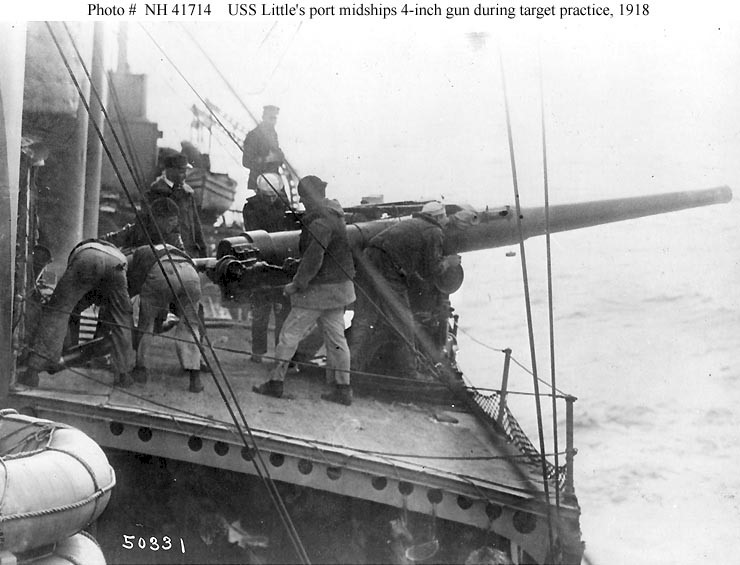
Banstand gun, USS Little (navsource)
More on navweaps.com
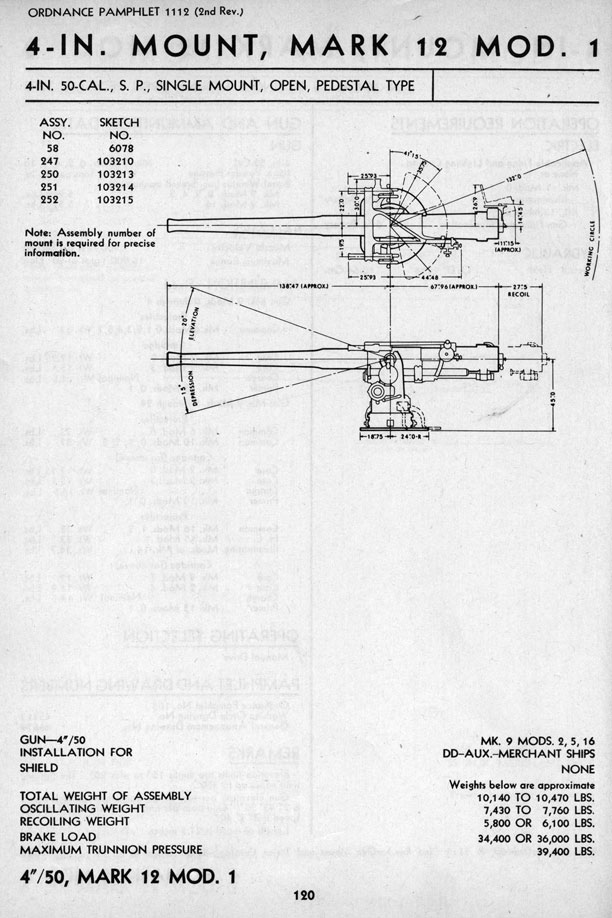
4-in/50 Mark 9 single mount official file
The 5-in guns Clemsons

5-in/51 gun on a transport in 1942. It was twice as heavy as a 4-in.
Since the Clemsons were intended to serve alongide the Wickes class in the Atlantic, news and intel in 1918 were coming from the British Admiraty about the new capabilities of German submarines. Worrysome in particular was the knowledge of the use of the U 151 class and in general a new range of German “U-Kreuzer” armed with 15 cm guns on deck, two. In case of a surface duel with any USN destroyer, this meant the latter was able to outrange and outmatch them. Rather than completely rework the design it was decided to reinforced the hull’s bracing, strengthened gun foundations to swap a 5-in/51 guns in the former 4-in guns positions.
It seems that only five ships were so modified: DD 231 to 235 or USS Hatfield, Brooks, Gilmer, Fox and Kane, all built by Union Iron Wks in San Francisco. The mark is no clear. All these ships were latter scrapped, after being decommissioned as part of the London treaty limitations. The ship only saw service in the interwar so it’s hard to tell what impact they could have in WW2.
Two facts however:
-The new guns weighted Mark 7: 11,274 lb (5,114 kg), which was 5,900 lb (2,700 kg) for the 4-in/50 Mark 9. This was almost twice as much, and caused undoubtely stability concerns, as they keep also their torpedo tubes and ammunitions weighted more than previously.
-The single gun system “consumed” less crew than the twin 4-in/50 adpoted for two ships, making deck operations easier.
The twin-gun armed Clemsons
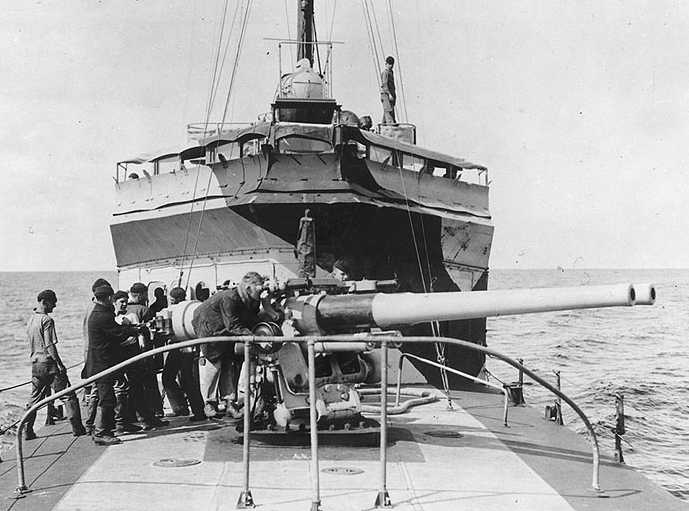
USS Stockton showing her unique forward twin 4-in/50 Mark 9 mount.
One interesting fact however was about the attempt by the Navy to boost this firepower. After having dropped the idea of installing a 5-inches gun not to delay production (due to the rework of ammunition supply), it was though instead of creating a twin mount taking a little space and weight as possible. On paper with eight guns, the Clemsons would have been (in complement to their torpedo armament), truly the most powerfully armed destroyers for decades.
In fact it was acted to add extra storage for future addition of rounds and the new Clemson class had strengthened gun foundations for this upgrade. But the plan to rearm this way all the destroyers was never acted. For a good reason. The twin gun mount developed by the Navy bureau of ordnance was largely experimental. It was the Mark 14, weighted 9.41 tons (9.56 mt) versus 4.53 to 5.63 tons on the single Mk.12. Almost double. This was not a case of “they did it again” when the ordnance managed to create a new triple torpedo tube mount barely heavier than a twin. This time there was no parade to the multiplication of a system that was already very heavy with two barrels and their recoil system and loading apparatus. The only part that could be played with was minor. So from the start there was a weight issue (top weight) detrimental to stability, and the problem of having a gun crew managing two barrels (in addition to having both barrels close together, dispersion and cooling issues).
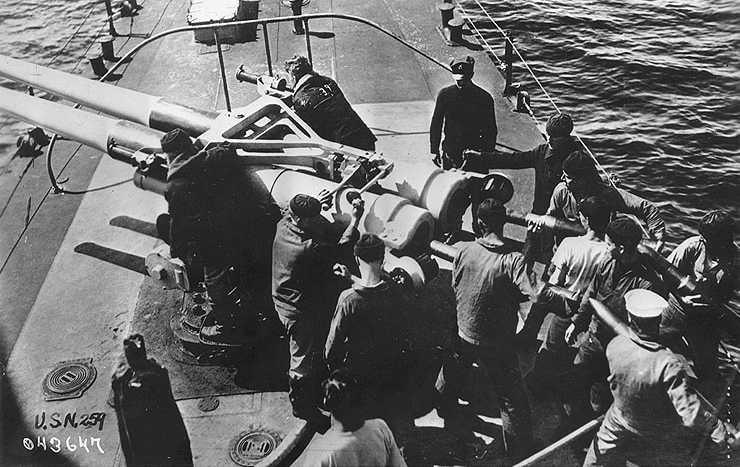
The same Mark 9 on USS Stockton in action, note the plethoric crew in such a cramped space. USS Hovey and Long had hinged sponsons added around the bow mounting to at least add some working space. U.S. Naval Historical Center Photograph # NH 99599
In the end it was installed only on USS Stockton DD-73 (single forward) of the Caldwell class, as well as on USS Hovey DD-208 (four mounts) and Long DD-209 (same) of the Clemson class.
Why it was not adopted ?
To this day it’s unclear, but probably the complication of having two guns to manage instead of one, with altered cycles of loading and firing to avoid interference, larger gun crew to house in an already cramped ship and organization. The idea was simply complicated in practice and the end of the war did not made things easier. This was not the end for twin mounts on destroyers, far from it. In fact the USN brough back the idea with their first interwar “destroyer leaders”, the Porter class, which had four twin shielded mounts. But the Clemsons were dedidedly way too narrow for effectively use twin mounts.
Torpedoes
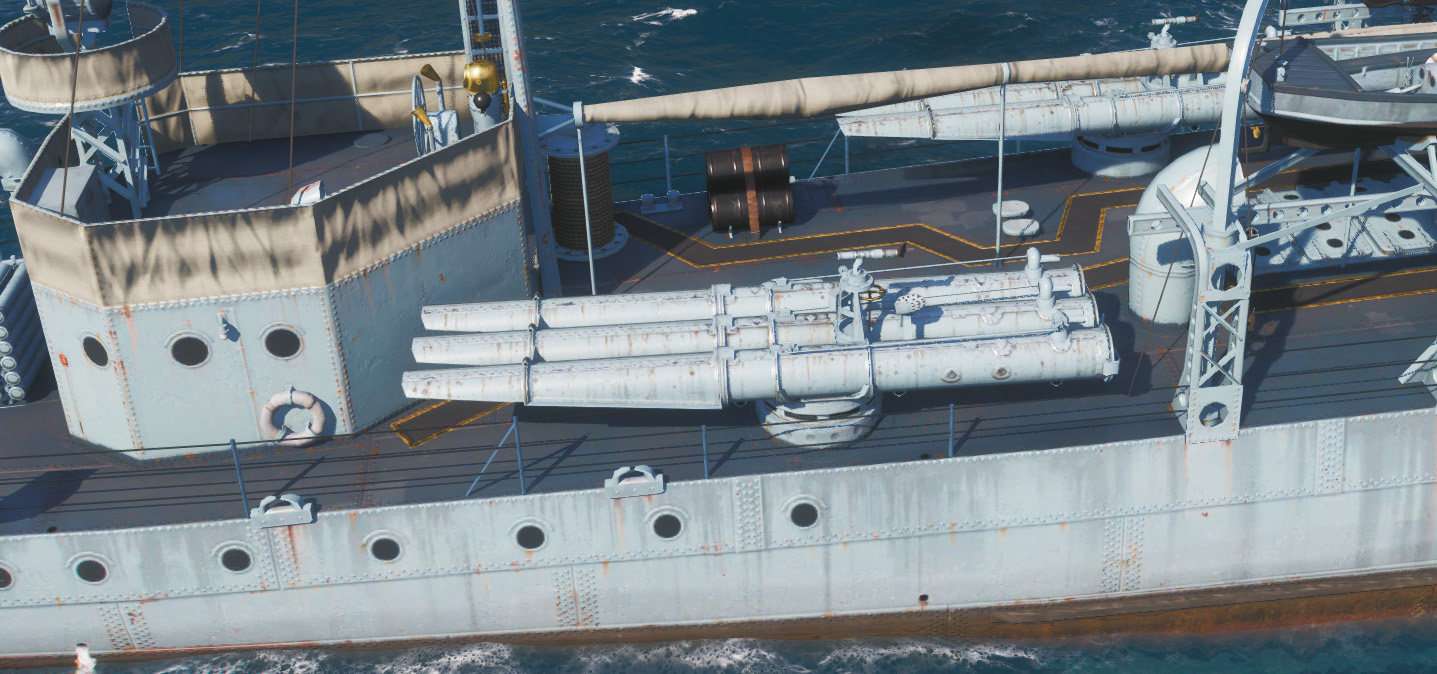
Close view of the aftmost port bank on a Wickes class. The staggerred configuration was not changed from the Wickes to the Clemsons.
Thes staggered triple torpedo tubes banks were located close to the forecastle, further aft amidships, between the aft funnels and the last close to the quartedeck house. They fired the very same Bliss-leavitt 21-inches Mark 8 Torpedoes (1915) in large scale production. There was no reloads. In WW2 two banks were often removed to fre space and weight for additional AA.
Characteristics:
The Mod 2A torpedo was adopted in 1918-21: 2,761 lbs. (1,252 kg), 248 in (6.299 m) in lenght with a 321 lbs. (146 kg) TNT charge. Two range settings, at 10,000 and 12,500 yards (9,140 or 11,430 m) at 27 knots. The system rested on a Wet-heater propulsion, guided by a simple Mark 8 Mod 1 gyrometer.
AA guns: Two 2-in (1-pdr) Mk.7
Introduced on the Sampson class, repeated on the Caldwell and on the Wickes, a single 3-in/23 anti-aircraft gun was installed (instead of two 2-pdr Maxim-Nordenfelt 37 mm 1-pounder Mark 6/7 type) at first. On the Clemsons, the new dual purpose 3 in (76 mm)/23 was still placed on the forecastle behind the main gun but another was added to the quarterck house aft. However it was not automatically fitted. Many ships lacked the aft gun due to shortages.
Specs:
Automatic fire with recoil, ~300 rpm cyclic, belt-fed, mv 1,800 ft/s (550 m/s) range c4,000 yards.
In the 1930s two Browning 12.7mm/90 HMGs were added for close AA defence.
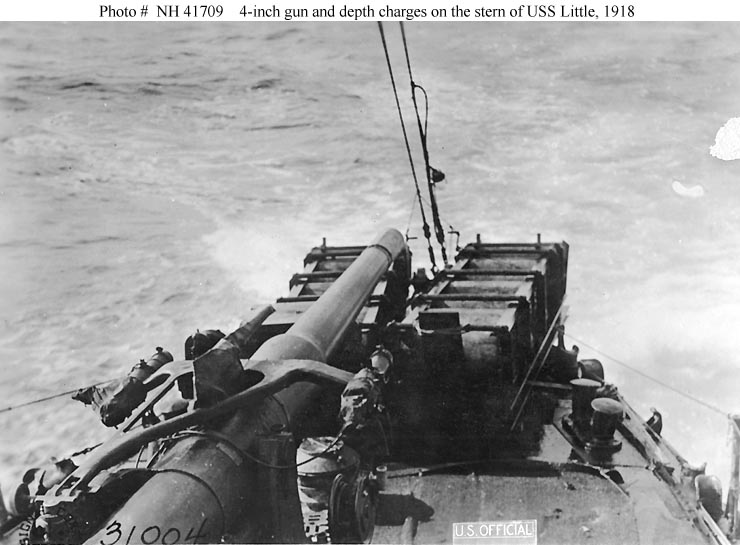
Anti-submarine (ASW) armament: Two depth charge tracks aft, one Y-gun depth charge projector forward of the aft deckhouse. On all ships it remained the same: One DCT (Y-Gun), 2 DCR (Racks) with 15 depht charges, far less than the 50 expected (and six DCTs) in the previous original ASW design variation. Ironically in WW2 many of these ships eventually will adopt that exact same conversion design.
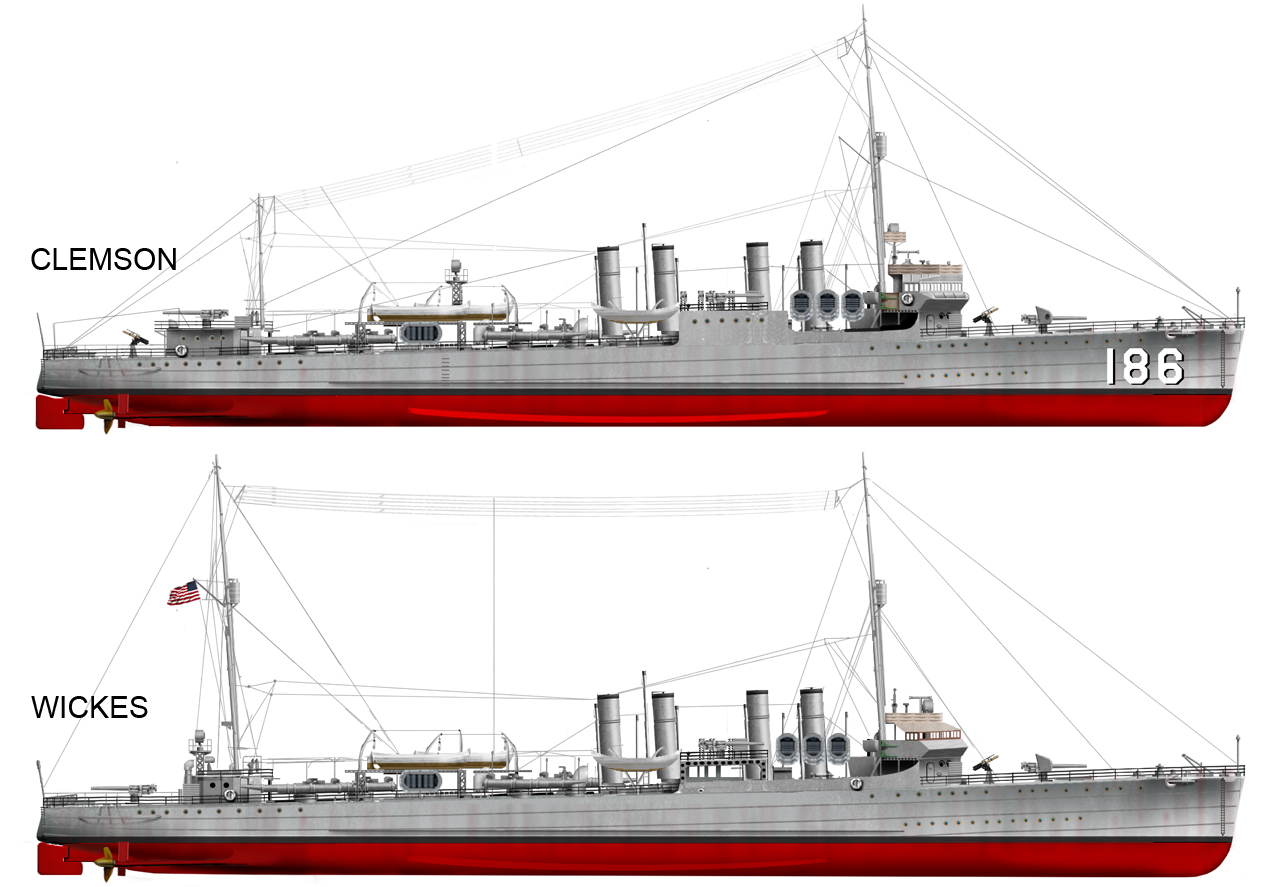
Comparison between the Wickes and Clemson class
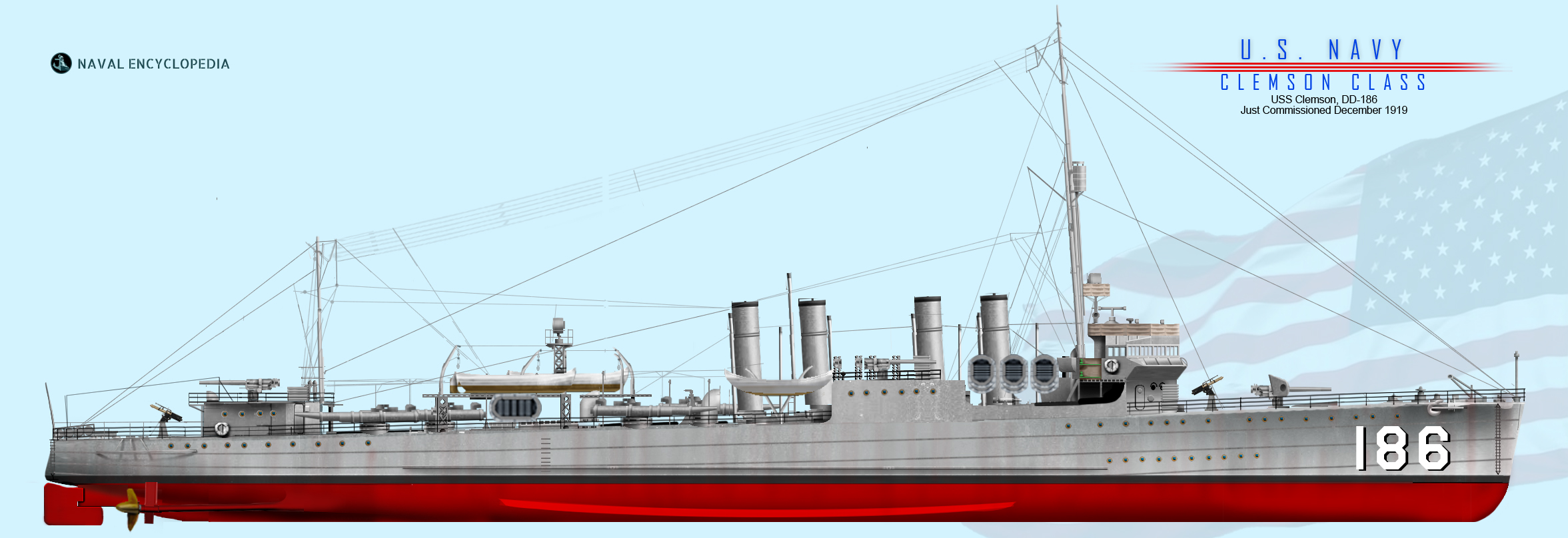
USS Clemson, DD-186, as completed in December 1919
More Profiles to come !!!
⚙ specifications |
|
| Displacement | 1,154 tons (normal), 1,247 tons (full load) |
| Dimensions | 314 ft 4.5 in x 30 ft 11.25 in x 9 ft (95.82 x 9.43 x 2.74 m) |
| Propulsion | 2 shafts Parsons GST, 4 boilers @300 psi (2,100 kPa), 24,610 hp (18,350 kW) |
| Speed | 35.3 kn (65.4 km/h; 40.6 mph) |
| Range | 225 tons oil, 3800 nm @ 15 kts |
| Armament | 4× 4 in/50, 1× 3 in/23 AA, 4×3 21 in TTs, 2x DCT, 2x DCR, see notes |
| Sensors (ww2) | SC radar 1940+, see notes |
| Crew | 100 officers and enlisted men |
Construction
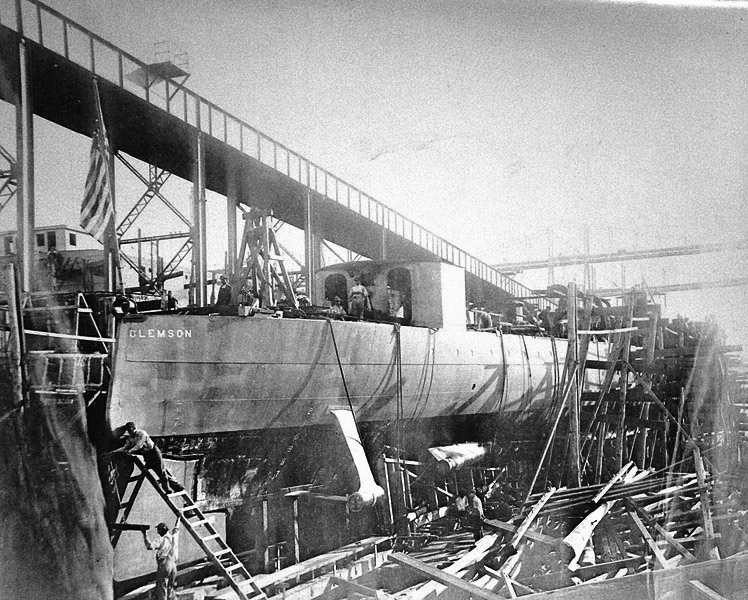
Launch of USS Clemson at Newport News in Virginia, September, 5, 1918. The was not over yet, raging for two more months. He completion in 1919 ensured none of the class saw action in the war.
Construction, like for the Wickes class, was an unprecedented effort for any American warship, undertaken by ten different Yards, and so there was considerable variation in boilers and turbines types, while based on admiralty plans. This led to some discrepancies in power and range. Again, the same yards responsible for the previous series were tasked of the Clemson class, which siplofied things as modifications were minor: New oile tanks, some inetrnal rearranged sections and a larger rudder essentially.
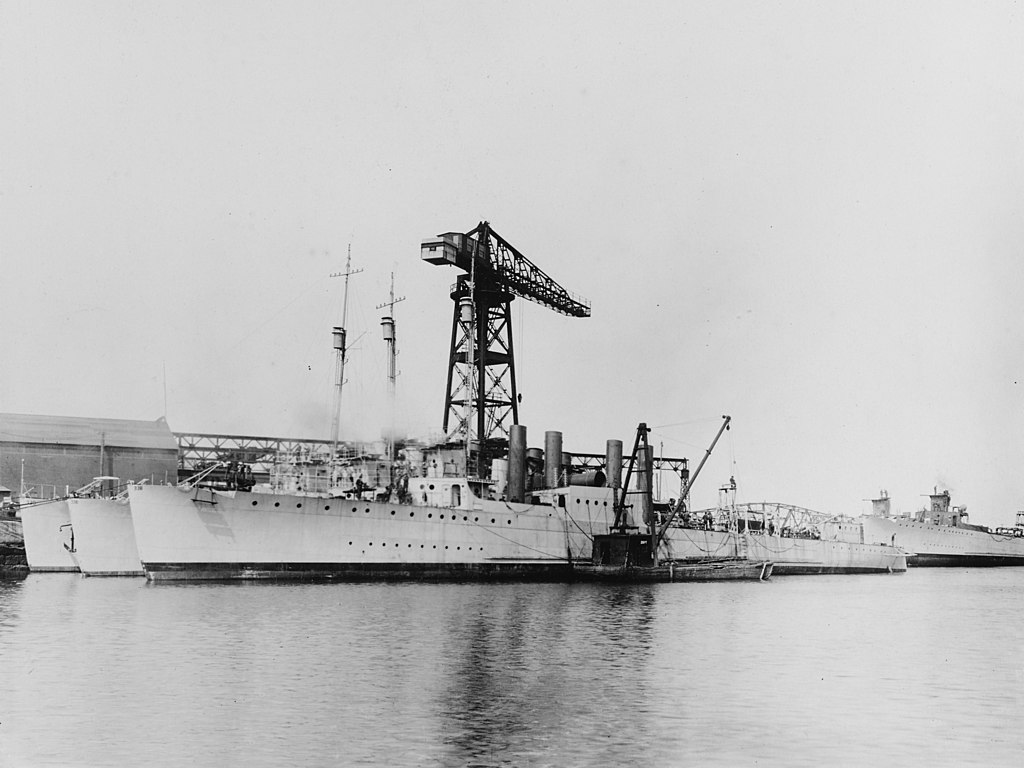
Destroyers fitting out at Fore River Shipyard 7 June 1919.
These yards were:
-Bath Iron Works (Maine)
-Bethlehem Steel Corporation’s Fore River Shipbuilding Company
-Union Iron Works
-Mare Island Navy Yard
-Newport News Shipbuilding
-New York Shipbuilding
-William Cramp & Sons.
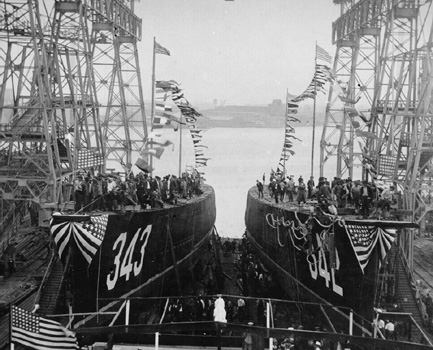
USS Noa and Hulbert (DD-343-342) before launch at Norfolk NyD, 1919.
They produced a grand total of 267 destroyers of a very similar general design. It was so important given the Battle of the Atlantic, that other projects were delayed such as the Omaha class and the Lexington class Battlecruisers, South Dakota class battleships.
The first Clemson-class ship was launched on September 1918, too late to be completed before V-Day.
The program was still ongoing by November 1918 and was not cancelled. A large proportion of the Clemsons were not only launched, but even started after the armistice, albeit an additional six ships based on the initial order were cancelled, these were the DD-200 to DD-205. This is simply amazing that construction went on long after the war has ended, like the ships built at Vallejo in California, which were completed in August 1922. Indeed the naval treaty of Washington was already in discussions since February. The very same ships, DD339-341 were started in August 1919 and September 1920 indeed. It is likely they were suspended for a time, pending decision. The first was launched on 15.9.1920 and the other two on 29.10.1921.
Reasons to keep production ongoing
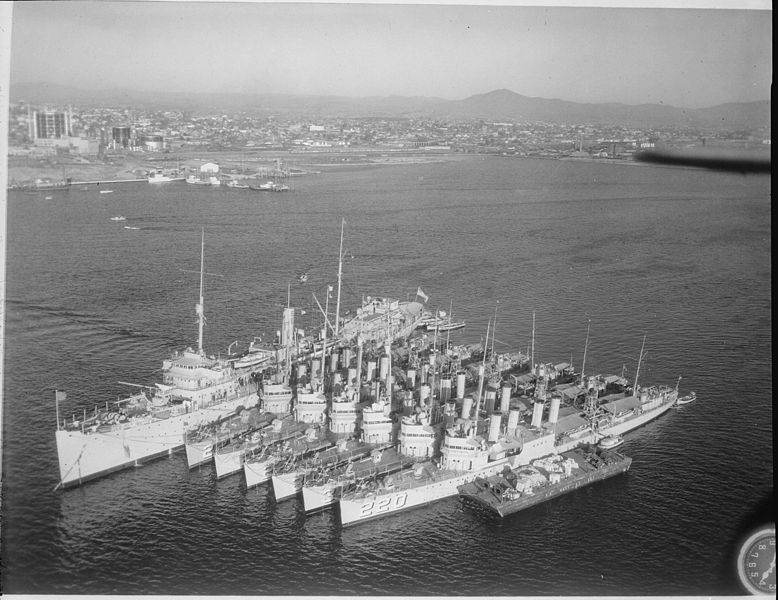
Six Clemson class DDs with USS Melville (AD-2), destroyer tender, in Oct. 1932
-Completing ships started before November 1918, rather to have them scrapped (a good portion, DD186 to DD199 were started before and during November).
-Maintaining orders for the Yards. It was decided to delay the Omaha class cruiser, cancel the six 43,200 South Dakota class (BB-49 to 54) and suspend indefinitely the Lexington class which would have keep the workers busy until 1922. But there were far higher costs and greater technical challenges compared to the destroyers.
-Social reasons: Congress members wanted to maintain jobs in their circumscriptions where the Yards and their suppliers were located until 1922 notably in a context of veterans returning from Europe and which needed jobs as well.
The Navy at that stage in early 1919 wa spreoccupied by that decision. There was little time to correctly assess the new flush deck concept associated with the Caldwell class design, let alone the significantly larger and redesigned Wickes-Clemsons. The war proved an overriding accelerator. Everything was compromise for the goal of winning the battle of the atlantic. Thus, the end of the war made this massive fleet unjustified.
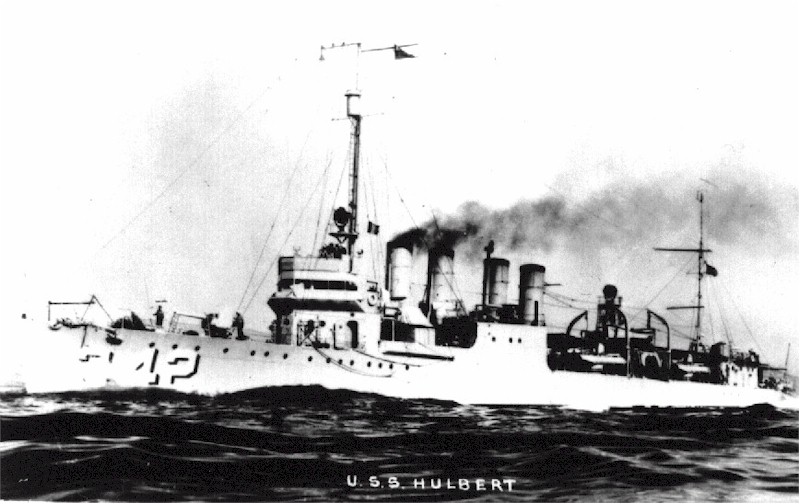
USS Hulbert underway in the 1930s
The naval staff saw the continuation of the production for three more years knowing that this mass far outweighted its needs peacetime needs. Ironically, the compromises (no “pure ASW” ship built) meant the new destroyers maintained intact their fleet combat caracteristics. So as designed they can still cover fleet escort tasks, and compensate for the lack of modern destroyers: The last were the Chester class dating back 1907, which were at least fast, but 1890s generations were much too slow and on their way to the scrapyard, while the new Omaha class were delayed. Each were supposed to lead ten destroyers, so 100 out of 267 were supposed to take on fleet screening and vanguard duties, while the remainder could escort more closely the battleships. The USN at that stage had still 22 dreadnoughts. The old pre-dreadnoughts were likely to join the scrapyard, so at an average of 4 destroyer (a squadron) for each battleship, that made for 88 of these, meaning 188 for the fleet, leaving 79 without assignation. Giving the fact half of these would be fleet destroyers in refit an any given time, that left still around 40 without any duty.
Solutions emerged however. Some were placed already in reduced commission, in mothballs, starting with the ones which already served a few years, many were passed to the coast guard during the prohibition (see later), and there were already some conversions proposals, but they were not applied for budgetary reasons.
Other events emerged, notably the loss of 7 ships at once during the interwar “Honda Point Disaster” (see later). There were also decommissions and scrapping of many ships.
On that chapter, the Navy had a principle for “taxpayer money value” to keep commissioned any ship at least ten years, including refit periods. This was the case for those discarded from 1930 to 1937:
The London Naval Treaty forced to retire a number of destroyers due to cotas. The USN chose to scrap about 40 Clemson-class destroyers fitted with Yarrow boilers as these boilers wore out quickly in service.
DD276-DD295, DD298-301, DD303-315, DD317-326, DD328, DD330-335 were stricken in 1930 (less the ones lost during the Honda Point incident)
DD262 USS McDermut was stricken on 11.1931 as DD-327 and 329.
DD302 Stoddert was stricken in 1935
DD271 (Morris) and DD272 (Tingey) and DD275 (Sinclair) were stricken 5.1936
DD238 James K. Paulding was stricken in 1.1937
That “cleared out” a large portion of the class.
In 1940 things started to change. Now with a better budget it was decided to convert 27 ships as minelayers, minesweepers and seaplane tenders. 25 more were sent in lend-lease to the British Royal Navy.
General Assessment of the Clemson class

Six Clemson class with destroyer tender USS Dobbin (AD-3) with its destroyers off Ganives, Haiti March 1928
In an attempt to solve the endurance problem, these ships were provided with about 35 per cent more fuel endurance than the Wickes class, so that even the worst of them would equal the best of the earlier ships. Another modification was that the second 3in/23 was moved from a position between the funnels to the after deckhouse. Later this gun was moved to the quarterdeck, the after 4in being moved up, and in many cases it was dispensed with. A similar modification was approved for the Wickes class in 1919.
While these ships were being designed, the Germans were reportedly moun ting 5.9in guns on their large submarines; the new destroyers were given gun foundations strong enough to take 5in/51 guns, as a counter. Only 5 ships were so fitted (DD 231-235, but retained their original guns it seems). In addition, DD 208 and 209 had 8-4in/50 in four twin mount mounts.
They were were generally seemed more satisfactory over the Wickes class, due to the added range and better rudder which improved their agility. However they would suffer from the same shortcomings of still relatively limited Endurance despite having 100 tons (35%) greater fuel capacity and were barely able to cross the Atlantic, alleviated by the development of underway replenishment, or RAS (Resplenishment at Sea), still in its infancy but tried out in 1917. The lack of overall agility was also still there, and of course the issue of the main forward gun being always wet, water sprayed in even moderate seas, was an issue never resolved but by a return to the forecastle formula of the new Farraguts in 1934. Although their hull was stronger than previous “flivvers” up to the Caldwell class, they stayed relatively narrow and had stability issue, even more than the previous Wickes due to the additional oil tanks over the waterline. This limited upgrades, and in fact, weapons were removed in WW2 while great caution was paid to the way oil was distributed (captains were instructed to empty “wing tanks” first).
Interwar Service and Modifications
Interwar service

For the anecdote, USS Thornton saved the Mexican port of Manzanillo from bandits on 14 May 1920. The Honda point incident where seven ships were lost caused quite a stir at the time: The Honda Point disaster was the largest peacetime loss of U.S. Navy ships, which happened in the evening of September 8, 1923. Seven destroyers where traveling at 20 knots (37 km/h) in the fog, and after a navigation error ran aground at Honda Point. The latter was also known as Point Pedernales, near the Devil’s Jaw cliffs. It happened a few miles from the northern side of the Santa Barbara Channel and off Point Arguello (Gaviota Coast, Santa Barbara County) in California. Two more ships grounded (so nine in all, a full division) but were able to maneuver free off the rocks. Although the grounding by itself was not a fatal event, the state of the sea that day was another reason why twenty-three sailors died in this disaster.
It was a stark remainder of a navigation hazard already well known by ancient spanish navigators that clearly showed it in their maps and named it as the “”
As established by the later court martial, fourteen Clemson-class destroyers (Destroyer Squadron Eleven) were led by flagship USS Delphy in column formation from San Francisco Bay bound to San Diego in a 24-hour exercise along the California coast and the flagship provided navigation.
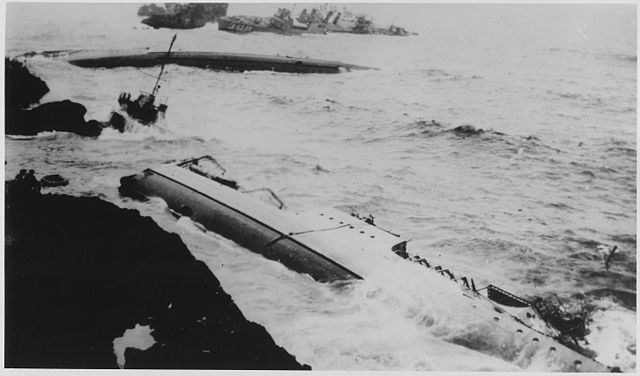
Delphy steamed along the coastline in poor visibility forcing navigator LCdr. Hunter to use the old technique of dead reckoning, estimating position based on speed and heading. Lieutenant (junior grade) Lawrence Blodgett was able to override the navigator’s statements though. USS Delphy had a radio direction finding (RDF) equipment at the timen which can communicated with the station at Point Arguello. However this was a new technology and its bearings were dismissed by the navigator as unreliable. Captain Watson ordered the fleet to turn east into the Santa Barbara Channel based on an assumption of being several miles northeast of their real position and this caused the ships to run aground on Honda Point.
Fortunately radio bearings to the Delphy and Stoddert allowed the staiton to accurately determined the fleet’s position and many ships were dispatched to help eventually. Bu the ships, tossed on the rocks without mercy in this heavy weather, ultimately became total constructive losses, and written off. The hulks stayed there to rot for some time due to the difficulty of working in this remote area. The court martial heard the Navigator’s arguments of inexpectedly changing current after the Great Kantō earthquake, which caused many USN ships navigational errors the past days. There had been also RDF errors. It seems DesRon 11 when going though these swells and currents, estimations of speed and bearing used for dead reckoning became more and more unreliable, unbeknowst to the navigator. And as all catastrophy it could not have happened at a worst time and place, just at the treacherous coastline of Honda Point.
The court assigned blame to the captain of each ship that ran aground with 11 officers involved brought on the charges of negligence and culpable inefficiency (largest court-martial in the U.S. Navy’s history). It ruled that the events were “directly attributable to bad errors and faulty navigation” by Captain Watson, which was stripped of his seniority, three other officers admonished.
But they were all acquitted, much to the chagrin of the families of the sailors killed that day.
Captain Watson was commended by his peers and the government by assuming full responsibility.
The event had a lasting effect on the USN’s navigational procedures, and never again such accident will happen, but only rare individual ship’s losses.
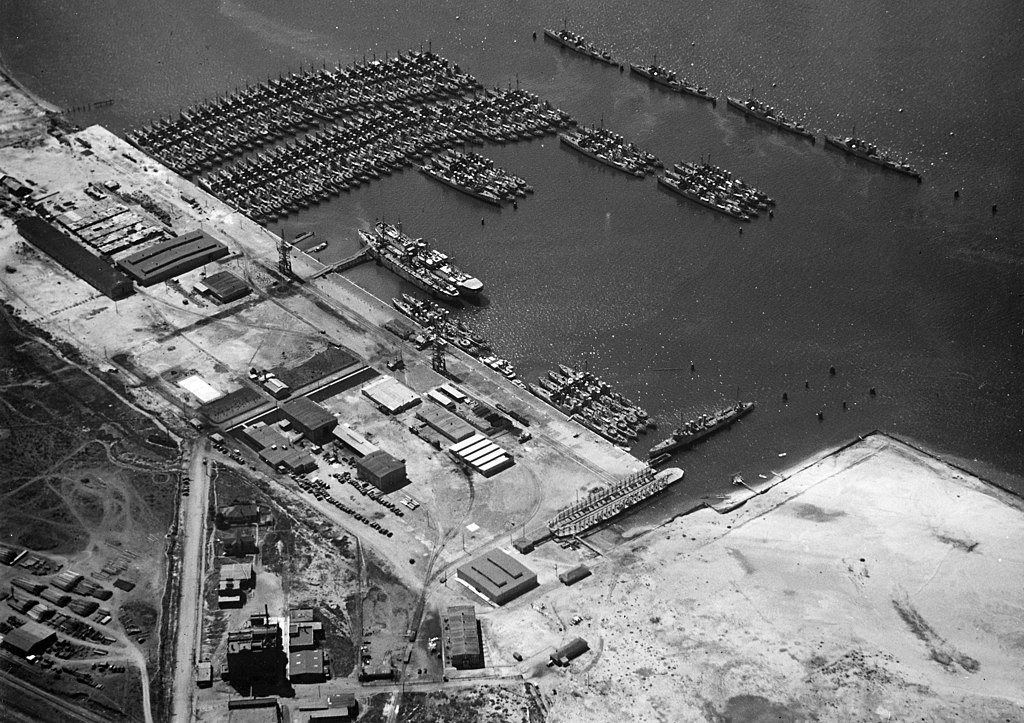
Circa 77 laid-up U.S. Navy Clemson and Wickes-class destroyers on the U.S. West Coast, on 10 September 1924. Identifiable are USS Hazelwood (DD-107), USS Dent (DD-116), and USS Alden (DD-211), and the destroyer tenders USS Buffalo (AD-8), inboard, and USS Prairie (AD-5). The photo was archived by the 11th Naval District, San Diego, California where 77 destroyers were decommissioned in 1924.
Conversions 1940-42
This section is independent to the APD conversion.
Minelayers (4):
In the late 1930s, the ones that were still in service had either one of two 76mm/23 Mk XIV AA guns and one extra 76/23 Mk XIV, two 12.7mm/90 Browning M2HB AA HMGs and from 1937 USS Tracy, Preble, Sicard, Pruitt were retired all their TT banks and ASW depht charge racks after for rails and 80 mines, becoming fast minelayers for the USN.
Seaplane Tenders (14):
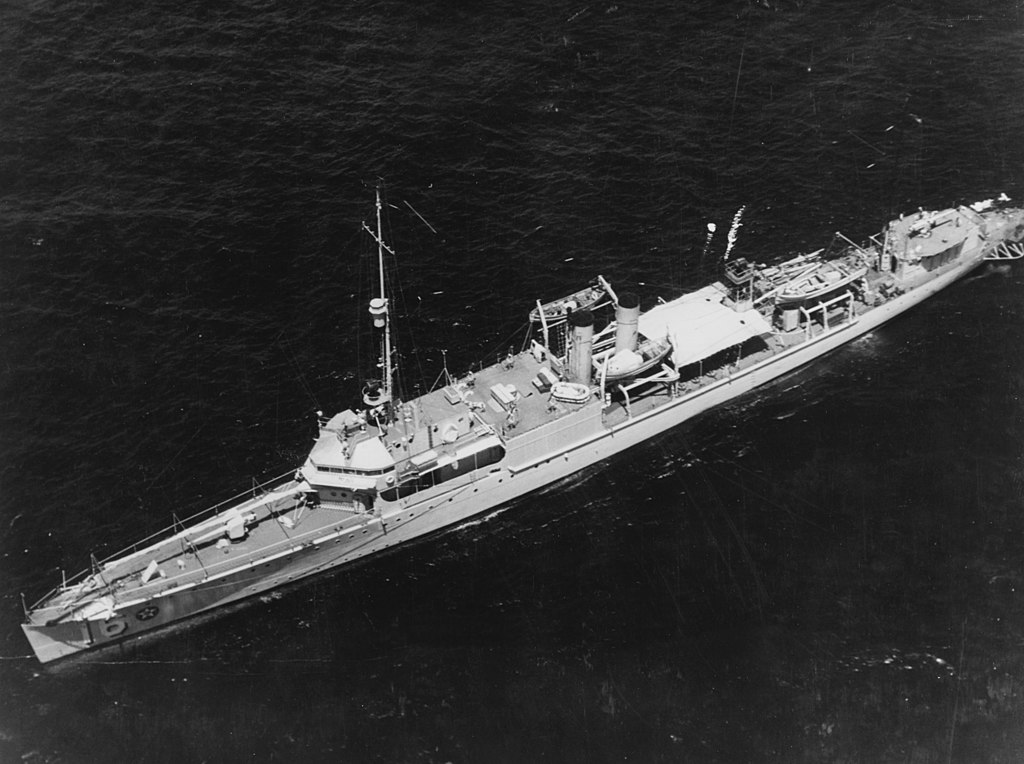
USS G.E. Badger in 1939 as AVP-16
In 1938, USS Childs, Williamson and by 1939 USS Clemson, Goldsborough, George E. Badger, Hulbert and William B. Preston, in 1940 USS McFarland, Belknap, Osmond Ingram, Gillis, Greene, Ballard, Thornton were all converted to seaplane tenders:
They had 2 boilers and corresponding funnels removed, their displacement was now 1,202 tons standard, 1,699tons full load, 12,500-13,500 hp, 25kt top speed, 429t of oil for additional range, 101 crew, armed with two 102mm/50 Mk 9 guns and four 12.7mm/90 AA HMGs and equipment to support an air squadron of 12 patrol bombers such as PBY and tanks containing 113,550 liters avgas (aviation petrol).
USS Childs and Williamson were experimental conversions in 1938, the first truly dedicated seaplane tenders (destroyers) in the USN, a good way to keep active the flush deckers in the Navy, while sparing destoyer crews for more modern ships. Conversion work comprised the following:
-All torpedo gear removed
-Two 4-inch guns removed
-3-inch antiaircraft gun removed
-Depth charge tracks removed
-Forward two boilers and funnels removed.
-Additional deckhouse space added forward.
-Internal arrangements changed to accommodate personnel for 12 seaplanes or ‘patrol plane’ (VP) squadron
-Addition of a supply tank of aviation gasoline.
-Boat derrick added to the existing searchlight tower structure for 2x 30-foot motor launches. The latter were used for tending seaplanes while in the water.
-Forward and aft 4-inch guns maintained
-Four .50-caliber HMGs added for close antiaircraft defense.
-Painted pale gray, wearing the hull number and displayed the typical USN aviation roundel, red-centered blue and white star forward.
1940-1942 she ships still active in these roles received a QCJ or QCL sonar for more effective ASW operations.
USS Noa (seaplane carrier):
In 1940 USS Noa had two triple 533mm/21-in Torpedo tubes banks removed and carried a XSOC-1 seaplane nested just forward of the after deckhouse and replacing the after torpedo tubes. A boom for lifting it was stepped in place of the mainmast. She conducted tests to see the viability of the concept, for a short time, perhaps inspired by the Dutch Navy which did for the east indies theater.
Fleet Minesweepers (9)
Also in 1940, USS Chandler, Southard, Hovey, Long, Hopkins, Zane, Wasmuth, Trever, Perry saw the removal of their four 102mm/50, one 76mm/23 AA and all four 533mm TTs plus the DCT (Y-gun). Instead they get four 76mm/50 Mk 20 guns, two 12.7mm/90 AA HMGs and two to four DCT (throwers) as well as a minesweeping gear and one boiler removed for a speed down to 25kts.
AA/ASW escorts (11):
In 1941-1942 some still surviving “stock” destroyers, USS Dallas, Broome, McLeish, Simpson, McCormick, Truxtun, Overton, Sturtevant, Reuben James, Bainbridge, Decatur, were also rearmed in a radical way: Main guns and two TT banks removed, as well as a 3-in/23 AA gun. Six 3-in or 76mm/50 Mk 20 were installed as well as two 12.7mm/90 or cal.50 Browning AA HMGs. They also likel received the QCJ or QCL sonar and obtained a SA or SE radar as Atlantic escorts, likely posted in Britain to be closer to the Luftwaffe. Some served with the Murmansk convoys as well.
⚙ DM/DMS class specifications |
|
| Propulsion | 2 shafts GST, 3 boilers, 20,000 shp |
| Speed | 25 kn (46 kph, 28 mph) |
| Armament | 4× 4-in/50, 80 mines, optional 3-in/23 AA (1930) |
| Armament | 4x 3-in/50 Mk.20, 2-4 DCTs, 2x 0.5-in AA, Minesweeping gear (1940-44) |
The case of Lend-lease ships

USS Chesterfield in 1942
The ships sent in lend-lease generally lost two TT banks and two main guns for additional AA and depht charge throwers, British sonars and radars.
In all, 25 ships were sent to Britain or Canada, gathered at Haifax, Nova Scotia for distribution. In the Royal Navy they were called the “town class” and were not liked by British crews (apart the fact they were better than nothing): Since their use i the north sea and north atlantic was mandatory, they suffered from being wet and damp at all times, and despite theior structural strenght, noisy internally in heavy weather, to the point it was hard to sleep during quatrers. Their age and worn out machinery did not helped, despite their relative reliability. The large part of those scrapped in the 1930s has problematic small tubes boilers.
The range of modifications made however was impressive. The original main guns were often removed (only fore and aft kept), two of the new Vickers 3-in/50 Mk 10 AA guns installed on the bandstands, and from two to six 20mm/70 Oerlikon AA guns also installed, plus longer depht charge racks and additional depht charges throwers, up to eight, four either side aft. The torpedo tubes were removed entirely and British radars were added. In addition the forward superstructure was often rebuilt, made more sturdy and taller to better cope with heavy weather.
The list concerned:
DD190 Satterlee to United Kingdom on 10.1940 as HMS Belmont
DD191 Mason to United Kingdom on 10.1940 as HMS Broadwater
DD193 Abel P. Upshur to United Kingdom on 9.1940 as HMS Clare
DD194 Hunt to United Kingdom on 10.1940 as HMS Broadway
DD195 Welborn C. Wood to United Kingdom on 9.1940 as HMS Chesterfield
DD197 Branch to United Kingdom on 10.1940 as HMS Beverley
DD198 Herndon to United Kingdom on 9.1940 as HMS Churchill
DD252 McCook to Canada on 9.1940 as HCMS St. Croix)
DD253 McCalla to United Kingdom on 10.1940 as HMS Stanley
DD254 Rodgers to United Kingdom on 10.1940 as HMS Sherwood)
DD256 Bancroft to Canada on 9.1940 as HCMS St. Francis)
DD257 Welles to United Kingdom on 9.1940 as HMS Cameron
DD258 Aulick to United Kingdom on 10.1940 as HMS Burnham
DD263 Laub to United Kingdom on 10.1940 as HMS Burwell
DD264 McLanahan to United Kingdom on 10.1940 as HMS Bradford
DD265 Edwards to United Kingdom on 10.1940 as HMS Buxton
DD268 Shubrick to United Kingdom 11.1940 as HMS Ripley
DD269 Bailey to United Kingdom on 11.1940 as HMS Reading
DD273 Swasey to United Kingdom on 11.1940 as HMS Rockingham
DD274 Meade to United Kingdom on 11.1940 as HMS Ramsey
⚙ “Town” class specifications |
|
| Armament | 3× 4 in/50, 1× 3-in/23 AA, 2×3 21 in TTs, 2 DCR, 4-6 DCT initially |
| Armament | 2x 4-in/50, no TTs, 2x 3-in/50 Mk 10, 2-4x 20mm/70 Oerlikon Mk II/IV AA guns, DCT/DCRs. |
| Sensors | Type 271 and type 286 radars |
| Crew | 146 |
The case of HMS Clare
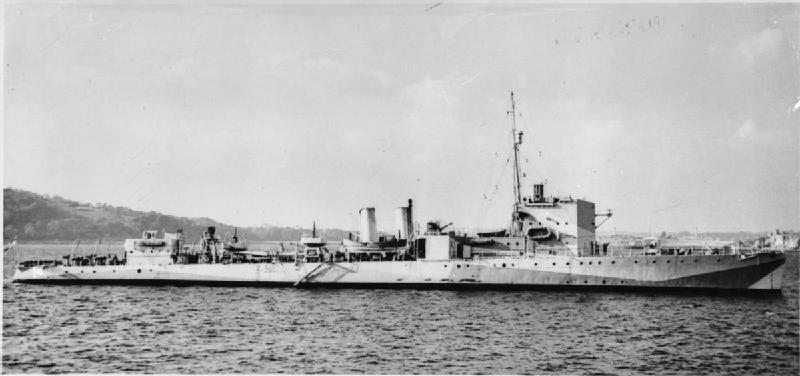
The former USS Abel P. Upshur was decommissioned on 9 September 1940 at Halifax, Nova Scotia, transferred to Britain under the destroyer for bases agreement, struck from the USN from 8 January 1941 and renamed as HMS Clare, assigned to the 1st Town Flotilla in Belfast from 26 September 1940. She joined Escort Group 7, transatlantic convoys. On 20 February 1941 she rescued the crew of SS Rigmor. On 21 February she collided with the motor vessel Petertoum, but damage was light, and repaired at Plymouth, after which between March and October she multiplied missions with Escort Group 41 of the Western Approaches Command. She was heavily modified with her two forward boilers removed and replaced by additional fuel tanks, and endurance enabling the whole Atlantic crossing while preserving her top speed of 25 knots. She one only one 4 in (100 mm)/50 left, three triple torpedo tube mounts for additional depth charge stowage, Hedgehog and rebuilt bridge. She was camouflaged and returned into action by the the fall of 1942. She took part in Operation “Torch” in the Eastern Naval Task Force (Algiers). On 12 November 1942 she detected and attacked a German U-boat off Oran and claimed it. She left Gibraltar for home by 17 November 1942 and returned to transatlantic convoy duty.
In July 1943 she returned to the Med, top take part in Operation Husky, the invasion of Sicily. She had an overall afterwards at Cardiff and was back in action by May 1944 but now used as target ship for aircraft, Western Approaches Command. In August 1945 she was placed into reserve at Greenock, and sold for scrap in 1947 (at Troon, Scotland).
Assault Transport (APD) conversions (1940-44)
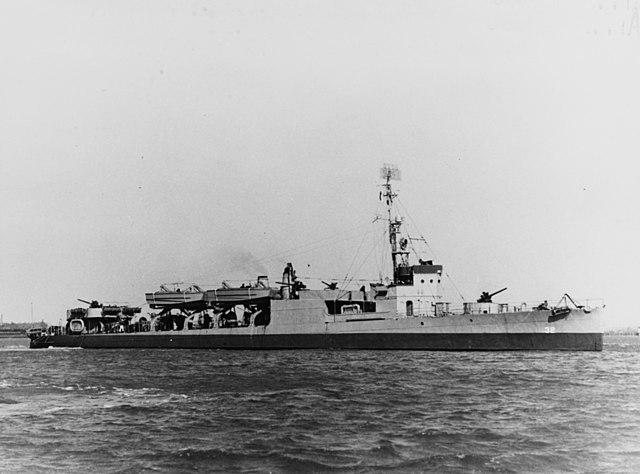
USS Goldsborough as APD-32, off Charleston NyD after conversion in April 1944
Like the Wickes class, a number of Flushdecker were converted (or reconverted from minelayer/minesweeper/seaplane tender duties) as fast assault transports. There will be a dedicated article to cover APDs tech and career, that’s why their career is not seen there. The first group of APDs (APD-1 to APD-36) were converted from the single prototype of the Caldwell-class, and the 17 of the Wickes-class. “Only” 13(14?) Clemson-class were converted:
DD186 USS Clemson, also seaplane tender 11.1939, fast transport APD-31 5.1944
DD188 USS Goldsborough, same, APD-32 3.1944
DD232 USS Brooks, fast transport APD-10 10.1942
DD233 USS Gilmer, Fast transport APD-11 10.1942
DD235 USN Kane fast transport APD18 1.1943
DD236 USS Humphreys fast transport APD12 10.1942
DD239 USS Overton fast transport APD23 8.1943
DD243 USS Sands fast transport APD13 12.1942
DD248 USS Barry fast transport APD29 1.1944
DD251 USS Belknap fast transport APD34 6.1944
DD255 USS Ingram fast transport APD35 6.1944
DD266 USS Greene (ex-Anthony) fast transport APD36 2.1944
DD343 USS Noa fast transport APD24 8.1943
Machinery:
Their two forward boilers were removed (speed down to 25 knots or 46 km/h) to free extra accomodation for 200 troops in the former engine spaces. APD10 – 13, 18, 23, 29, 31-33 were left with two sets Westinghouse geared steam turbines and 2 White-Forster boilers, APD24 with two sets Parsons geared steam turbines and two Normand boilers and APD34-36 two Curtis steam turbines plus a single geared steam turbine for cruising and two Yarrow boilers, despite the fact the latter has been criticized for their poor lifespan.
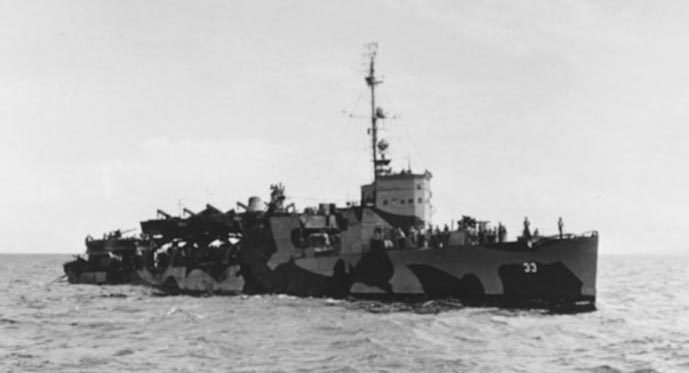
Armament:
The original armament of four 4″/50 low-angle guns and single 3″/23 anti-aircraft gun plus the twelve 21-inch torpedo tubes removed entirely. Instead they were given three modern and lighter 3″/50 dual-purpose guns and a single 40 mm AA gun plus five 20 mm AA guns or more. They still kept ASW capabilities with two depth charge racks and up to six K-gun depth charge throwers and often obtained a sonar. The weight of the main artillery and torpedo tubes was used in install four davit-mounted LCPLs (Landing Craft Personnel, Large), replaced by the bow ramp LCPR (Landing Craft Personnel, Ramped) version. Still, they were less efficient than LCVPs but were used up to 1945 by the USMC anyway.
They operated notably the elite force of the USMC, the Marine Raiders in many engagements, in particular around Guadalcanal.
Due to their sometimes colorful camouflage patterns, made to blend with the surrounding vegertation of the south pacific islands, particularly the Solomons Island chain, they earned the sobriquet of “green dragons”. See below the new specs.
With 144 Marines aboard plus their usual crew of 101, these ships were seen as “crowde” and not very popular. The troops barthing place so close to the machinery was very unpopular, extremely hot and noisy, plus the fear of a torpedo hit. The following conversion from destroyer escorts were better suited in that sense.
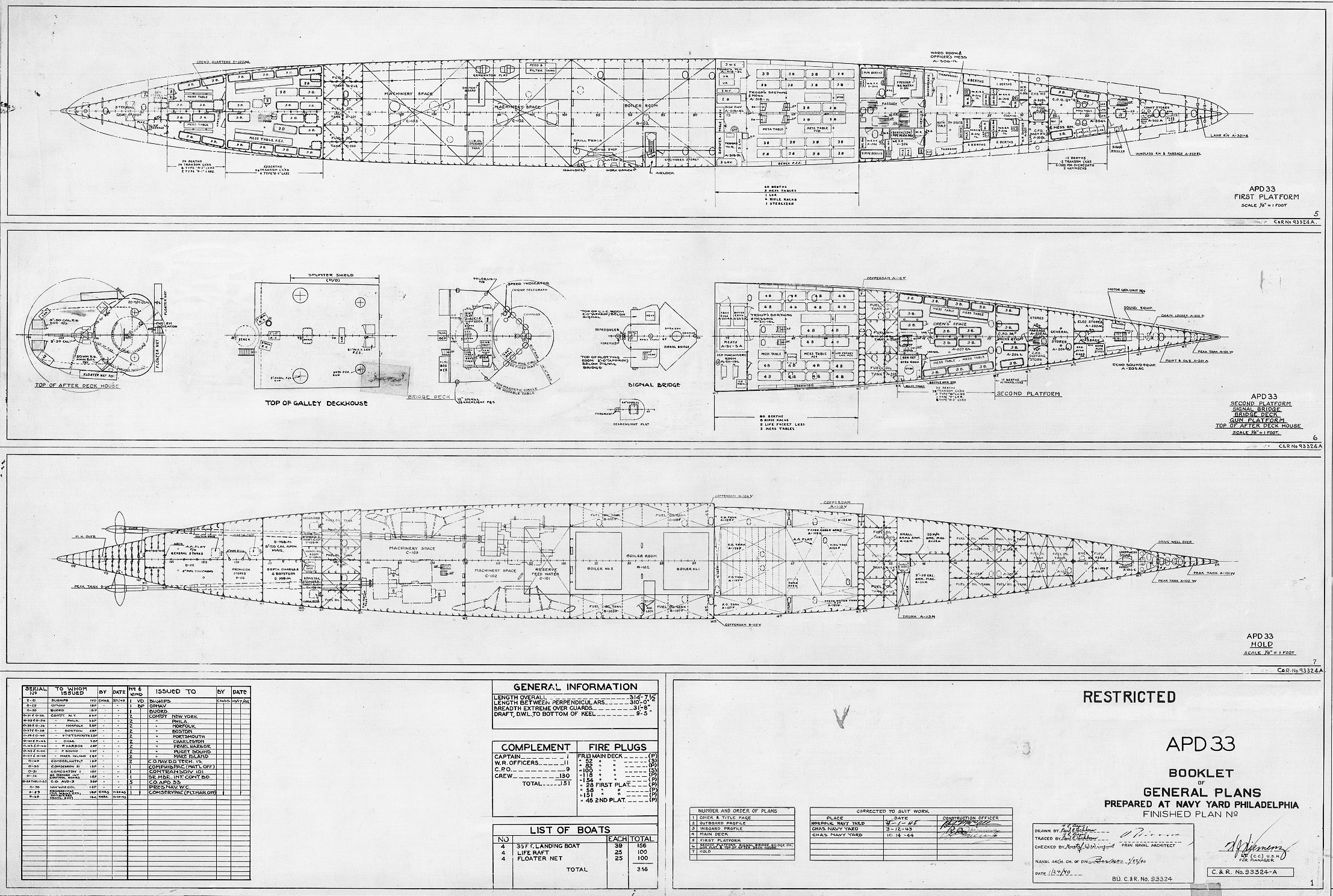
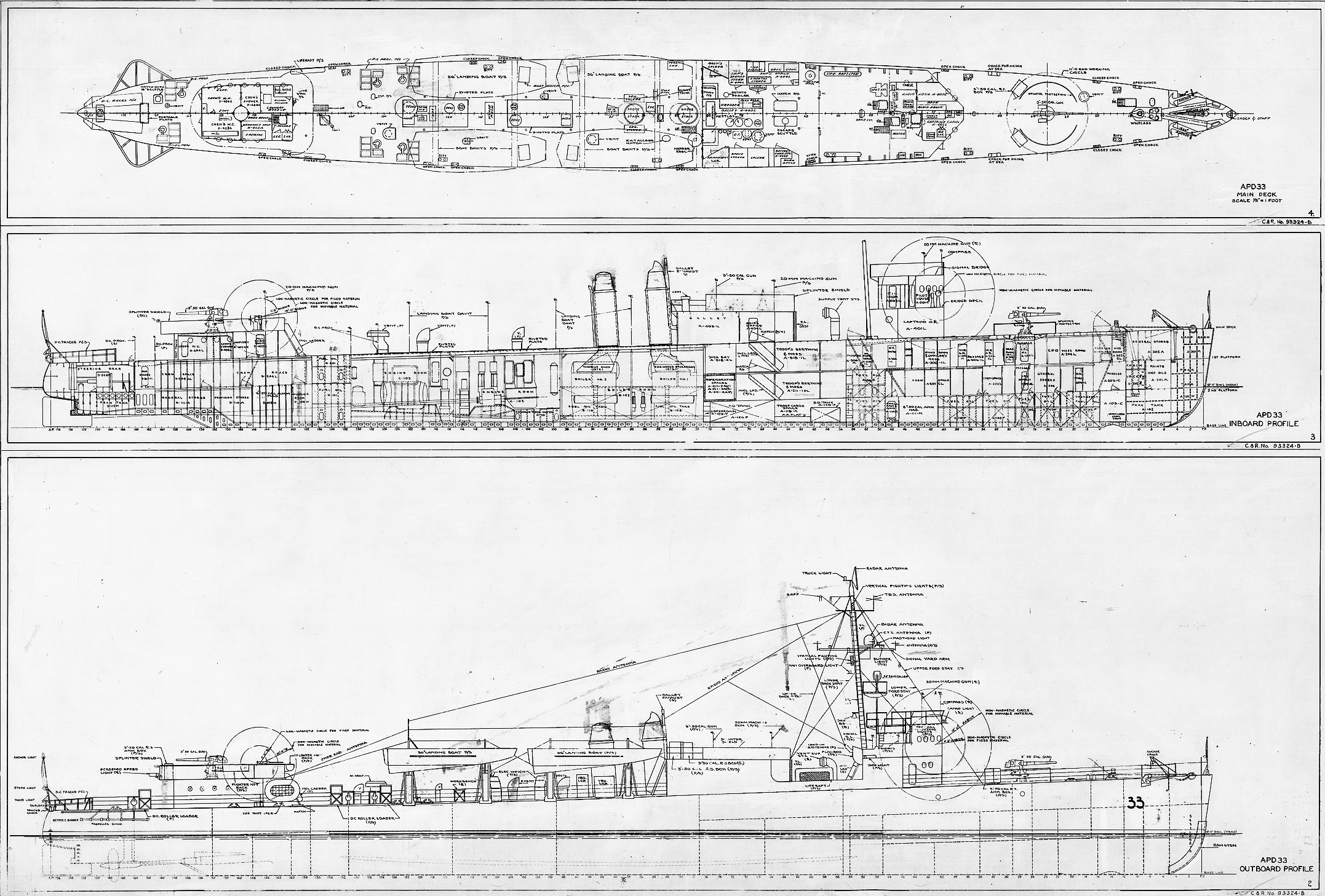
Plans, USS G. E. Badger APD-33 1944.
⚙ APD class specifications |
|
| Displacement | 1,315 tons standard, 1,793 tons FL |
| Dimensions | 95.7 x 11.3 x 3.76m |
| Propulsion | 2 shafts GST, 2 boilers, 13,000 shp |
| Speed | 22-24 kn (40 kph, 25 mph) |
| Range | Oil 429 tons, circa 7,000 nm |
| Armament APD10-13 | 3x 3-in/50 Mk 20, 6x 20mm AA, 4 DCT, 2 DCR |
| Armament APD18, 23, 24, 29, 31-36 | 3x 3-in/50 Mk 20, Twin 40mm AA, 5x20mm/70 Mk 4, 4 DCT, 2 DCR |
| Landing Crafts | 4 LCP(L) or LCP(R), 144 troops |
| Sensors | QCJ or QCL sonar, SA, SE radars |
The Clemsons in WW2
Fate of these ships were quite varied. Many were still active when WW2 broke out as destroyers, while others were used as AVPs (seaplane tenders) and AVDs (fast Minesweepers). As said above, many were sent to UK and Canada in 1940. The remainder were deployed in the Pacific, seen as a “secondary” theater while the more modern destroyers were mostly deployed in the Atlantic. From 1941 onwards, neutrality patrols became far more tense. A few Clemson class were involved in these, like USS Reuben James, first USN ship sunk in action by an U-Boat.
14 ships were involved in the Honda Point Disaster, seven lost, many other discarded in 1930-37, scrapped, as per treaty limits, which forced to retire from reserve a number of Flush-deckers in replacements. In 1936 169 of these were thus still active. In 1937 four as ben converted as fast destroyer minelayers (DM), completing converted Wickes-class ships in a single squadron. They served in that role for most of the war but a few reconverted as fast transports.
19 were transferred to the Royal Navy in 1940 (Destroyers for Bases Agreement) as said above, and the remainder converted as high-speed minesweepers (DMS), more destroyer minelayers (DM), or seaplane tenders (AVD), working in that condition for most of the war. The remainder were reconverted (or converted from destroyers) as high-speed transports (APD).
They all had been rearmed with dual-purpose 3-inch/50 caliber and 0.5 cal. HMGs fopr better AA protection, spared sonars, but more rarely received radars.
When rearmed, their original low-angle 4-inch/50 guns Mark 9 were transferred to Merchant Ships, for anti-submarine protection. On the minesweepers, the torpedo tubes were all removed and replace by a minesweeping gear: As part of the conversion, the number 4 boiler, fourth funnel, and torpedo tubes were removed, while the depth charge racks were repositioned forward from the stern and angled outboard, while ther stern was modified to support minesweeping gear including davits and a winch, but also paravanes, and kites. Two 60-kilowatt turbo generators replaced the three original 25-kilowatt electric generators, improving power for esfficient sweeping magnetic and more discretion to acoustic mines.
The strangest case was USS Stewart scuttled at Soerabaja on 2 March 1942, raised and repaired, recommissioned by the Japanese as PB-102, surrendered to the US Navy in August 1945 and returned into service for a short while. But in all 17 Clemson-class destroyers were lost during the war, actually more than the Wickes class (9).
Two Clemson-class destroyers ended as target ships in San Francisco Bay area, USS Corry (Mare Island), USS Thompson (southern part of the Bay) and since officials were rare to christen so many ships, the bottle of champaign was broken by the very first women who enlisting in the Navy as Yeoman (F) in WWI like USS Hatfield (DD-231) by Mrs. J. Edmond Haugh (Helen Brooks) and others.
AG ships:
At the end of the war, those not converted as fast transports, and still in their original destroyer configuration became “miscellaneous auxiliary” (AG) in 1945 such as USS Dahlgren, Chandler, Broome, Whipple, MacLeish, Simpson, Bulmer, McCornick, John D. Ford, Paul Jones, Hatfield, Fox, Stoddert, Lightfied, Zane, Trever, Preble, Sicard and Pruitt. What were they used for ? Alongside ships that were purpose-built, they were supposed to take on harbour tasks, which were quite varied: Training (for vairous specialties or as targets for airplanes and submarines), liaison, transport, patrol guardship (close to harbour entrance and approaches), or stationary barrack and depot ships, totally or partially disarmed. The barrack ship type was not really relevant in 1945 so they mostly take on depot and floating workshop role. One of these was to provide electricity via their machinery, via a converter or dynamo, notably to submarines or installations. But they were not given any specialized role which enticed a more active, sea going assignments, like the seaplane tenders and fast minesweepers. They were considered too old for this.
Losses
-USS Hovey (DMS 11) and Long (DMS 12) were sunk by Japanese air attack in the Lingayen Gulf (Luzon, Philippines).
-USS Borie sank after fatally ramming U 405 in an epic action N of the Azores.
-USS Edsall was sunk with all hands by the Japanese battleships Hiei and Kirishima South of Java.
-USS Stewart was left in Soerabaya drydock (Java) after Japanese bombing but survived demolition efforts to become the Japanese P 102 and was found in Japanese home waters on 15 October 1945. She was finally expended as a target (see later).
-USS Pope was sunk by Japanese aircraft in the Java Sea.
-USS Peary was sunk by the same cause in the Darwin Raid.
-USS Pillsbury was sunk by Japanese cruisers and destroyers S of Java.
-USS Truxtun was wrecked in Placentia Bay, Newfoundland.
-USS Sturtevant was mined and sunk off Marquesas Key, Florida.
-USS Reuben James was torpedoed and sunk by U 562, 600 miles SW of Iceland, the first US warship loss of World War Two.
-USS Barry (APD 29) took Kamikaze damage off Okinawa on 25 May 1945 and was sunk as a decoy the next month.
-USS Belknap (APD 34) was damaged beyond repair by Kamikaze attack in the Lingayen Gulf on 11 January 1945 and scrapped afterward.
-USS Wasmuth (DMS 15) sank by explosion of her own depth charges in a gale off the Aleutians.
-USS Perry (DMS 17) was mined and sunk off Palau.
-USS Noa (APD 24) was sunk in collision with the destroyer USS Fullam off Palau.
(British/Canadian losses not included).
The case of USS Reuben James
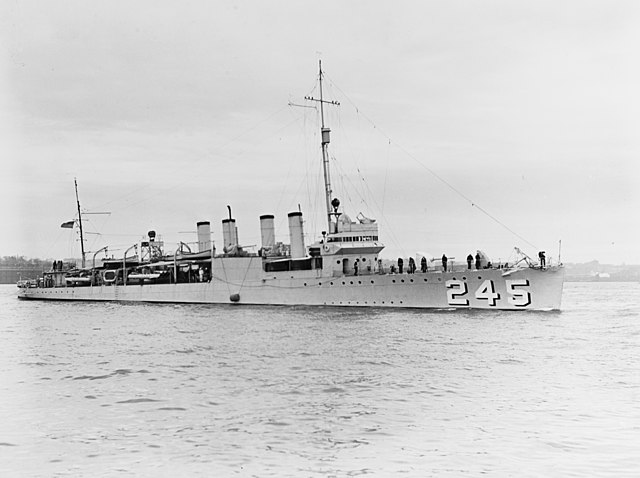
USS Reuben James (DD-245) named for Boatswain’s Mate Reuben James (1776–1838) of the First Barbary War, was the first US navy ship sunk by an hostile action in World War II. Laid down on 2 April 1919 at New York Shipbuilding Corp. Camden, launched 4 October 1919, commissioned on 24 September 1920 she served in the US Atlantic Fleet, Mediterranean from 1921 to 1922, notably off Yugoslavia and in the Adriatic Sea, assisting refugees or postwar investigations. She escorted USS Olympia returning to the Unknown Soldier home. At Danzig (29 October 1921-3 February 1922) she took part in the American Relief Administration to relieve hunger and misery and returned to the Mediterranean, Gibraltar and returned to New York City, patrolled off Nicaragua (weapons trafficking to revolutionaries in early 1926) and after the spring 1929 fleet maneuvers she was decommissioned at Philadelphia on 20 January 1931.
Recommissioned on 9 March 1932 she patrolled Cuban waters during the coup by Fulgencio Batista, then was sent to the Pacific fleet, San Diego in 1934 and escorted aircraft carriers, then was back to Atlantic Fleet in January 1939, assigned to the Neutrality Patrols.
In March 1941, she joined the escort force up to Iceland due to the range, before the escort was passed onto British escorts, based in Hvalfjordur under command at the time of Lieutenant Commander Heywood Lane Edwards.
She escorted in this quality ON 20 30 Sep – 9 October 1941 from Iceland to Newfoundland prior to US declaration of war and HX 156 from 24–31 Oct 1941 from Newfoundland to Iceland prior to US declaration of war when it happened. At dawn on 31 October, she was torpedoed near Iceland by U-552 (Kapitänleutnant Erich Topp). USS Reuben James was indeed posted between an ammunition ship and the position of a just reportedn “wolfpack”. Crucially, the destroyer was not flying the US ensign and was about to drop depth charges on another U-boat, so Erich Topp took responsibility to intervene despite the neutrality breach risks. For U-Boote submariners, the growingly proactive and even agressive nature of US escorts started to be unbearable to take. But still, under strict orders from Dönitz, these capitains had strict orders not to engage US warships.
She therefore engaged with a spread of four torpedoes the merchant ship behind the passing destroyer, to secure the argument of its real intentions. Ansd sure enough, one hit forward the destroyer. USS Reuben James had her entire bow blown off as the warhead detonated next to the forward ammunition magazine, which exploded. The bow sank immediately but the larger aft section was somewhat protected by its weak and torned off bulkheads. She started to flood but floated for five minutes, before going down. 100 of the crew, 2/3 of the crew (and all officers), went with her to the bottom, with 44 sailors being rescued. There was also a civilian passenger onboard.
As reported by the U-Boat captain the incident was commented by the Embassy as a “regrettable mistake”, the destroyer being on the path of the U-Boat. This was assorted by another warning to the escort “methods” under Admiral King, that others could happen, notably after the “Greer incident” (Wickes class) when the latter fired on an U-Boat in . There had been cases also of U-Boat attacks, so that late before the US entry into the war, all knew on both sides a “quasi-war” was ongoing since months. After Reuben James, the posture of US captains towards U-Boats became a “free for all”, with the common understanding that any U-Boat spotted or detected should be attacked without restrain, even when encroaching on the British sector of the Atlantic. It was acted soon after the torpedoing of USS Kearny on October 17.
Woody Guthrie wrote a famous song about the event, which was widely sang by US sailors in WW2 alonsgide the “remember pearl harbor”.
A USN Destroyer through and through: USS Dahlgren
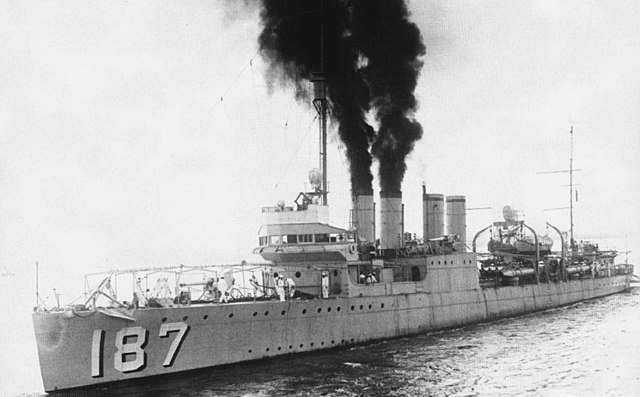
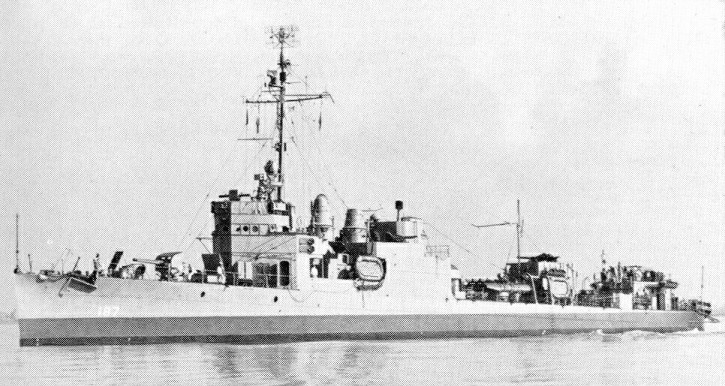
USS Dahgren in 1932, just reactivated, and in 1945, showing the extent of her wartime modifications.
Dahlgren joined the Atlantic Fleet (usual training, exercises and manoeuvers along the East Coast, venturing in winter in Mexican waters and Guantanamo Bay in Cuba or around the Panama Canal Zone. She was part of the Presidential Fleet Review at Norfolk by April 1921. She was also present as guard ship during the secret bombing tests on former German ships off the Virginia by aviator B. Mitchell. On 30 June 1922, she was decommissioned at Philadelphia, until 25 October 1932. She left Norfolk on 7 November for San Diego and the Pacific fleet on 30 November and alternating exercizes there and fleet problems in the Atlantic. In January 1935, she was based in San Diego and was sent to the East Coast on 1 July 1937 (rescued the crew of a USCG seaplane underway) to York, used for engineering experiments until 14 June 1940.
She was homeported to Newport, Rhode Island and between patrols she escorted submarines while training. From January to 1 April 1941 she served in the Patuxent River in Maryland for ordnance and ASW detection tests. The summer 1941 saw her testing a new variable-pitch propeller, escorted a new cruiser in trials. On 4 January 1942 she was homeported to Key West, escorting USS Washington in the Gulf of Mexico and bacl to New York for coastal patrol, then in March was assigned to Key West Fleet Sonar School. During her patrols, she rescued 57 survivors from SS Pennsylvania (sunk 15 July 1942) and from the airship K-74, shot down by a surfaced U-Boat on 19 July 1943.
She was probably modernized and converted in between in 1942, with 2 boilers removed as well as funnels, more fuel added, she kept two 102mm/50, kept a single 76mm/23, an dher two forward 533mm TT banks (aft removed), plus four 76mm/50 Mk 20 AA, two 12.7mm/90 and/or two or four 20 mm Oerlikon AA guns. Her bridge was rebuilt, with a new upper open bridge, portholes for the main navigation bridge, a modernized FCS, a new pole mast with radar, and the QS Sonar.
On 11 January 1945 she arrived at Charleston, South Carolina and started training with submarines until 1 March (for the latter to learn how to evade a destroyer, or to attack one), and was ultimately reclassified AG-91. Her own task was to be a mine Warfare Test Station based in Solomon Island, Maryland (not the Solomons, Pacific !), until 16 November 1945, and then transferred to be moored at Philadelphia Navy Yard, decommissioned on 14 December 1945, and sold 17 June 1946.
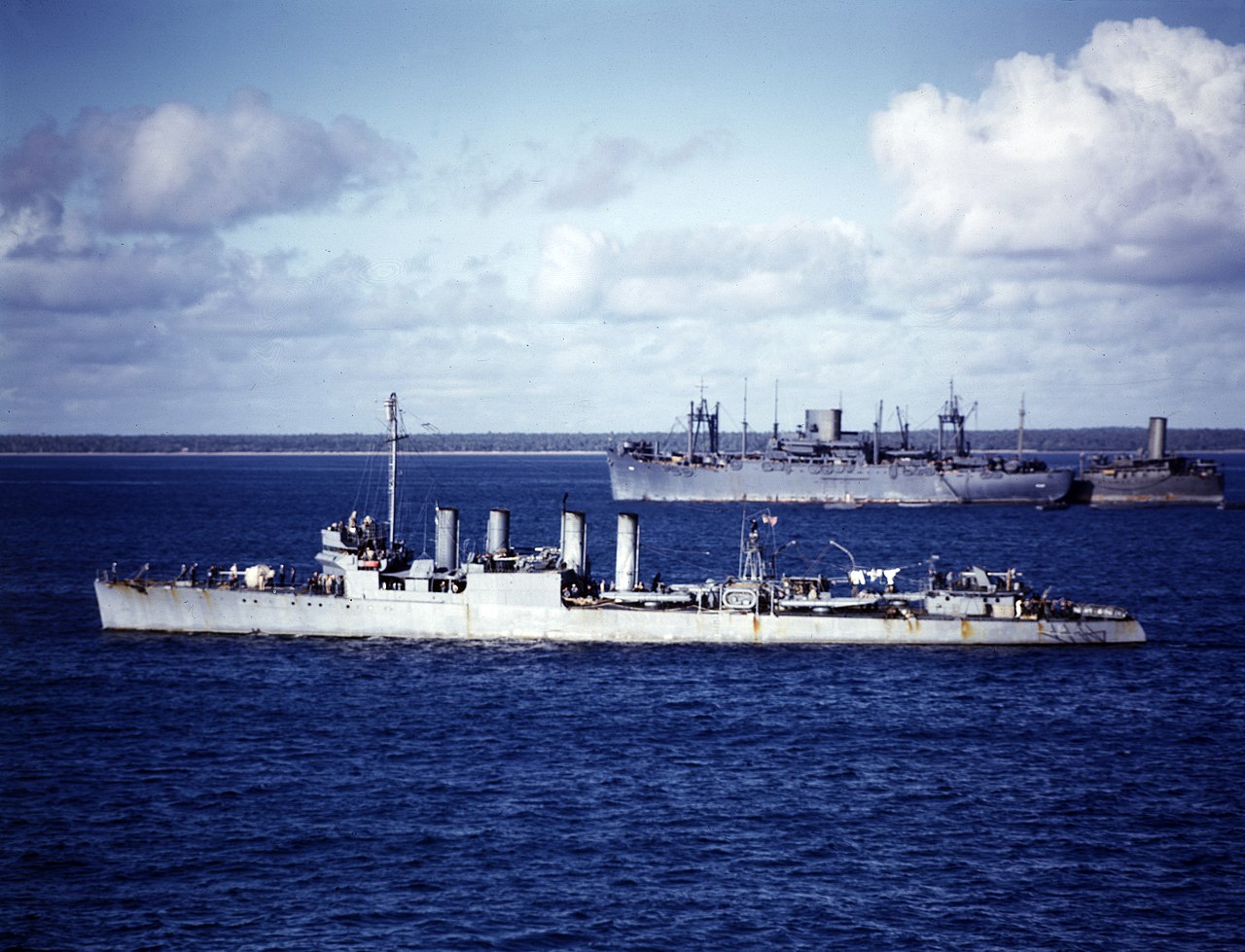
Another “pure” DD left in its original cofiguration until decommission in 1945: USS Barker, here escorting USS Pdt. Jackson (AP-37) off Tongatabu on 21 July 1942. She escorted ships from Pearl Harbor to 1945, on virtually all theaters but Murmansk. She also took part in USS Core escort carrier Hunter-Killer Task Group, rescuing U-Boat crews at several occasions.
Life as a fast assault transport: USS Humpreys as AVP-12
USS Humphreys started her career like many other Clemsons, in the Mediterranean’s special force deployed not only for relief during the Greek-Turkish war, civil war, and repression against Armenians, bringing stability in the equally troubled Adriatic, and overall patrolling the Black Sea in turmoil with the Russian civil war, evacuating or supporting the whites. She also surveying work and was a station and communications ship. She also operated off Palestine and Egypt on maneuvers. She sailed home from Constantinople by 6 August 1921, to Newport, Rhode Island and spent the newt 2 years in training in the usual Atlantic and Caribbean waters (alternating winter/summer). From 21 January 1925 she crossed the Panama Canal to San Diego, California and from March took part in the West Coast fleet maneuvers but returned to New York and trained between Newfoundmand and the Carribean, until decommissioned at Philadelphia from 10 January 1930 (reserve training cruises still in 1926-29), until 13 June 1932. She returned to the West Coast for two fleet problems and was back in April 1934 for New York and East Coast fleet exercises, notably off Haiti. Back to San Diego again on 8 November 1934 (imagine the life of sailor’s families !) and a carrier training exercise in the Pacific as screen ship and plane guard for the “Lax”, “Sara”, and brand new Yorktown and Ranger. She also travelled to Pearl Harbor and Midway but was decommissioned a second time at San Diego on 14 September 1938… until 26 September 1939.
Back to the east, she started on 13 November 2 years of Neutrality Patrols in the Caribbean, but made a short refrsher training for ASW warfare at the sound school at Newport. Homeported to Norfolk she returned to San Diego, and went on with Neutrality Patrols off California. At the time of the atttack on Pearl Harbor she escorted ships between San Pedro and Seattle, but was ordered to reinforcements the US deployment in Alaska, at Kodiak from 31 May 1942. She also trained with the cruisers USS Honolulu (Brooklyn class), and Indianapolis (Portland class). Back in San Francisco on 11 November however the navy had other plans for her. She was one of the first Clemson class ships to be converted (at Mare Island Navy Yard in that case) as high-speed transport, reclassified APD-12 on 1 December 1942 after conversion.
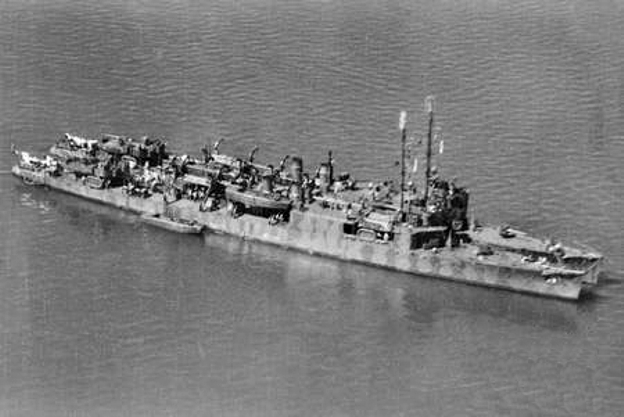
USS Humpreys as APD-12 and USS Sands APD-13 in Townsville in May 1943. Note they still have their wavy pattern typical of 1942, but in that case, it was two tons of green.
Following shakedown training in her new configuration she was sent to Pearl Harbor on 31 December, prepared and trained further, notably to practice rapid assault deployments. Amphibious training in Hawaiian waters multiplied until she was declared ready and she was sent to Noumea, New Caledonia, on 22 January 1943. From this ideal base for the Solomons, she started ferrying troops and supplies to Guadalcanal but also at the advanced bases of Tulagi and Florida Island. She took part in many assaults on the Solomon and often fought off random Japanese air attacks. Each time, she avoid damage, dodging bombs and torpeodes. Thse destroyers, despite their age and any machinery overhaul, kept their agility and speed. Strafing attacks did some damaged and wounded men, but no fatality.
After further training landings, Humphreys carried the 1st Cavalry Division at Nouméa and then to Townsville in Australia to prepare for Operation Chronicle. If you known nothing about these operations, most of these were landings on relatively obscure islands in order to secure points on the map. Largely forgotten assaults in the great scheme of the Pacific campaign. In that cases, these were the Woodlark and Kiriwina Islands, Milne Bay, New Guinea. She departed from Australia from 21 June, and landed troops and equipment on Woodlark on 23 June without opposition, the very first dot on the New Guinea maze, and started of the campaign, notably for Admiral Daniel E. Barbey and his 7th Fleet Amphibious Force (“VII Phib”). The experience for operations was precious.
Back to Brisbane for a summer overhaul, APD-12 was back to Milne Bay 15 August and prepared to do the same at Lae, on 4 September. There, these “green dragons” stayed close to the beach to protect landing craft from any counter-attack. Australian troops were carried and landed by Humphreys and Lae fell. She was underway on 7 September, carrying casualties for Buna. On the 10th she made another sweep in Huon Gulf and attacked Japanese supply barges, shelling Japanese positions.
Finschhafen was the newt stop. Humphreys and others rushed for a night surprise landing on 22 September, followed by reinforcements 8 days later and carrying back casualties to Buna in October, before retiring to Goodenough Island in 19 October fo rest and amphibious exercises.
The fall of New Britain was an important stepping stone towards the Philippines, bringing notably the Vitiaz and Dampier Straits. Next she was assigned to a group destined to take Arawe, southern New Britain, arriving on 15 December. She brought herself the 112th Cavalry Regiment in rubber boats, seizing harbor islands and stood offshore for on-demand gunfire support. She retired afterwards to Buna, the new RAS point.
Next, she took part in the Cape Gloucester landings, on 26 December 1943, remaining at Cape Sudest until February 1944. Next was the Admiralty islands campaign. Froù 27 February, arriving off Los Negros 2 days later. Humphreys landed troops at Hyane; steamed to Cape Sudest; and, when resistance stiffened in early March, returned off Hyane with reinforcements.
In April she was part in the Hollandia operation, landing troops at Humboldt Bay (22 April) and again stayed for gunfire support. She returned to Buna and on 12 May went home for a real rest and refit.
Having a hero’s welcome at San Francisco on 30 May she received a quick conversion to operate frogmen of the skilled Underwater Demolition Teams (UDT). These were crucial in “cleaning out” beaches one or two days before a landing. They operated from a destroyer, using assault crafts such as the LCPs combined to fast rubber boats to launched and retreive the swimers, also called the “naked warriors” of the USN since they had no swimwuit, but just a knife, snorkel and goggles, plus demolition equipments and waterproof maps. Not only these UDTs were to clean obstacles, but they also had to monitor these along the planned future landing beaches, ad report their findings. They generally operated by night, and managed to work as teams and separately and then converge at the same point at sea, waiting in line to be picked up. Needless to say a dangerous mission. These men weren, with the Marines Ranger, part of the elite of the Naval Infantry, special operatives, ancestors to the SEALS which really emerged in Vietnam.
Back in operations from 30 July, USS Humphreys trained in Hawaiian waters again and was detached to the forward operating base, Manus Island, on 28 September, joining the invasion fleet for the Philippines. On 12 October she went forward, carrying the UDT Team No.5 to the Leyte beaches (18 October). She remained closed enough to provide fire support for the four LCPs launched in operation. The first night was often for reconnaissance and the next for demolition, once the landing maps has been updated. She epated later for Leyte Gulf, hunting for Japanese submarines, something she was still prepared for thanks to her sonar and depht charges. This went on until the proper landings on 20 October 1944. During an air rais, she claimed a bomber on 21 Octoberand escorted a convoy back to Manus (notably with injured men on board destined to the field hostpitals there).
A classic, “the frogmen” (1951) starring among others Richard Widmark, explaining the UDT roles and operations.
Next was the invasion of Luzon, after a quick run to Noumea and Hollandia, and return to the Palaus on 1 January 1945, carrying the Lingayen invasion group. Along the way, Kamikaze attacke multiplied and she dodged and shot down several attackers. They reached a new level of intensity while Lingayen Gulf on 6 January. On the night of the 6-7 her UDT team swam ashore and the mission was over on 10 January.
She was back to FOB Ulithi, on 23 January 1945. Her “spec ops” missios were over. The high command decided her crew has seen enough (while being lucky all that time) and she was reassigned to screening logistics groups tasked of the less glamorous but vital at-sea replenishment and refueling. This force was assigned to the large carrier group of the 5th fleet or TF 58, the instrument of victory in the Pacific. She screened refueling operations of the escort carriers specifically, thos who covering the Iwo Jima landings (while the fleet carriers went ahead to attack Japan) and operated close to Iwo Jima itself on 8 March 1945, providing gunfire on demand. She was then dispatched to Leyte with a convoy on 17 March.
Before the main lansings at Okinawa, she took part in the assault of Keise Shima on 31 March. Landing troops and screening LSTs and escorting the noria of ships carrying supplies until 3 April. Back to Ulithi for rest and resplenishment, she came back to Okinawa, escorting resupply convoys from Ulithi. This was her last trip in a warzone. She was ordered back to Pearl Harbor on 4 June 1945, sailed to San Diego for a short maintenance, being reclassified DD-236 on 20 July 1945, but she saw little service from then on and was ultimately decommissioned after some reserve on 26 October, sold for scrap 26 August 1946.
A unusual Career: USS Stewart, captured by the Japanese

On commissioning she was assigned to DesDiv 37, a reserve division for DesRon 3, Atlantic Fleet, and transferred to DesDiv 39. Coastal operations for reserve squadrons and then Atlantic Fleet from 12 October 1921. From 5 January she left HP Charleston for the Caribbean but had on 6 January a collision with Hopkins (minor damage). After fleet exercises until 23 February 1922 she had an overhaul at Philadelphia, gaining an echo sounder. She was assigned to DesRon 15 (tender USS Black Hawk for 12 destroyers), HP Rhode Island in June sailed to the Mediterranean, Indian Ocean, Philippines, Asiatic Fleet, staying there for 23 years.
She was based at Chefoo (Yantai) in sumer, Cavite in winter for the Asiatic Fleet routine, between Chinese waters training exercises and port calls at Chinese ports. By September 1923 she was in Yokosuka for relief operations after the Great Kantō earthquake (like all her sisters), and also Tokyo on 30-31 August 1923. She had a refit at Olongapo and Cavite.
In 1924 she started surveying operations with her echo sounder mapping many unknown areas and supported a flight of 4 US Army Douglas World Cruiser aircraft around the world, while off Shanghai.
Until 1928 she watched the tense situation Shanghai and Canton, landing marines to Shanghai in January 1925 and making “gunboat patrols” on the Yangtze and off Canton. She observed the Northern Expedition of the Kuomintang upriver. 5 September with USS Pope, fired on from the shore, 2 wounded. 10 September assisted gunboat Palos and minesweeper Pigeon under rifle and artillery fire. She returned fire this time.
On 18 February 1927 with USS Paul Jones, left Manila to seach for SS Elkton (merchant ship gone missing), bound for New York, joined by William B. Preston and Sicard. Steward was in Shanghai on 24 March 1927 as the National Revolutionary Army troops attacked foreigners (Nanking incident) and she remained on the Yangtze (Wuhu, Nanking, Shanghai, Chenglin). 27 March she was fired on (3 wounded) and collided with SS Luen Ho 5 November 1927 (dented side). Remained in China up to 14 January 1928.
Was off Matsu Islands, when attack on Shanghai, January 28, 1932 incident. Moved to Swatow to protect American citizens until 3 February, then Amoy until 24 February, and Shanghai 26 February. 23 March collided with sloop HMS Sandwich. Had a chain on her port propeller, badly damaged. In Shanghai until 12 May 1932.
January 1934 overhaul and repair at Cavite. Fire broke out aboard 10 February 1934. July 1934, dragged her anchor at Chefoo, colliding with Chuyku (minor damage).
War of 1937: Stationed at Tsingtao and Shanghai until 17 October. Attacked in Shanghai (near-misses by Chinese aircraft). Resupplied at Yokohama in October. She Carried newreel footage of the Japanese sinking of the American gunboat Panay. Stayed in China until 21 March 1938. 30 July with Pope and Parrott, left Manila to search for PANAM Hawaii Clipper until 6 August. Back in China 3 June to 4 September 1939. Patrol duties in the Philippines until OVL 5 April 1940. Plane guard for seaplanes Guam-Philippines. Yellow Sea ports July-September 1940. Stayed in the Philippines, patrols in Manila Bay and southern Philippines.
27 November 1941, sent to Dutch East Indies to minimise Japanese air attack effects by dispersion. She joined cruiser Marblehead, sisters Barker, Bulmer, Paul Jones and Parrott, to Borneo 29 November 1941, Tarakan on 8 December.
She escorted naval auxiliaries Philippines-Port Darwin (Australia) and by 9 January 1942 with USS Boise and Marblehead escorted a convoy to Surabaya (transport Bloemfontein, Pensacola Convoy) with the 26th Field Artillery Brigade and HQ, 1st Battalion, 131st Field Artillery and supplies to Java. 30 January she left Bunda Roads, 4 February intercepted Japanese forces south entrance Macassar Strait. Marblehead badly damaged by air attacks, Stewart escorted her back to Tjilatjap.
Joined ABDA Command on 14 February for the sweep on the northern coast of Sumatra. Nearly collided with a Dutch destroyer (ran aground on a reef in Stolze Strait). On the 15th, survived air attacks in the Bangka Strait. Detached on 16 February to fuel at Ratai Bay, Sumatra.
Battle of Badung Strait, she was the lead ship, second group. Furious night engagements, came under accurate fire from Japanese destroyers. TTs destroyed, flooded steering engine room, holed at multiple places, but able to maintain her station in column back to Surabaya.
First to enter the floating drydock on 22 February but unsupportred she fell off the keel blocks to her side in 12 feet (3.7 m) of water: Propeller shafts and hull damage. Under enemy air attack, repairs excluded, the last crew members left the port on 22 February as she was stuffed with demolition. While setoff, she was damaged by a Japanese bomb amidships. Her drydock was scuttled. Stricken 25 March 1942, name freed for new USS Stewart, DE-238.
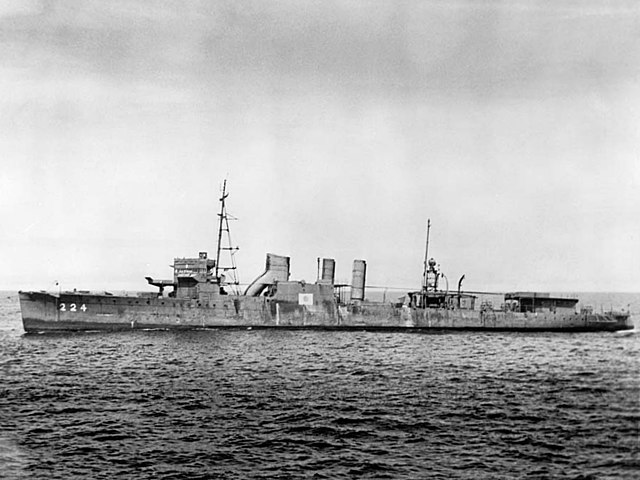
The fact she was refloated, repaired and recommissioned was unknown to US service for many months. Eventually USN pilots reported her underway later in the war and identified hr despite the modifications. She had been raised indeed on February 1943, repaired, modified and started a new career under the Imperial Japanese Navy on 20 September 1943 as “Patrol Boat No. 102”. She received two Japanese 3 inch guns and was sent in escort missions for the Southwest Area Fleet. On 23 August 1944, under Lieutenant Tomoyoshi Yoshima she operated with the sub-hunter CD-22 when sinking USS Harder with depth charges. In November 1944 she was overhauled in Kure, had her antiaircraft battery augmented an received a new light tripod foremast. She was reassigned to the Southwest Pacific, and by 28 April 1945, she was bombed and damaged by USAAF aircraft while anchored at Mokpo in Korea. Transferred on 30 April to Kure Navy District, by August 1945 she was captured by American occupation forces in Hiro Bay, probably surprised to find there one of the now legendary “flush deckers”.
In an emotional ceremony on 29 October 1945 she was recommissioned as “DD-224”, but nicknamed by the crew “RAMP-224” for “Recovered Allied Military Personnel”. However the Japanese had pushed her hard wothout much maintenance in 1943-45 and her engines gave out near Guam. She had to be repaired and towed slowly to San Francisco by early March 1946. She was stricken once more on 17 April 1946, decommissioned on 23 May 1946, sunk as target off San Francisco, by F6F Hellcat fighters using rockets. She refused to go and was finally sunk by USS PC-799 using 40-mm and 3-inch shells from 300 yards.
Liveries and camouflages
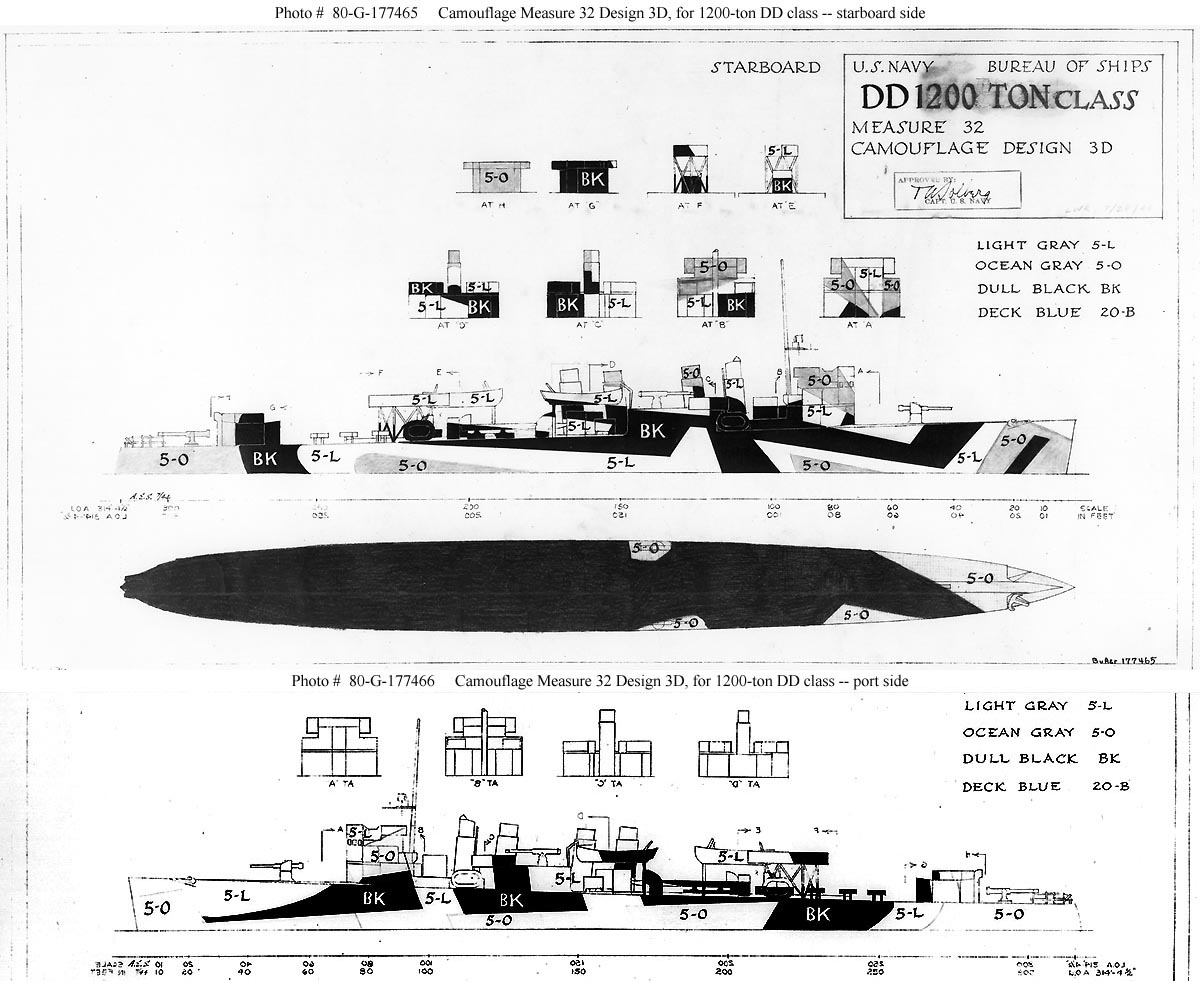
Measure MS-32 3D for the Wickes and Clemson class, 1944
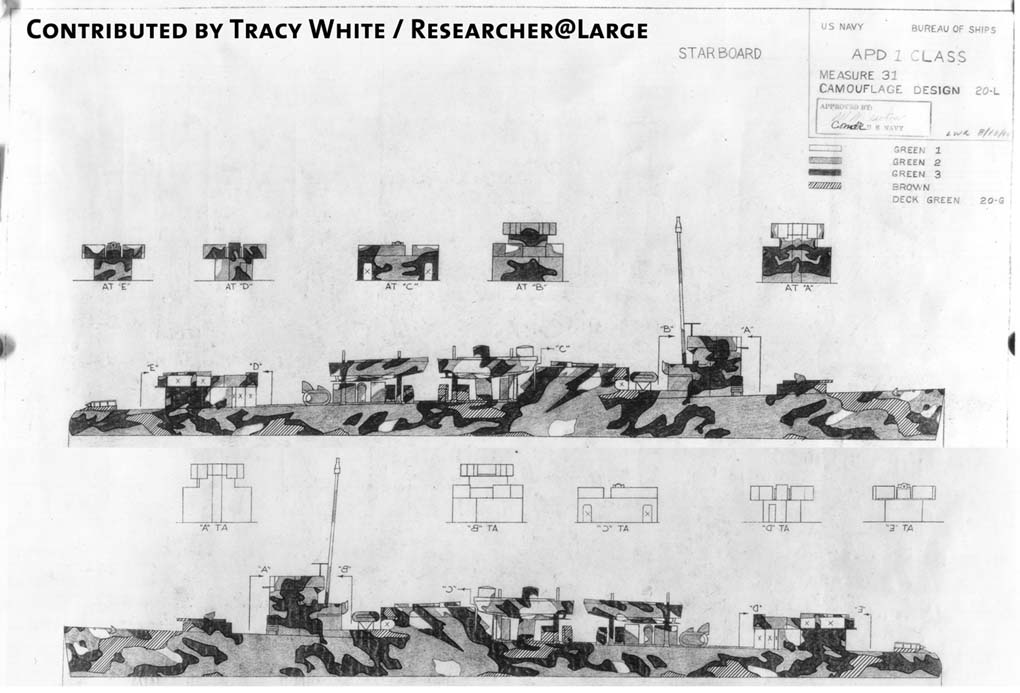
Measure 31 Design 20L APD-1 camouflage 1942
Read More
Books
Campbell, John (1985). Naval Weapons of World War Two. Naval Institute Press.
Friedman, Norman (2004). US Destroyers: An Illustrated Design History (Revised ed.). Annapolis NIP
Gardiner, Robert, Conway’s All the World’s Fighting Ships 1906-1921, Conway Maritime Press 1985.
Gardiner, Robert and Chesneau, Roger, Conway’s All the World’s Fighting Ships 1922-1946 Conway 1980.
Morison, Samuel Eliot (1962). History of United States Naval Operations in WW II. Brown and Co.
Silverstone, Paul H. (1970). U.S. Warships of World War I. Ian Allan.
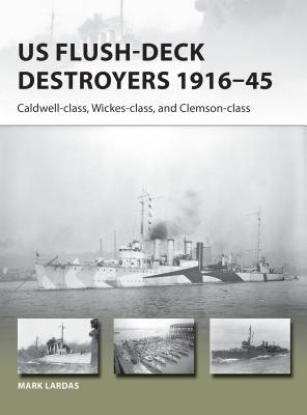
Osprey’s US Flush-Deck Destroyers 1916-45: Caldwell, Wickes, and Clemson Classes, Mark Lardas.

US Flush Deck Destroyers in action, Squadron Signal Pub.
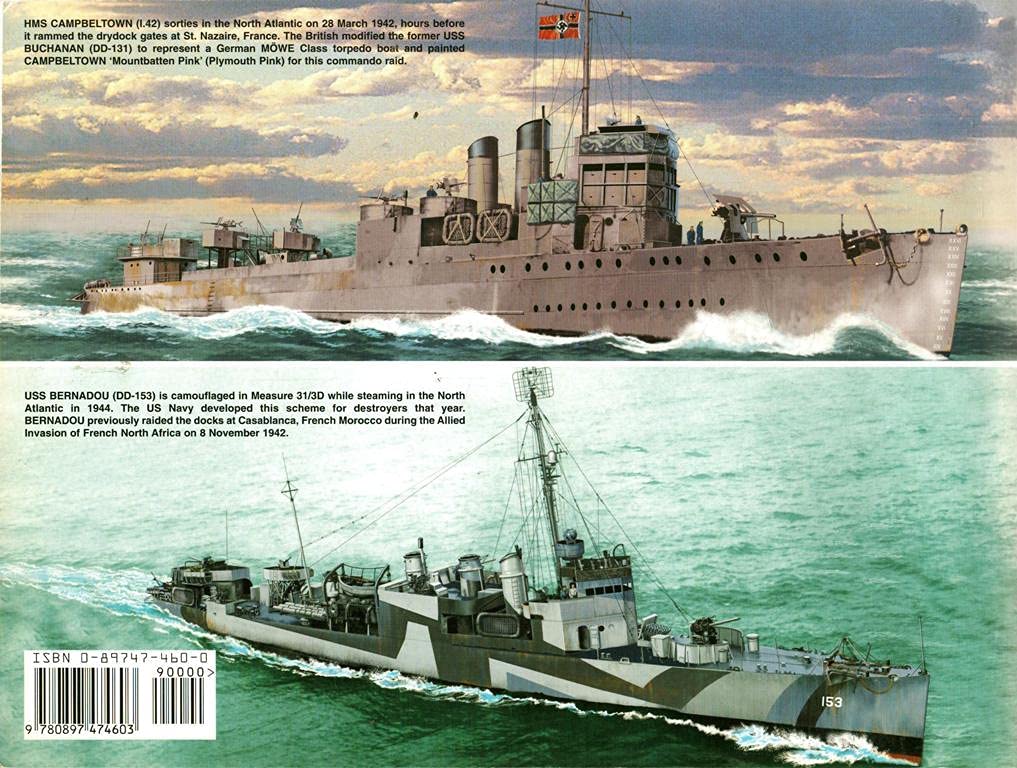
Nice renditions of the same book.

Naval Historical Fondation Book – US Flush-Deck Destroyers 1916-45: Caldwell, Wickes and Clemson Classes (New Vanguard #259) By Mark Lardas, illustrated by Johnny Shumate & Julian Baker, Osprey Publishing, Oxford, (2018).
Links
navypedia.org Clemson
Clemson-class_destroyer
Clemson class on destroyerhistory.org
On microworks.net
List_of_Clemson -class_destroyers
alchetron.com/
navweaps.com/ USN Mines
preliminary_design_wickes_class_destroyers
On historyofwar.org/
The town class on laststandonzombieisland.com
destroyerhistory.org/flushdeck/
Model Kits
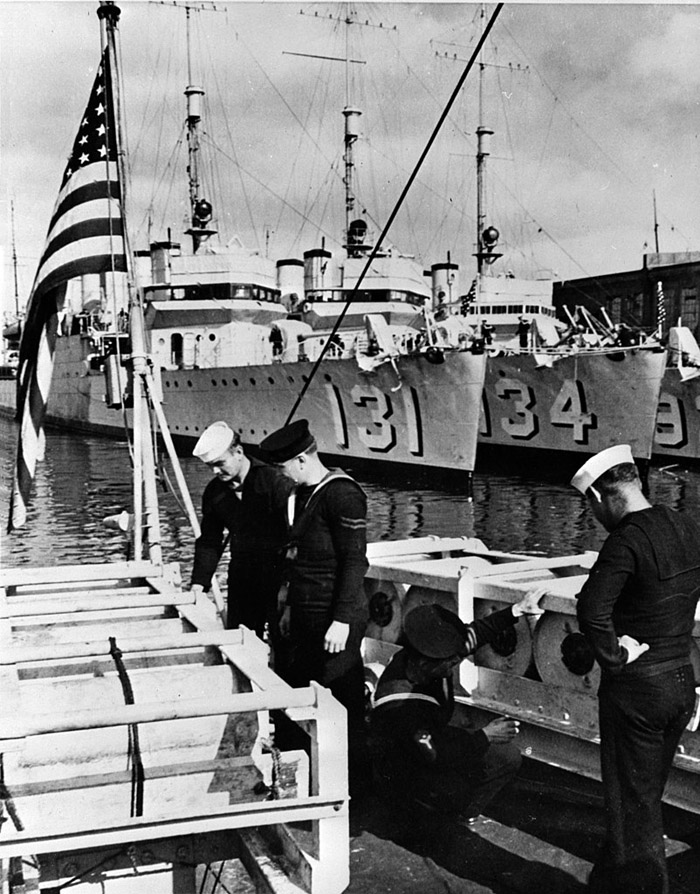
Large Model kit by SD Model Makers (1:72 for example !)
Plenty of choice – Scalemates query
Superb 3D – 2D rendition of the wickes class by Admiral Horton on deviantart
Old Kits: U.S.S. Reuben James 1941 White Ensign Models 1:350, P-102 (ex USS Stewart) Mirage Hobby 1:400, USS Borie DD-215 WSW Modellbau 1:700, DD-343 USS “Noa” kwiecień 1940 Mirage Hobby 1:400
Like the USS Ward Revell 1:240, same FlyHawk Model 1:700, Mirage Hobby 1:400, Bluejacket Ship Crafters 1:192, USS Decatur DD-341 1943 by Iron Shipwrights 1:350…
USS William B. Preston DD-344 US Navy Booklet of General Plans.
USS Reuben James (DD-245) Amerikanischer Zerstörer – White Ensign Models 1:350.
3D
Note: It shows the twin gun configuration, but wrongly with all four mounts doubled. The real ships only had those forward.
 USS Clemson (DD-186)
USS Clemson (DD-186)
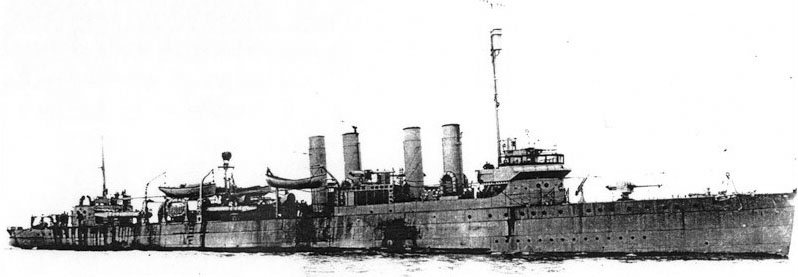
DD186 was built at Newport News from 5/1918, launched 5.9.1918 and completed on 12/1919. Lead ship, named after Midshipman Henry A. Clemson (1820–1846) off Vera Cruz 8 December 1846. Brief active life to 1922. Converted to aircraft tender 11.1939 as AVP17, reactivated 8.1940 AVD4. 12.1943 reconverted to a destroyer, Battle of the Atlantic. 1944, converted into high speed transport APD31, transferred to the Pacific. stricken 10.1945. sold for scrapping in 1946.
 USS Dahlgren (DD-187)
USS Dahlgren (DD-187)

DD187 (Dahlgren) from Newport News was started 6/1918 launched 20.11.1918 and comp. 1/1920. Like her sister, she had a brief active life before being placed in reserve in 1922. Reactivated in 1932, she served as destroyer until 1945, a good example of the modifications made to make her an Atlantic convoy escort. She became the miscellaneous auxiliary AG91 3.1945 and was sold for scrapping in 1946.
 USS Goldsborough (DD-188)
USS Goldsborough (DD-188)
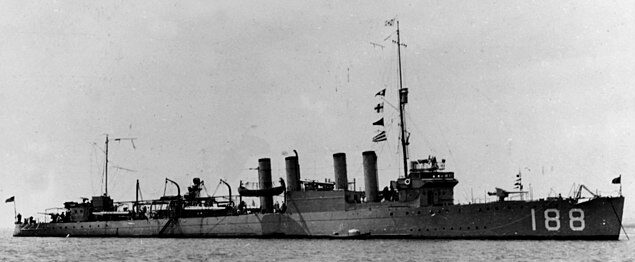
DD188 was from Newport News, started 6/1918, launched 20.11.1918, comp. 1/1920. She had a brief active life, in reserve in 1922. Reactivated in 1939, converted as seaplane tender and later destroyer in the Atlantic, in her escort and patrol work, notably with the USS Core task group hunter killer. She made no kills, but several attacks in 1942-43.
By 1944 she was converted as high speed transport as APD-32 and sent in the Pacific theater. Stricken 10.1945 and sold for scrapping in 1946.
 USS Semmes (DD-189)
USS Semmes (DD-189)
(No pic)
DD189 Semmes was built at Newport News (7/1918, launched 21.12.1918, comp. 2/1920) and in the interwar was reactivated as a Coast Guard cutter 4.1932 as Rum Patrol, then sent back to the Navy as destroyer 7.1934, and she became the test ship AG24 on 7.1935. She had been a testbed for the experimental twin 4 inch gun mount, but only forward, so she had five 4″/50 caliber guns rather than four, at least 1931 until it was decided to return to a single mount. She had been decommissioned in 1922-1932. She was recommissioned as an experimental ship (London Treaty limits) as the auxiliary AG-24, then Experimental Division 1. In 1942 escort work until V-Day in Europe and back to experiments, inactivated 21 May 1946, Decomm. 2 June, sold 25 November but eanring five battle stars.
 USS Satterlee (DD-190)
USS Satterlee (DD-190)
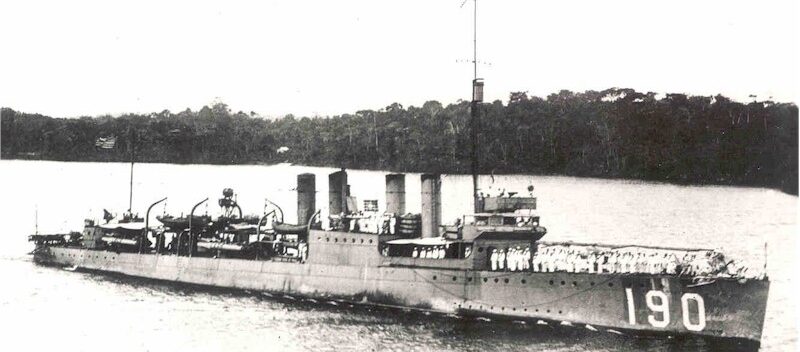
DD190 (Satterlee) was built at Newport News (7/1918, 21.12.1918, 12/1919). After brief service until 1922, reserve, reactivated 1939, transferred to the Royal Navy in 1940 as HMS Belmont, convoy escort in the Battle of the Atlantic until torpedoed and sunk on 31 January 1942.
 USS Mason (DD-191)
USS Mason (DD-191)
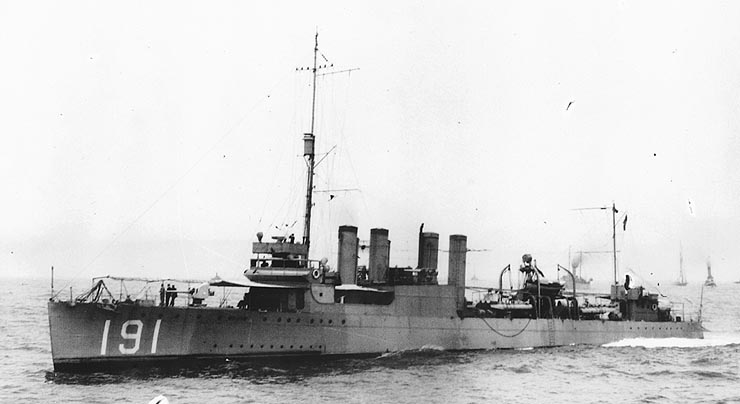
DD191 was from Newport News (7/1918, 8.3.1919, 2/1920). She operated along the east coast for 2 years until deactivated at Philadelphia, decomm. from 3 July 1922 to 4 December 1939. Transferred to the RN as part of the Destroyers for Bases Agreement, 2 September 1940, as HMS Broadwater. She was torpedoed and sunk by U-101, 18 October 1941.
 USS Graham (DD-192)
USS Graham (DD-192)
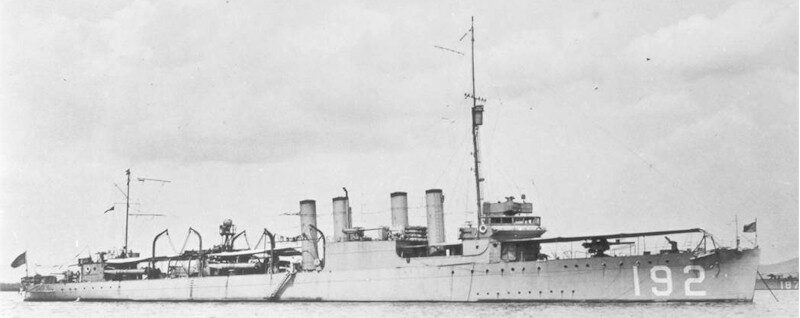
DD192 was from Newport News (?1918, 22.3.1919, 3.1920). Served with the Atlantic Fleet, then moving picture boat for the International Cup Race, Atlantic Torpedo Fleet at Newport, combined division maneuvers. Presidential Fleet Review. Bombing tests, escorted S.S. Paris (General Foch to New York). AA practice, reduced complement, collided with SS Panama, survived, declared total constructive loss and decommissioned at New York Navy 31 March 1922.
 USS Abel P. Upshur (DD-193)
USS Abel P. Upshur (DD-193)
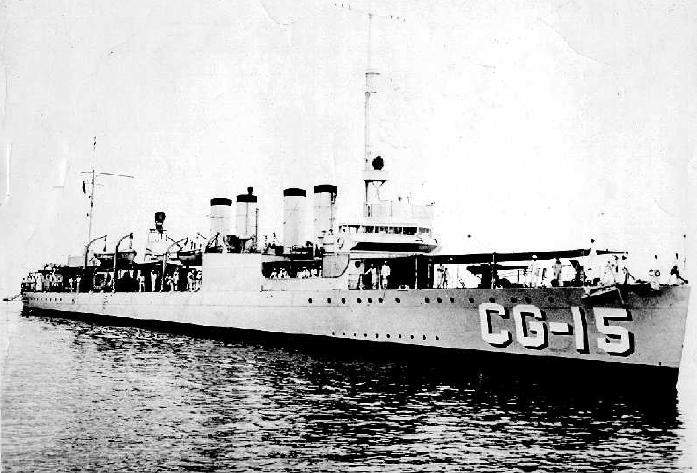
DD193 Abel P. Upshur was from Newport News (8/1918, 14.2.1920, 11/1920). Assigned to Destroyer Division 37, Squadron 3 Atlantic Fleet. Decomm. Philadelphia 7 August 1922 and recom. Washington NyD March 1928 as training ship, Naval Reserve, District of Columbia until 5 November 1930. Used for Rim Patrol until back USN 21 May 1934, laid until 4 December 1939 Atlantic Squadron neutrality patrols, East Coast to United Kingdom 9.1940 (HMS Clare). Survived the war.
 USS Hunt (DD-194)
USS Hunt (DD-194)

DD194 was from Newport News (8/1918, 14.2.1920, 11/1920). Shakedown, training Atlantic Fleet, torpedo trials Newport, Charleston, decom. Philadelphia 6 June-11 August 1922, reactivated 13 September 1930 – 28 May 1934 with USCG Rum Patrol. Reactivated Philly 26 January 1940, Neutrality patrol, Panama, escorted submarine USS Searaven to Florida, gunnery practice, Norfolk, exercises Chesapeake Bay. Newport to Halifax 5 October 1940, HMS Broadway (H90).
 USS Welborn C. Wood (DD-195)
USS Welborn C. Wood (DD-195)
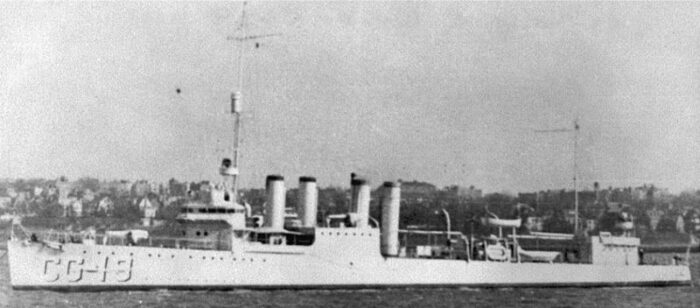
DD195 Welborn C. Wood was from Newport News (9/1918, 6.3.1920, 1/1921). Eastern seaboard, Atlantic Fleet, decom. Philadelphia 8 August 1922. October 1930 USGC Rum Patrol New London, Florida until 1932. Returned Navy 1934, reserve until 4 September 1939. Neutrality Patrol, Destroyer Division 67. Halifax 6 September 1940 transferred RN as HMS Chesterfield.
 USS George E. Badger (DD-196)
USS George E. Badger (DD-196)

DD196 was from Newport News (9/1918, 6.3.1920, 7/1920). Shakedown, HP Charleston, Caribbean waters-eastern seaboard. Decom. Philadelphian 6 June-11 August 1922. 1930 Coast Guard Rum Patrol. USN 21 May 1934, redesignated AVP-16 1 October 1939, converted seaplane tender Philadelphia on 8 January 1940. AVD-3 on 2 August 1940 Norfolk January 1941, assigned to NS Argentia, Newfoundland, Reykjavík, Iceland. Charleston 26 May 1942, convoy escort eastern seaboard, Gulf of Mexico, Rio de Janeiro. Norfolk 15 January 1943 modernized, Atlantic convoy duty off Argentia. June 43, overhaul Norfolk, Operation Torch, sank U-613 on 23 July 1943 off Azores, TF USS Bogue. Casablanca, New York August. North Africa with Bogue. December 1943, attacked U-172, later sunk. Conversion to high speed transport Charleston, APD-33, 19 May 1944. Pacific: Guadalcanal, Palau, Angaur, Lingayen, Leyte, Ulithi, Iwo Jima, Okinawa. San Francisco 1945 reverted to DD-196 on 20 July 1945, decommissioned October, scrapped 1946.
 USS Branch (DD-197)
USS Branch (DD-197)

DD197 was from Newport News (10/1918, 19.4.1919, 7/1920). After fitting out at Norfolk by October she made her trials off Annapolis and laetr joined Destroyer Squadron 3, Atlantic Fleet. From 6 January 1922 HP Charleston, Hampton Roads, drcomm. Philadelphia 11 August 1922 to 4 December 1939. Scouting Force, flagship DesDiv 68, Neutrality Patrol. Summer of 1940 East Coast, trained reserves. October 1940 Halifax, decom. 8 October, transferred RN as HMS Beverley.
 USS Herndon (DD-198)
USS Herndon (DD-198)

DD198 was from Newport News (11/1918, 31.5.1919, 9/1920). After shakedown, New England, reserve in Charleston 3 November 1920. Training exercises east coast until decommissioned Philadelphia 6 June 1922 to 4 December 1939, Caribbean Neutrality Patrol. Summer 1940 Panama Canal Zone. Decommissioned Halifax, transferred 9 September 1940 as HMS Churchill. Transferred to the Soviet Navy 16 July 1944 as Deyatelny artctic convoys, lost likely torpedoed by U-956 16 January 1945.
 USS Alexander J. Dallas (DD-199)
USS Alexander J. Dallas (DD-199)

USS Dallas was also from Newport News (11/1918, 31.5.1919, 10/1920). Named after Capt. Alexander Dallas Dallas she operated on the United States East Coast, HP Charleston, until decom. Philadelphia 12 April-26 June 1922, limited commission until 14 April 1925, flagship DesRon 9, 7, 1 East Coast-Caribbean, experimental ship Naval Torpedo Station Newport. San Diego March 1932., Hawaii. Presidential fleet Review une 1934 York City. Pacificuntil 1938, Hawaii-Alaska. Panama, Colombia, decom. Philadelphia 23 November 1938 – 23 March 1939.
Flagship DesRon 41, 30 East Coast, Newfoundland July 1941. Until March 1942 patrolled, escorted convoys to Reykjavík. Then Florida. TF 34 Operation Torch. Carried Raider battalion airfield Port Lyautey. Presidential Unit Citation. Boston, Norfolk, New York, New London, Connecticut, Gibraltar 1943. TF 81 Battle of Gela, Operation Husky. Operation Avalanche. Salerno. Philadelphia December 1943, overhaul Charleston, convpy escort. Decom. Philly 28 July 1945. Stricken, sold 30 November.
 USS Chandler (DD-206)
USS Chandler (DD-206)

DD206 was built at Cramp, Philadelphia (8/1918, 19.3.1919, 9/1919). DesRon 3 Atlantic Fleet, departed December 1919 for Turkey, Crimea, relief work, Naval Detachment, Adriatic, SS Venice, Suez Canal, Cavite, Philippines February 1921, Asiatic Fleet. Chefoo, San Francisco, decom. 20 October 1922, reserve Mare Island, recom 31 March 1930 PacFleet. 1934 Presidential Fleet Review. Radio sound test. Plane guard 1940 flight to Hawaii. Converted destroyer minesweeper DMS-9, 19 November 1940. Pearl Harbor February 1941. Until 30 June 1942 convoy ezscorts to San Francisco, Palmyra Atoll, Christmas Island, Midway Atoll. Aleutian Islands compaign 27 July 1942, collided with USS Lamberton (DMS-2). Repairs til 27 September 1942 Mare Island. Aleutians Camaign, landings at Attu, Kiska. Landings at Majuro, Eniwetok, Saipan, Tinian. Leyte Gulf, clearing approaches on 18 October. Lingayen operation 6 January 1945, kamikaze attacks. Shot down IJN planes 7 January 1945. Rescued USS Hovey. Iwo Jima 16-28 February. West coast for overhaul April, reclassified AG-108, towing targets for gunnery exercises. Decom. Norfolk 21 November 1945, sold 18 November 1946. Eight battle stars.
 USS Southard (DD-207)
USS Southard (DD-207)

DD207 was also from Cramp, Philadelphia (8/1918, 31.3.1919, 9/1919), fitted out and shakedown off Florida coast. New York City to join six other destroyers in escorting the British battlecruiser Renown out to sea as that warship departed carrying Edward, the Prince of Wales, after his visit to the United States. On 19 November 1919, Southard departed Newport, Rhode Island, for duty with U.S. naval forces in the eastern Mediterranean. For about a year, she operated in the Adriatic Sea. She then departed the Dalmatian coast, transited the Suez Canal, and, after calling at ports in Egypt, Arabia, India, and China, put in at Cavite in the Philippines on 16 February 1921. Southard underwent repairs at Cavite Navy Yard until 21 March 1921, when she resumed operations. On 27 August 1922, she departed for the United States, and she arrived in San Francisco, California, on 2 October 1921. From there, she moved on to San Diego, California, where she was decommissioned on 7 February 1922 until 6 January 1930. PacFleet. 1940 converted minesweeper as DMS-10.
5 December 1941 off Johnston Island. Convoys to San Francisco and back. Overhaul Mare Island. Samoa, Tonga, New Hebrides, Guadalcanal. 8 August downed IJN plane. Convoys Espiritu Santo, Efate, Nouméa, Tulagi, Purvis Bay, Guadalcanal. Sunk I-172. Brisbane, Sydney, Nouméa, back to San Francisco overhaul Mare Island til 8 June 1943. Bougainville campaign. Solomons March 1944, Bismarck Archipelago. OVL Mare Island 1 June 1944. Peleliu-Anguar. Invasion of the Philippines, swept mines Leyte gulf. Joined 77.4. Lingayen assault. Hit by Kamikaze 6 January 1945, light damage, emergency repairs. Departed Marianas 13 February 1945 to Pearl Harbor, repairs. Battle of Okinawa, Kamikaze near hit. Over 15 August. Typhoon Ida grounded off Tsuken Shima, declared a total loss, decommissioned Dec. 45. Wreck removed 14 January 1946.
 USS Hovey (DD-208)
USS Hovey (DD-208)
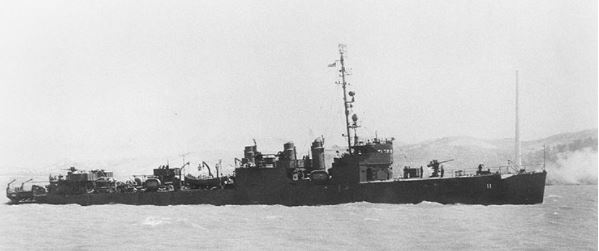
DD208 was also from Cramp, Philadelphia (9/1918, 26.4.1919, 10/1919). Shakedown off Florida-Caribbean, HP Rhode Island December 1919, Azores, Brest, station ship. Dalmatia, Italy July 1920, Constantinople, Crimea, Port Said, joined Asiatic Fleet, Philippines. San Francisco October 1922, decom. February 1923 to 20 February 1930 San Diego. TS for reservists until 9 April 1934. Overhaul Mare Island. Converted Nov. 1840 minesweeper DMS-11. Off Pearl on 7 December 1941 with Chandler for USS Minneapolis. Convoys to to San Francisco. Fiji, Minesweeping Group RADM Richmond K. Turner Amphibious Force, Solomon Islands campaign, Guadalcanal. III Amphibious Force, Empress Augusta Bay. HP Espiritu Santo, TU 34.9.3, convoys to TF 58. Pearl Harbor, flagship MinesRon 2 (W. R. Loud), Solomons, southern Palaus, Peleliu, invasion of Leyte, Luzon. 3 January 1945, Kamikaze attacks. 7 January, Kamikaze hit starboard beam. Sank, 229 rescued. Eight battle stars.
 USS Long (DD-209)
USS Long (DD-209)

DD209 was from Cramp, Philadelphia (9/1918, 26.4.1919, 10/1919). Shakedown East Coast, Mediterranean DesDiv 26, patrolled Adriatic-Mediterranean, station ship and Suez, then Philippines Asiatic station, Cavite 1921. Patrolled the South China Sea until July 1922. Decom. San Diego 30 December 1922 to 29 March 1930. PacFleet exercises, 1933, 1935 rotating Reserve DesRon 20. Nov. 1940 conv. minesweeper DMS-12. West Coast and, Hawaiian waters, MinesRon 2. 5 December 1941 screened USS Indianapolis. ASW patrols, escorts to Midway, Palmyra, Canton. June, Alaskan waters, collided USS Monaghan 27 July 42, rep. San Francisco. Kodiak, Adak, Amchitka, Invasion of Attu, Kiska. Escorts to Roi-Namur (Marshalls), joined TF 76 New Guinea. Admiralties, Guadalcanal, Espiritu Santo. Hollandia and Marianas Campaigns. Peleliu and Angaur. Philippines Campaign, Leyte Gulf. Sunk by kamikazes at Lingayen Gulf 2 January 1945 in the Mindanao Sea. Nine battle stars.
 USS Broomz (DD-210)
USS Broomz (DD-210)
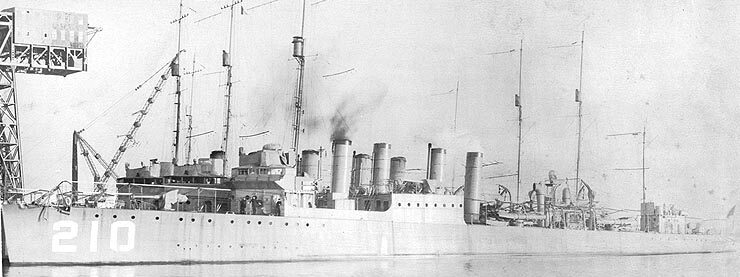
DD210 was from Cramp (10/1918, 14.5.1919, 10/1919). May 1920 convoys between English and French ports, Baltic Sea, Mediterranean. Reported to Cavite, HQ Asiatic Fleet. Decom. San Diego 30 December 1922 to 5 February 1930. PacFleet Ops to 1939. May HP Norfolk Atlantic Neutrality Patrols. 1941 DesDiv 63 on the East Coast. Convoys Iceland-US. January 1942 to May 1945, convoy escort, patrol, training East Coast. Trans-Atlantic convoys to North Africa (Torch) and UK. Redesignated AG-96 1945, striken, BU 1946.
 USS Alden (DD-211)
USS Alden (DD-211)

DD211 was from Cramp (10/1918, 7.6.1919, 11/1919). Shakedown, post-shakedown, dailed December 1919 to Europe, Med, Constantinople, Samsun. Adriatic spring 1920. Relief efforts Russian Civil War, Venice, Split and Gravosa, Salonika, Asiatic Station via Suez, Manila, Cavite. Operated off Chefoo, Shanghai, Yangtze River, Hankow. Back San Francisco 2 October, decomm. San Diego 24 January 1923 to 8 May 1930. DesDiv 46, DesDiv 10 HP San Diego. Returned to Chefoo and Philippines, observer Sino-Japanese 1937. Vladivostok, Augusta, Tsingtao, Philippines. Assisted SS President Hoover on Kasho-to. After Panay incident 12 December standguard for operations. Haiphong (French Indochina). South China Patrol Philippines. Eastern Fleet, directed to Batavia, Java, assigned Tom Phillips force Z, arrived too late. Singapore, Surabaya 15 December, Australian waters, Port Darwin with USS Houston. DesDiv 58. 20 January 1942 attacked I-123, escaped.
Attacked I-124, returned to Java, Tjilatjap, ABDA. Dept. 22 February for Surabaya. 27 February. Laid smoke, launched torps. at 1822. Retired eastward to Surabaya. DesDiv 58 night 28 February Bali Strait crossed Hatsuharu, Nenohi, Wakaba, and Hatsushimo, no fight. Arrived Austrlia, then back US west coast, overhaul Mare Island. Pacfleet escorts. Sent to Norfolk, convoys Casablanca. Sank U-544, defended UGS-36. OVL Boston, local escort duty. Collision with USS Hayter 31 January 1945, Rep. Norfolk. Escorted GUF-21. Decom. Philadelphia 15 July 1945, stricke, sold, BU 1945. 3 battle stars.
 USS Smith Thompson (DD-212)
USS Smith Thompson (DD-212)

DD212 was from Cramp (3/1919, 14.7.1919, 12/1919). Smith Thompson made her shakedown along the East Coast. 8 February 1920 to Mediterranean, Constantinople, Eastern Mediterranean, Black Sea. Left for Asiatic Station Philippines 29 June. Patrolled Japanese-Chinese waters. Assistance great Kanto Earthquake. Overhaul, East Coast-Caribbean service. 1926-1927 Special Service Squadron Nicaragua. 1928 Mediterranean, Adriatic. Chefoo September 1929, Philippine waters, Yangtze River Patrol, Shanghai. 14 April 1936 rammed amidships by Whipple (DD-217) towed back to Philippines, decommissioned Olongapo 15 May, stricken.
 USS Barker (DD-213)
USS Barker (DD-213)

DD213 USS Barker was from Cramp (4/1919, 11.9.1919, 12/1919). June 1920 sent to the Middle East, DesDiv 35 Turkish Waters. Suez Canal, to Philippines 1921 4-year Asiatic Fleet ToD.
Dept. Manila May 1925, Scouting Force east coast, Nicaragua, 10–31 January 1927. Until December 1941 Asiatic Station. December 1937 assisted SS President Hoover. 7 December 1941 was at Tarakan, Borneo. Patrolled Netherlands East Indies. 9 January 1942 Darwin-Surabaya escort. Battle of Bali (4 February 1942), Banka Island (15 February), damaged by near misses 15 February. Repair-overhaul Australia. Convoys San Francisco-Pearl Harbor. Hunter killer TG 21.12 (USS Core) Atlantic. Trans-Atlantic convoy escort to England and North Africa. Escort Caribbean, Newfoundland, Eastern seaboard, decom. Philadelphia 4 June 1945, 2 battle stars.
 USS Tracy (DD-214)
USS Tracy (DD-214)
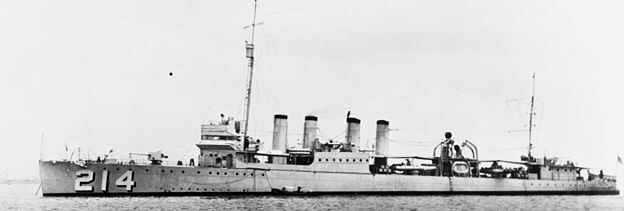
DD214 Tracy was from Cramp (4/1919, 12.8.1919, 3/1920). Shakedown Dry Tortugas, fixes Philadelphia, ass. DesDiv 39 Near East, Constantinople June 1920. Showed the flag, Black Sea, Palestine, Egypt, embarked refugees at Sevastopol. Suez Canal to Manila August 1921, Asiatic Sqn ToD. Assisted Great Kanto earthquake. San Diego refit (New FCS), New York City, 2 years Scouting Fleet, Nicaragua. OVL Norfolk, DesDiv 38, Northern Europe waters, then Portugal, Spain, Algeria, Tunisia, Italy. Back San Diego 1928-1929, plane guard for USS Lexington-Saratoga. DesDiv 45 Pearl Harbor, Asiatic Fleet routine. Redesignated DM-19 30 June 1937, converted, assigned MineDiv 1 Pearl Harbor.
7 December 1941 ovherhaul at berth 15, Pearl Harbor. Ops started 31 March 1942, minefield French Frigate Shoals, Fiji Islands, Espiritu Santo, Solomon Islands campaign with TF 62. TF 66, TF 62 for escort duty. Refit Mare Island. “milk run” convoys between Hawaii & West Coast. Bougainville. OVL San Francisco. Convoys Eniwetok-Pearl Harbor-San Francisco. Okinawa via Ulithi. Leyte, screen for TU 72.5.38. Back New York December 1945, decom. 19 January 1946. 7 battle stars.
 USS Borie (DD-215)
USS Borie (DD-215)

DD215 Borie was also from Cramp (4/1919, 4.10.1919, 3/1920) and she served in the Black Sea, Asiatic Fleet, Caribbean, was in 1940-41 neutrality patrols and in 1942, the Battle of the Atlantic. She was part of Hunter-killer Group TG 21.14 earning a Presidential Unit Citation for “extraordinary performance.” She also had an epic duel with U-405 in November 1943, with a good old fashioned near-boarding, small arms fire at point blank with and ramming although crippled and later scuttled. In addition to 3 battle stars, Borie crewmembers were awarded three Navy Cross medals, two Silver Star medals and one Legion of Merit medal.
 USS John D. Edwards (DD-216)
USS John D. Edwards (DD-216)

DD216 was from Cramp (5/1919, 18.10.1919, 4/1920). After shakedown she patrolled and was a station ship in Turkish waters by 1920. She sailed for the Asiatic Squadron, patrolled between Philippines winter and China summer. Assisted earthquake 1923 Yokohama. Refit New York, HP Norfolk East Coast-Caribbean, Med 1927, San Pedro, Pacific Fleet to August 1929. Back Asiatic Fleet. Yangtze River Patrol, South China sea Neutrality patrols. Was in Borneo, to search for survivors of Prince of Wales. Patrol, escort, ASW operations Netherlands East Indies, DesRon 29, battle of Bali, Tjilatjap. 20 February engaged Japanese destroyers and back to Surabaya. ABDA, Battle of the Java Sea. Back to Australia 28 February after brief duel with Japanese ships. Pearl Harbor June, escorted convoys with San Francisco. Atlantic patrols to Europe and North Africa 9 months. Decom. Philadelphia 28 July 1945. 3 battle stars.
 USS Whipple (DD-217)
USS Whipple (DD-217)
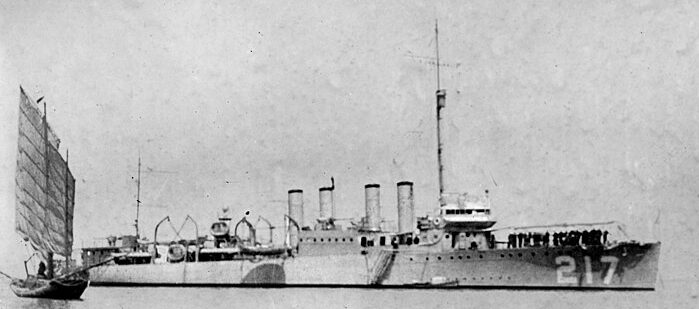
DD217 Whipple was from Cramp (6/1919, 6.11.1919, 4/1920). Shakedown, training off Cuba, Near East 29 May 1920, Constantinople 8 months, Black Sea, eastern Med. Russian Crimea, Constanţa, Port Said, Suez Canaln Bombay, Colombo, Batavia, Singapore, Saigon, Cavite for the Asiatic Fleet until May 1925. East Coast HP Norfolk. Nicaragua. Northern European tour, Mediterranean, Cuba 1928, West Coast, Pacific fleet HP San Diego until 1 August 1929. Asiatic Fleet until September 1939. November 1941 DesDiv 57 in Manila Bay. Netherlands East Indies campaign, ABDA. Assisted Langley, Pecos. Melbourne 23 March 1942, operated with RAN-RNZN. Convoy escort duties. Pearl Harbor-San Francisco, modernized 1943. Norfolk-Guantanamo Bay-Panama Canal Zone, Hunter Killer Group USS Guadalcanal. 1944-1945 convoy escort duties east coast to Casablanca and Caribbean. AG-117 1945, target ship for submarines off New London, conv. high-speed target vessel. Pacific, Pearl Harbor 30 August until 21 September. Decom. 9 November 1945. 2 battle stars.
 USS Parrott (DD-218)
USS Parrott (DD-218)
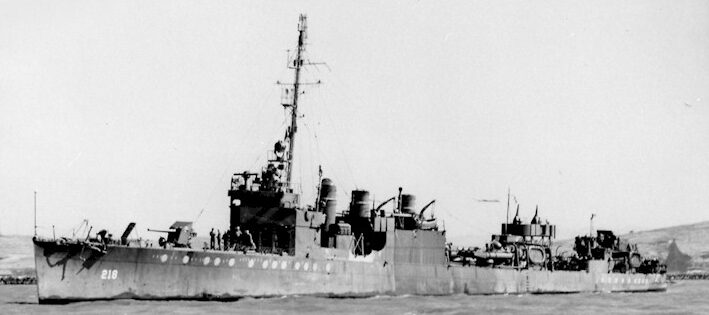
DD218 Parrott was from Cramp, Philadelphia (7/1919, 25.11.1919, 5/1920). After shakedown, Europe, Turkish waters (notably evacuations Smyrna, political refugees). Operated PacFleet until 1939 and 1941, convoy escort in 1942. Saw one combat with Japanese convoys escorted by torpedo boats (all transports, 1 TB sunk). Used as AA escort in many amphibious landings and later transatlantic ASW Hunter Killer combat groups. Collided with SS John Morton May 2, 1944, towed to Norfolk, decom. 1944. 2 battle stars.
 USS Edsall (DD-219)
USS Edsall (DD-219)
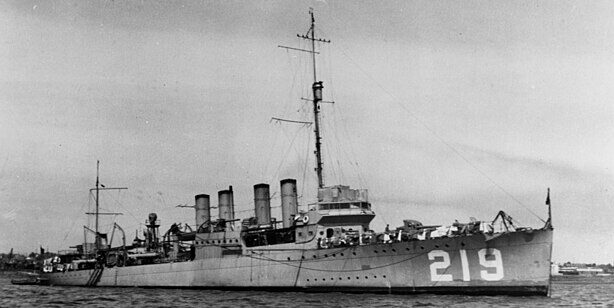
DD219 Edsall was from Cramp (9/1919, 29.7.1920, 11/1920). Philadelphia 6 December 1920 to San Diego shakedown. West Coast TOD, then HP Charlesto, Mediterranean, Constantinople. Back to Boston OVL 26 July 1924. Asiatic Fleet January 1925. 25 November 1941 DesDiv 57 in Balikpapan, Borneo. Batavia, Singapore, missed Force Z. Searched for HMS Prince of Wales and HMS Repulse‘s survivors. Joined USS Houston at Surabaya 15 December 1941. Escorted oiler USS Trinity (AO-13), attacked I-123. ABDA to Tjilatjap. 26 February met USS Langley, assisted after sunk. Assisted USS Pecos. Java Battle: Edsall engaed by the bulk of the fleet, probably most hits from IJN Tone, sank 17:31 hrs 1 March 1942 off Xmas island. Most survivors executed as POW. 2 battle stars.
 USS MacLeish (DD-220)
USS MacLeish (DD-220)
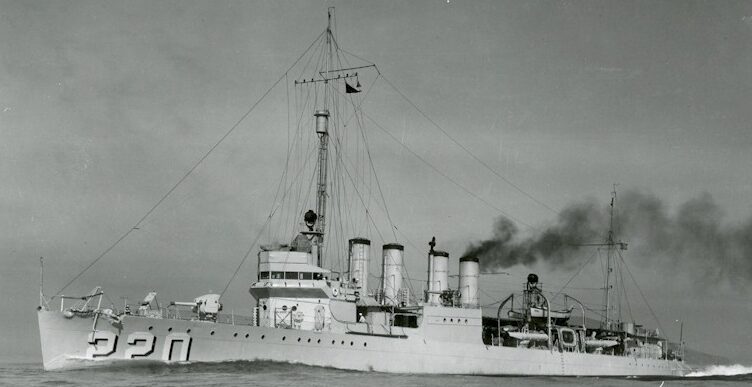
DD220 MacLeish was from Cramp (8/1919, 18.12.1919, 8/1920). She served briefly with the Pacific Fleet, and in Turkish waters until June 1924. Black Sea, eastern Mediterranean, Smyrna. Refit Boston, West Coast TOD, Asiatic Fleet. Landing in Shanghai 1925 and service until March 1938, decom. Reserve San Diego,, recom. 25 September 1939, eastern sea frontier. January 1941 modernized, Atlantic convoys, North Atlantic patrol, coastal patrol (probable kill), escorted 12 convoys Norfolk-Key, 9 New York-Guantanamo Bay, 2 New York-Casablanca. Escort carrier group 7 months, 3 probable sinkings. 1944 target ship for marine torpedo planes off Key West. OVL, Mediterranean Flagship TF 63. Cherbourg, the Pacific. January 1945 AG-87 Boston, Panama target ship. Decom. 8 March 1946, 1 battle star.
 USS Simpson (DD-221)
USS Simpson (DD-221)
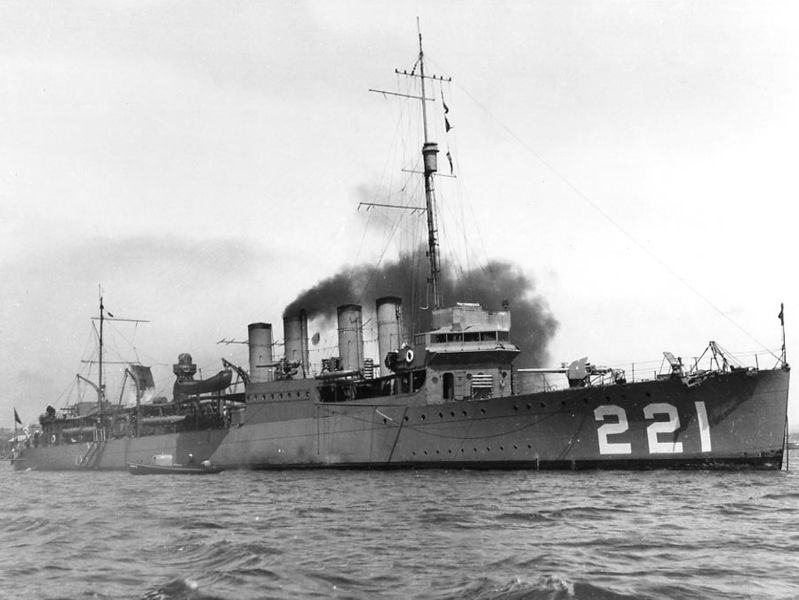
DD221 Simpson was from Cramp (10/1919, 28.4.1920, 11/1920). Training PacFleet, travelled Chile. Panama December 1921, overhaul Philadelphia, HP Newport, Mediterranean June 1922, Turkish waters. Overhaul at Norfolk, West Coast, Pacific, Asiatic Fleet, Chefoo June 1925, Manila. Overhaul Mare Island 1932, West Coast ex. 1936, 1937, and 1938. March 1939 Panama Canal, Atlantic, Neutrality Patrols Caribbean. Escorted convoys North Atlantic from NS Argentian Greenland, Iceland, British Isles, transatlantic convoys until April 1942, mod. Boston. Casablanca February 1943. OVL New York, escorts New York-West Indies-Ireland. August 1943 USS Santee escort carrier TG Bermuda-Casablanca. East Coast convoys 1944-1945, escorted USS Wisconsin and Missouri, Alaska, Ticonderoga and Antietam. Decom. 29 March 1946.
 USS Bulmer (DD-222)
USS Bulmer (DD-222)
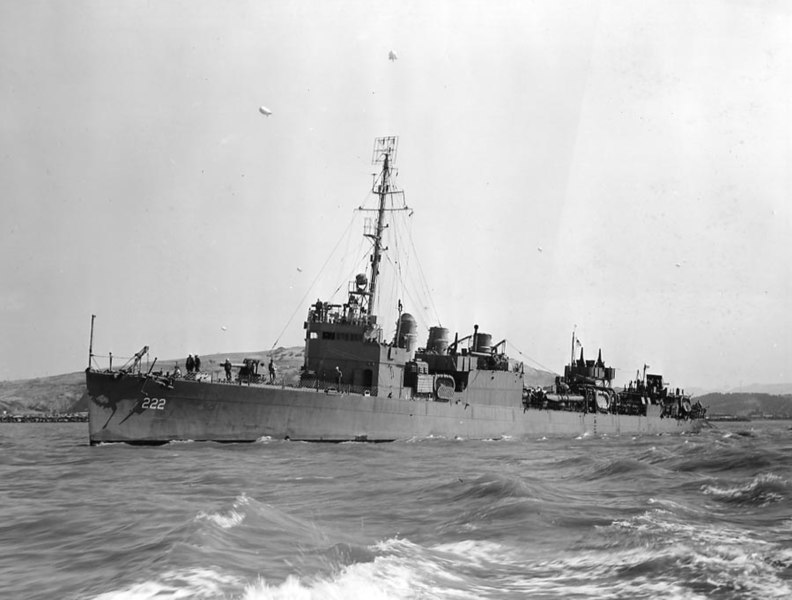
DD222 Bulmer was from Cramp (8/1919n 22.1.1920n 8/1920). Pacific Fleet San Diego, 1923 Turkish Waters. 1925 Asiatic Fleet, DesRon 5, DesDiv 14 winter Manila, summer Chefoo. 1939, assigned South China Patrol, DesRon 29, DesDiv 58, Neutrality Patrols under 16th Naval District. January 1941 Asiatic Fleet Problem. Stationed Philippines 1942, patrol, escort southwest Pacific, 9 January 1942 with USS Bois and USS Marblehead, Stewart, Pope, Parrott, Barker Darwin to Surabaya (Pensacola Convoy) and to Java. Parrt of TF 5 DesRon 29, Battle of Bali Sea 4 February 1942. To Australia, overhaul. Pearl Harbor, June 1942 to May 1943 escort Pearl Harbor-San Francisco. New York, Atlantic TG 21.12 from 14 June to 22 September, sank U-487 on 13 July.
Trans-Atlantic voyages, northeastern Atlantic-North Africa until July 1944. Probable kill U-377. Until October 1944 Narragansett Bay, AG-86 1 December 1945, Panama training duty with submarines.Target ship for Cdr Air Force Atlantic Fleet Port Everglades,. Decom. 16 August 1946. 2 battle stars.
 USS McCormick (DD-223)
USS McCormick (DD-223)
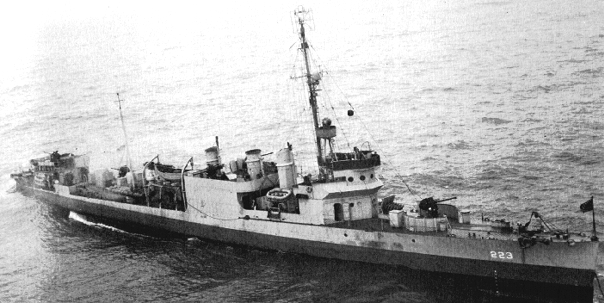
DD223 McCormick was from Cramp (8/1919, 14.2.1920, 8/1920). Shakedown, DesRon 5 PacFleet, then East Coast, European Waters, eastern Mediterranean until 1924. Asiatic Fleet 1925, flagship for DesDiv 39, 14, Yangtze River Patrol, South China Patrol until 1932. Decom. San Diego 14 October 1938 to 26 September 1939, Neutrality Patrol Atlantic. Convoys to Iceland and Atlantic: Halifax-Londonderry and Casablanca. Escort convoys until 5 December, joined USS Croatan TG 27.4 to Casablanca and back, OVL New York. Natal (Brazil) Casablanca, escorting Albemarle. April 1944 HP Boston, ASW patrols, transatlantic convoy and to North Africa, escorting HX 158, ON 37, HX 165, ON 51, HX 172, ON 65, HX 183, ON 89. Auxiliary with SubRon 3 Panama Canal Zone. 30 June 1945 AG-118; Decom. Boston October 1945.
 USS Stewart (DD-224)
USS Stewart (DD-224)

DD224 Stewart was from Cramp (9/1919, 4.3.1920, 9/1920). She had a most unisual fate, being in the Asiatic Sqn. in the interwar, taking part in Netherlands East Indies early 1942 operations, scuttled 2.3.1942, recommissioned by Japan as 102-go (P102). Captured 1945, re-commissioned 10.1945 and stricken 4.1946 (see above).
 USS Pope (DD-225)
USS Pope (DD-225)
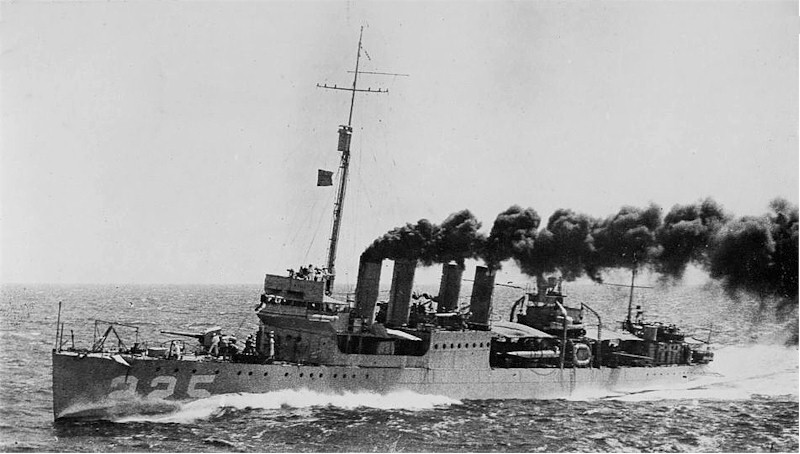
DD225 Pope was from Cramp (9/1919, 23.3.1920, 10/1920). Placed in reduced commission at Philadelphia, DesRon, DesDiv 39 Atlantic Reserve Fleet, HP Charleston-Newport. Refit, PacFleet via Gibraltar, Suez Canal, DesRon 15, DesDiv 43 Asiatic Fleet Chefoo, Cavite. Exercizes, manoeuvers, port visits. Evacuation US Citizens Tsingtao to Shanghai September 1937. South China Patrol force, Swatow, Pehtaiho, DesDiv 59 to 6 May 1940. Dec. 41 sent to Balikpapan, Dutch East Indies.
9 January 1942 escort Darwin-Surabaya, naval battle of Balikpapan, Second Battle of the Java Sea. Fired all of her torpedoes and 140 salvoes.
1 March 1942, spotted by Ryūjō’ss plane attacked by six “Val”, near miss (port engine shaft bent, flooding). Six more attacked, became controllable, caught and sunk by Japanese cruisers. Survivors rescued by IJN Inazuma. Stricken 8 May 1942. 2 battle stars, Presidential Unit Citation, XO R. Antrim earned the MoH..
 USS Peary (DD-226)
USS Peary (DD-226)

DD226 Peary was from Cramp (9/1919, 6.4.1920, 10/1920). She served in the Far East from 1922, was part of the Yangtze River Patrol 1923-1931, and spent most of the time in Chinese waters, protecting American interests until 1939, as situation degraded with Japan from 1962 onwards. She was in Cavite when the attack on Pearl Harbor took place. On 10 December, air raid over Cavite. She took one bomb forward (killed 8) fires set off torpedo warheads, torpedo overhaul shop, towed out by Whippoorwill. New near miss 26 December 1941 underway. 27 December Campomanes Bay Negros Island camouflaged with green paint, palm fronds, not spotted. Made it to Celebes Sea, Makassar Strait, but spotted next morning. Two-hour attack with 500-pound (230 kg) bombs and torpedoes. Dodged, escaped to Darwin, Australia. ASW patrol, escort. 19 February 1942 Darwin air attack. Struck by five bombs. Sunk with 88 officers and men, first destroyer of the Asiatic Fleet sunk in WW II, stricken 8 May 1942.
 USS Pillsbury (DD-227)
USS Pillsbury (DD-227)

DD227 Pillsbury was from Cramp (10/1919, 3.8.1920, 12/1920), service in the Asiatic Fleet, was at the 1927 Nanking Incident. 27 November 1941, departed Manila. Was at Borneo on 7 December 1941. Operated off Balikpapan, Surabaya, escorted USS Houston (CA-30), Marblehead (CL-12) with DesDiv 58. From February joined ABDA, Battle of Badoeng Strait, fired three torpedoes at a Japanese ship at night, escaped under smoke. Later hit and disabled a Japanese ship. Pillsbury and Parrott were detached to Tjilatjap, having few torpedoes, ammo and needed an overhaul. Pillsbury never get there. She was lost like Asheville (PG-21) and Edsall south Java, Xmas island. 2 battle stars.
 USS John D. Ford (DD-228)
USS John D. Ford (DD-228)

DD228 was from Cramp (11/1919, 2.9.1920, 12/1920). Trials off New England, training Caribbean, dept. June 1922 for Asiatic Fleet via Mediterranean, Suez Canal, Indian Ocean. 1924, she helped establish temporary air bases in the Kurile and Hokkaidō. Evacuated US citizens and watched developments Chinese Civil War, notably after July 1937. Manila 21 November 1938, Neutrality patrols from Sept. 1939. DesDiv 59 Dec. 41, Undamaged in Manila Bay, dept. Sulu Sea, Makassar Strait TF6. Balikpapan, Surabaya. Dept. January 1942 for Kupang, Timor. Night raid on Japanese transports and she trorpedoed IJA transport Kuretake Maru, retired Surabaya. Convoy to Tjilatjap. Battle of Badung Strait. Surabaya, ABDA, Battle of Java Sea, back to Surabaya with DesDiv 58, dept. for Australia. Brisbane, Pearl Harbor, convoys to San Francisco, then ASW patrols in the Atlantic. Convoys to Recife, Reykjavík, Casablanca. Norfolk, decommissioned 2 November 1945, 3 battle stars.
 USS Truxtun (DD-229)
USS Truxtun (DD-229)

DD229 Truxtun was from Cramp (12/1919, 28.9.1920, 2/1921), completed shakedown, east coast, Atlantic Fleet DesDiv 39, DesRon 3, then DesDiv 43, DesRon 15. Sent to Asiatic Fleet, dept. June 1922 via Suez, Indian Ocean, DesDiv 43, Chefoo, Manila routine 10 years. 1926-1927 Yangtze Patrols. Refit 1932 Mare Island, PacFleet Alaska-Panama, HP San Diego, Eeastern seaboard. 27 April 1939 Norfolk, DesDiv 27 Atlantic. Neutrality Patrols. Refit Norfolk Dec. 1940, DesDiv 63 Halifax. Convoys Argentia-Reykjavík, HX-168, ON-57. 18 February escort to USS Pollux off Newfoundland, ran aground in howling gale close St. Lawrence, Chambers Cove. Broke, 110 lostf, stricken 25 March 1942.
 USS Paul Jones (DD-230)
USS Paul Jones (DD-230)
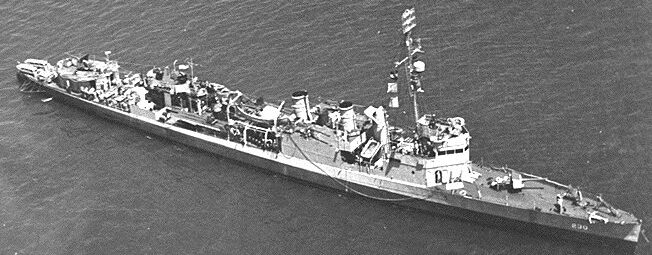
DD230 Paul Jones was from Cramp (12/1919, 30.9.1920, 4/1921). Shakedown, Atlantic Fleet, Pacific 1923, Asiatic Fleet, Yangtze River Patrol, China coast from Manila. Flagship DesRon 29 December 1941 at Tarakan, Borneo. Led USS Marblehead, Stewart, Barker, Parrott for Makassar Strait, Lombok Strait, Soerabaja. Joined raiding group (John D. Ford, Pope, Parrott, Marblehead, Boise) raid Balikpapan, battle night 23/24 January. 5 February off Sumbawa to Timor, attacked by IJN Japanese bombers, dodged approx. 20 bombs while USS Tidore total loss. Arrived at Java, joined ABDA, 27 February Battle of the Java Sea. Spent all torpedoes, low on fuel, arrived in Soerabaja. To Fremantle 4 March. Melbourne, San Francisco, convoy escort duty California-Pearl Harbor until March 1943.
Next North African ports, ASW patrol Chesapeake Bay. Panama Canal Zone until 6 April 1945. Escorted tanker group via Azores to Casablanca. Norfolk, plane guard USS Lake Champlain until 4 August. Deactivated Norfolk, AG–120 30 June 1945; 5th Naval District, decom. 5 November 1945.
 USS Hatfield (DD-231)
USS Hatfield (DD-231)
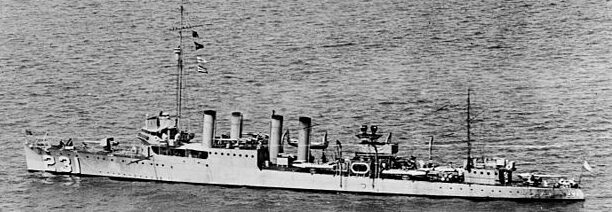
DD231 Hatfield was from New York SB (Camden) naval yard (6/1918, 17.3.1919, 4/1920). Training cruises summer 1920, Brooklyn September for Key West. January-April Caribbean. Fleet Reviw Pdt. Warren G. Harding 28 April. DesDiv 14 Atlantic Fleet, HP Charleston, Mediterranean, Turkish waters. U.S. Scouting Fleet 7 years East Coast. Philadelphia decom. 13 January 1931-April 1932, rotating reserve, HP San Diego. 27 April 1936 cruise Spain, France, Italy, Algiers. Charleston, decom. 28 April 1938 to 25 September 1939, Neutrality Patrols to August 1940. 13th Naval District until 11 December 1941, Alaska. Convoys to Alaska. March 1944 HP Seattle, ASW duties, overhaul Puget Sound, target-towing vessel AG-84 October 1944. Port Angeles, Washington, San Diego for bombing practice. Bremerton, decom.13 December 1946.
 USS Brooks (DD-232)
USS Brooks (DD-232)

DD232 was from New York SB (6/1918, 24.4.1919, 6/1920). Philadelphia, European waters August 1920, Baltic Patrol, Adriatic Sea, Turkish waters June 1921 back NyC September 1921, Scouting Fleet Caribbean-Atlantic-Pacific. Decom. Philadelphia January 1931-June 1932, Scouting Force. Decom. September 1938-25 April 1939, Neutrality Patrol Atlantic 13th Naval District November 1940. Escort ship California-Washington-Alaska. 20 September 1942 Seattle, conversion high-speed transport APD-10, South Pacific. Transport and minesweeper Lae (New Guinea) September 1943, Finschhafen, Cape Gloucester (New Britain) Saidor (New Guinea), Admiralty Islands, Hollandia, Saipan, Leyte occupation, Mindoro invasion, Lingayen Gulf landings. On 6 January 1945 hit by Japanese kamikaze, port side, fire, flood. 3 killed, 11 wounded, then hit by aerial torpedo 7 January. Towed to San Pedro, California, decom. 2 August, sold. Navy Unit Commendation, 6 battle stars.
 USS Gilmer (DD-233)
USS Gilmer (DD-233)
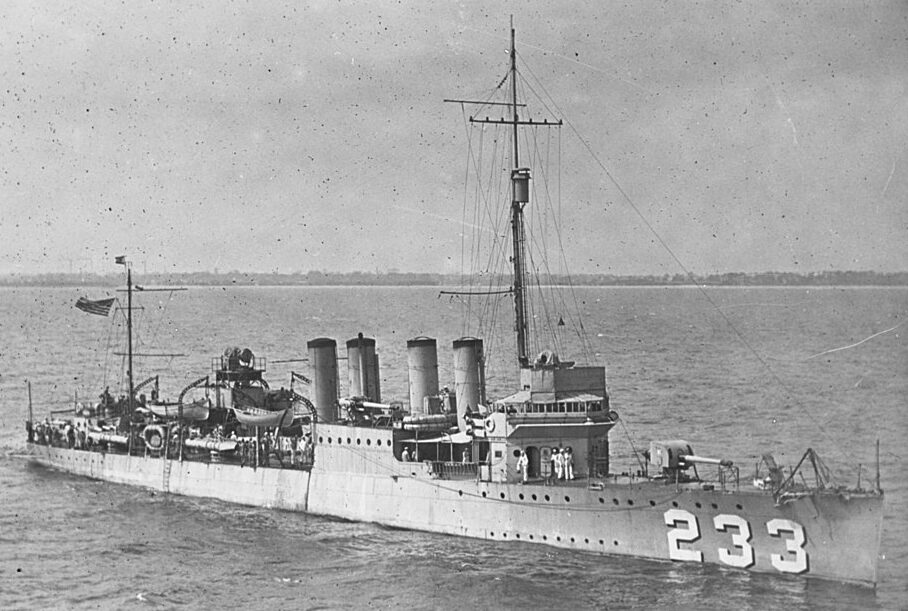
DD233 Gilmer was from New York SB (6/1918, 24.5.1919, 4/1920). August 1920-August 1923 transatlantic voyages, Europe, Mediterranean. Damaged storm Adriatic November 1920. Repaired Pola, Training East and West Coast until 1938 and expedition to Nicaragua 1926. Decom. Philadelphia 31 August 1938 to 25 September 1939, flagship DesDiv 30, Atlantic Squadron, 13th Naval District 1940, Atlantic-Caribbean. San Diego November 1940, PacFleet Puget Sound on 7 December 1941. ASW patrol, escort. June 1942 Aleutian campaign. Refit November 1942, converted high-speed transport APD-11 by January 1943. Seattle via San Diego, Pearl Harbor, escort to Espiritu Santo in March, trained with 4th Marine Raiders Battalion.
Flagship, Transport Division 16, Nouméa, Townsville Australia, Brisbane in May-June 1943 and to New Guinea until 4 September 1943. Assault on Huon Peninsula (Lae, New Guinea). Supported allied New Guinea campaign. 26 December 1943 Cape Gloucester assault, Finschhafen, Saidor, Buna. Shelled Humboldt Bay (New Guinea) 22 April 1944. Hollandia, embarked UDT at Pearl Harbor June 1944 Saipan. Sank 4 Japanese cargo ships, taking prisoners. Shelled Tinian. ASW patrols, sank I-55. Pearl Harbor, until January 1945 demolition and reconnaissance training with UDT teams. 24 February Leyte, Okinawa operation March 1945 as flagship UDTs. Kamikaze hit, moderate. Supported invasion until 9 April, Pearl Harbor, Okinawa 4 July. Nagasaki 13 September, Okinawa, escort troopships with Chinese 13th Army to Chinwangtao. Tsingtao 26 November, decom. Philadelphia 11 January 1946. 7 battle stars.
 USS Fox (DD-234)
USS Fox (DD-234)
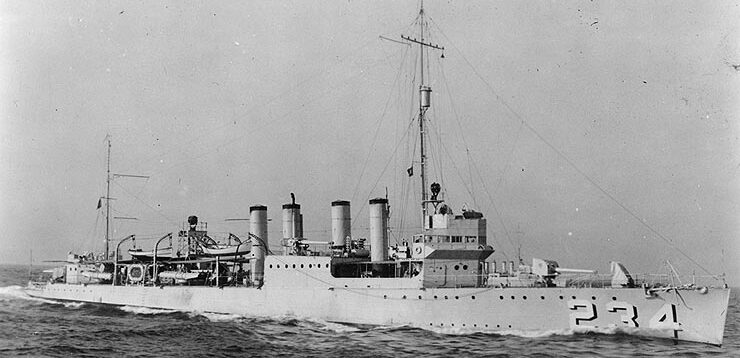
DD234 Fox was from New York SB (6/1918, 12.6.1919, 5/1920), Philadelphia 20 August 1920, Newport, Mediterranean, Constantinople, Turkish waters. Eastern Mediterranean-Black Sea until July 1922. Back Philadelphia overhaul, Norfolk October 1922 to Constantinople until 18 July 1923, back New York. Scouting Fleet 3d Naval District, TS Naval Reservists. Decom. Philadelphia 2 February 1931, rotating reserve April 1932, full commission june, DesDiv 1, HP Hampton Roads. West Coast via Panama, San Diego. 1932-1938 PacFleet. Decom. Philadelphia 16 September 1938-25 September 1939. Atlantic Squadron, escort patrol duty Atlantic coast-Caribbean to August 1940. Canal Zone inshore patrol duty. San Francisco, 12th Naval District. Seattle, Washington and Oregon coast with 13th Naval District until December 1941. Alaska as escort. OVL Puget Sound, ready duty ship, escorts to San Pedro until 10 May 1942.
Modernized Seattle July–September. October 1942 escorted convoy of four Soviet submarines to San Francisco. May 1943 patrol-escort to Alaska. HP San Diego. September 1944 OVL Puget Sound, AG-85 Seattle-San Francisco, target ship NAS Alameda until September 1945. Decom. Norfolk 29 November 1945.
 USS Kane (DD-235)
USS Kane (DD-235)
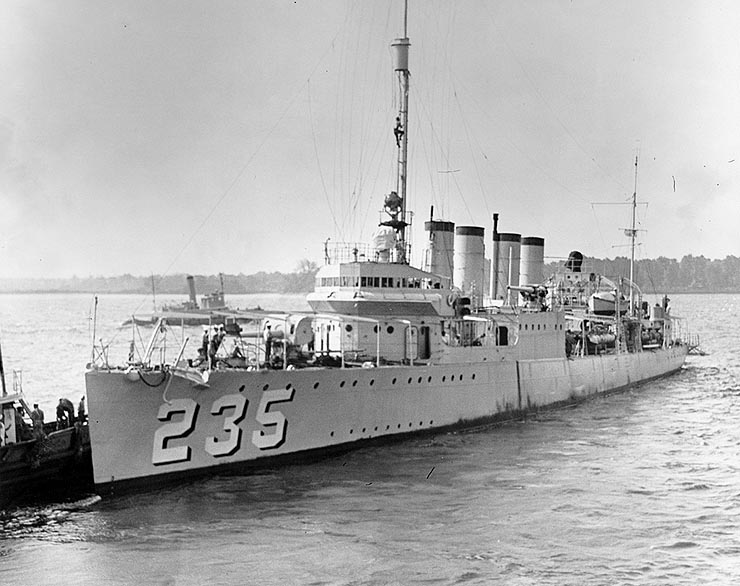
DD235 Kane was from New York SB (7/1918, 12.8.1919, 6/1920), and started her career from Newport in August 1920, shakedown to Gibraltar, Brest, Copenhagen, Danzig, Gulf of Riga. Hit a mine, port engine shafts, port propeller struts damaged. Repaired Landskrona, overhaul Chatham. To Mediterranean, Constantinople, Turkish waters, DesDiv 14 until 18 May 1923. East Coast, 1925 training cruise to San Diego, Pearl Harbor. 1927 exp. Nicaragua, Honduras, decom. Philadelphia 31 December 1930 to 1 April 1932. HP San Diego for 4 years. August 1936 detached to Spain (American citizens, civil war). 30 August off Bilbao, fired on an airplane dropping bombs too close. 1936 flagship Sqn. 40-T (RADM Arthur P. Fairfield). Back home late 1937, decom. Charleston April 1938-23 September 193. Neutrality Patrols North Atlantic, Panama. San Diego November 1940, California patrols. OVL Puget Sound until 3 March 1941, Seattle, patrols to Alaska. Based Kodiak, escorted troop transports and inter-island convoys 1942. 3 August 1942 attacked by high-altitude Japanese bombers. Seattle, mod. as APD-18 25 March 1943 to 3 April 1943. Took part in op. to Attu joining commandos landed by Narwhal and Nautilus. From 18 January 1944, 5th Amphibious Force, Marshall Islands, Majuro Lagoon, Milne Bay (New Guinea), Admiralty Islands. Solomon Islands, Saipan 15 June 1944. Carried UDT 4. 23 June dodged aerial bomb. Guam 17 July 1944. Leyte Gulf 18 October. Overhaul San Pedro 4 December.
Dpt. 20 April 1945 with UDT 24 to Kerama Retto. Philippine Sea Frontier in July until late August 1945. Decom. Philadelphia 24 January 1946. 7 battle stars.
 USS Humphreys (DD-236)
USS Humphreys (DD-236)
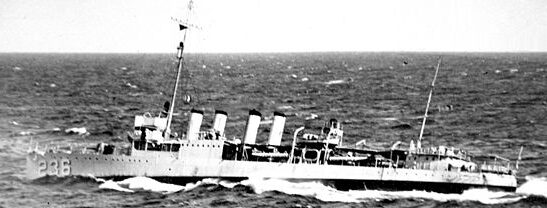
DD236 was from New York SB (7/1918, 28.7.1919, 7/1920). Shakedown New England, 14 August Mediterranean, Turkish waters, black sea Russian Revolution. Palestine, Egypt, back Newport 23 August. Atlantic-Caribbean training, Panama 21 January 1925 to San Diego alt. Training Caribbean. Decom. Philadelphia 10 January 1930 to 13 June 1932. West Coast manoeuvers, fleet problems. 1934 New York fleet exercises east coast and Haiti. San Diego, screen ship/plane guard, decom. San Diego 14 September 1938 to 26 September 1939. Neutrality Patrol Caribbean, sound school Newport. San Diego, ASW training. Coastal escort ship San Pedro-Seattle and Alaska, Aleutian Campaign. 11 November 1942 Mare Island, high-speed transport APD-12 December 1942. Noumea 22 January 1943, Guadalcanal, Tulagi, Solomon Islands. Operation Chronicle (Woodlark-Kiriwina landings). New Guinea, 7th Fleet Amphibious Force. OVL Brisbane. Buna-Gona, Lae, Finschhafen, New Britain, Cape Gloucester. Philippines Campaign, Leyte, Luzon, carried UDT team. RAS Ulithi. From 23 January 1945 screen logistics groups RAS forces for TF 58 (5th Fleet escort carriers). Iwo Jima, Okinawa. Bacl Pearl 4 June, San Diego, DD-236 20 July, decom. 26 October. 7 battle stars.
 USS McFarland (DD-237)
USS McFarland (DD-237)
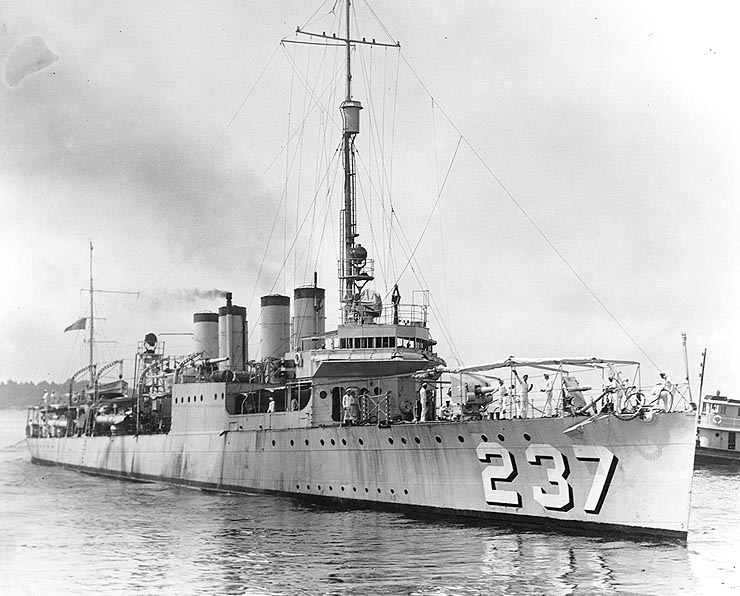
DD237 USS McFarland was built in New York SB, Camden (7/1918, 30.3.1920, 9/1920). Atlantic Fleet, European waters 30 November 1920, 2 months English Channel, Gibraltar January 1921, Split, Adriatic Detachment, Constantinople, Turkish Waters Detachment, Black Sea, eastern Mediterranean until 1923. New York September 1923, Scouting Fleet HP Newport, 17 years. Decom. Philadelphia 1931 to August 1940 conversion as AVD-14 seaplane tender, Pacific Fleet. 7 December 1941 ASW maneuvers off Maui. 7 months from Pearl Harbor, to Palmyra Atoll, Johnston Islands. South Pacific 2 June 1942, Guadalcanal offensive, based Espiritu Santo–Santa Cruz Islands. 16 October attack in Lunga Roads 9 dive bombers. Damaged, awarded Presidential Unit Citation. Tulagi harbor, makeshift repairs, Espiritu Santo, Pearl Harbor 29 December to 17 April 1943. DD-237 1 December 1943 from San Diego, operated with aircraft carriers training, pilot qualification. 30 September 1945 east coast, decom. Philadelphia 8 November 1945. 2 battle stars, 2 UPC.
 USS James K. Paulding (DD-238)
USS James K. Paulding (DD-238)
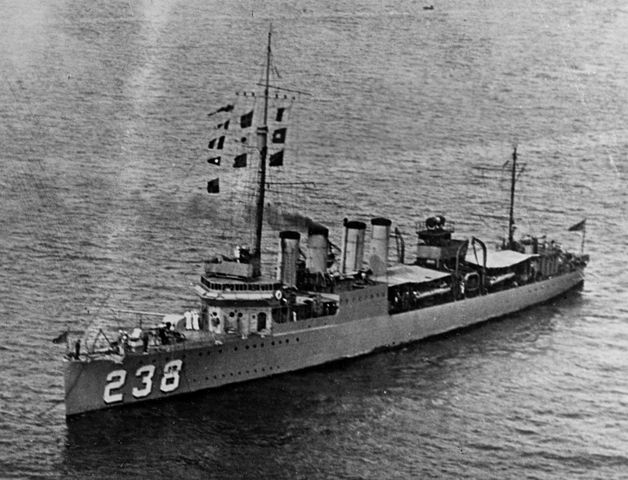
DD238 James K. Paulding was built at New York SB, Camden (7/1918, 20.4.1920, 11/1920). Shakedown, Atlantic Fleet exercises, HP Newport 31 May 1921, Charleston until late 1922. Scouting Fleet January 1923. February 1925 San Diego, Pacific. Newport, Scouting Fleet, Caribbean 1926, Nicaragua expedition 1927. Reserve training Atlantic-Caribbean. Decom. Philadelphia 10 February 1931, hulk 28 December 1936 (London treaty limitation) struck 25 January 1937.
 USS Overton (DD-239)
USS Overton (DD-239)

DD239 Overton was from New York SB (10/1918, 10.7.1919, 6/1920). After shakedown, DesRon 3, DesRon 5 East Coast. Rescue crew USS S-5. DesRon 2 European waters. Black Sea Detachment, Constantinople 5 October 1920. July 1922 back home, Scouting Fleet, returned for Ottoman-Greek hostilities, 6 months TOD. May 1923 Italy, New York City. 8 years more Atlantic exercises with 2 deployments 1925 and 1926 Pacific fleet problems. Decom. 3 February 1931, 1932 rotating reserve commission, decom. 20 November 1937 to 26 September 1939, Neutrality Patrol. HP Boston December 1941. Convoy escort to Gulf of Mexico, Caribbean, East Coast, Casablanca. OVL June 1943, Task Group 21.11 USS Santee (CVE-29). Co-claimed U-160 and U-43. Escorted HX 155, ON 31, HX 170, ON 61. Norfolk August 1943 converted high-speed transport APD-23, complete October 1943.
Pacific, Pearl Harbor November 1943 for training. Advance Southern Transport Group, Battle of Kwajalein. OVL USA; back May 1944, Battle of Saipan. Until 24 June 1944 screened transport, patrolled off Tinian. Battle of Tinian; covered LCTs bound for Guam or Pearl Harbor. September 1944 to Manus, then Philippines with UDTs to Leyte. Invasion of Lingayen Gulf, New Guinea with UDT personnel. Ulithi, screened Fast Carrier TF logistics support group. Patrolled off Iwo Jima March 1945. Convoy duty to Okinawa, radar picket station until 15 April 1945. Back San Francisco 15 May 1945, decom. Philadelphia 30 July. Earned 9 battle stars.
 USS Sturtevant (DD-240)
USS Sturtevant (DD-240)
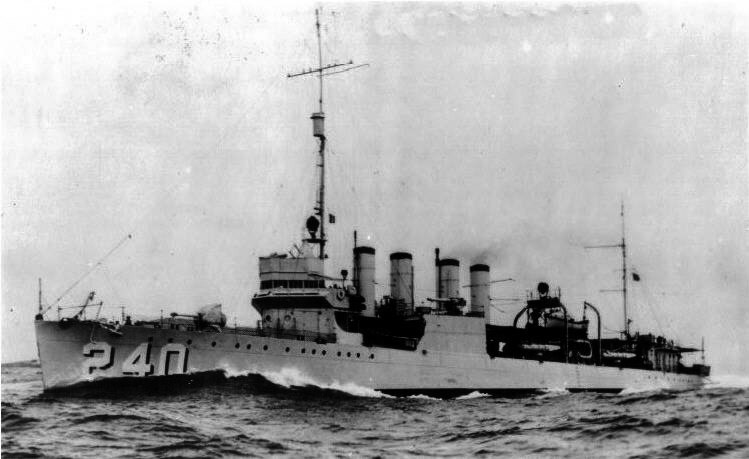
DD240 Sturtevant was from New York SB, Camden (11/1918, 29.7.1920, 9/1920). HP Newport, New York City, departed for European Waters via Gibraltar, Adriatic Sea. Split, 6 months. June 1921, Constantinople detachment. July–October, returned home, OVL New York Navy Yard. Back to eastern Mediterranean. Back New York, Atlantic seaboard, flagship DesDiv 41 Scouting Fleet. Panama, fleet problem. Back Carribean. Then San Diego-San Francisco, Pearl Harbor. Back Atlantic, then Pacific again and back Atlantic and same in 1926-1931 with DesDiv 41, DesRon 14. HP Charleston, decom. January 1931 Philadelphia to 9 March 1932. 1935, Battle ForcePacific. Mid-1940 Atlantic escort, Neutrality Patrols HP Norfolk until March 1942. Escorted HX 155, ON 31, HX 162, HX 169, ON 59. 26 April 1942 off Key West, violent explosion. Believed U-Boat, dropped DCs. Sank 8 mi north of Marquesas Keys, 15 lost. (Causded by unnotified US minefield). Stricken 8 May 1942.
 USS Childs (DD-241)
USS Childs (DD-241)

DD241 Childs was from New York SB (3/1919, 15.9.1920, 10/1920). After shakedown, dept. for Gibraltar 14 February 1921, served in Mediterranean, Adriatic, North, and Baltic Seas until 25 November, Constantinople. Relief mission to Russia 1922, Black Sea diplomatic duties. Cherbourg, Philadelphia 29 July. Training Atlantic coast-Caribbean until 14 February 1925 and Hawaiian Islands. 6 April 1929 collided with four-masted schooner A. Ernest Mills off North Carolina, the latter sank, she was repaired. San Diego, flagship DesDiv 8, Rotating Reserve, Pacific Northwest and Alaska 1935.
OVL east coast. Training Hawaiian Islands before 1938. Philadelphia, conv. seaplane tender AVP-14. Fleet problem 1939. HP Pearl Harbor, operated off Midway, Wake, Guam until 1 October 1940. Became AVD-1, Asiatic Station, Cavite. Was in OVL on 10 December 1941 when IJN aor raod, escaped by evasive maneuvering and later invading fleet in a rain squall. Surabaya, Seaplane Base Exmouth in Australia 28 February 1942. Tender duties until 12 August 1944. West coast OVL, training west coast, decom. 10 December 1945.
 USS King (DD-242)
USS King (DD-242)

DD242 King (named after Commander Frank Ragan King which died while conducting minesweeping operations shortly after WWI.) was built at New York SB, Camden (4/1919, 14.10.1920, 12/1920). Post shakedown-training, Atlantic Coast, HP Hampton Roads October 1921, departed for Mediterranean cruise. Smyrna intervention 8 November, station ship, Greco-Turkish War and Constantinople until June 1923. Atlantic Scouting Fleet 1923-1930 fleet exercises, reserve training cruises, east coast-Caribbean or Pacific (1925). 1927 Nicaragua expedition. Decom. Philadelphia 10 March 1931 to 13 June 1932. Pacific Scouting Force, 6 years. Decom. San Diego 21 September 1938 to 26 September 1939. Caribbean Neutrality Patrol, East Coast Neutrality Patrol HP Boston, Key West. San Francisco, then patrol-escort 1941. Mare Island May 1942, TF 8, Aleutian Islands. Operated West Coast until decom. Philadelphia 23 October 1945.
 USS Sands (DD-243)
USS Sands (DD-243)
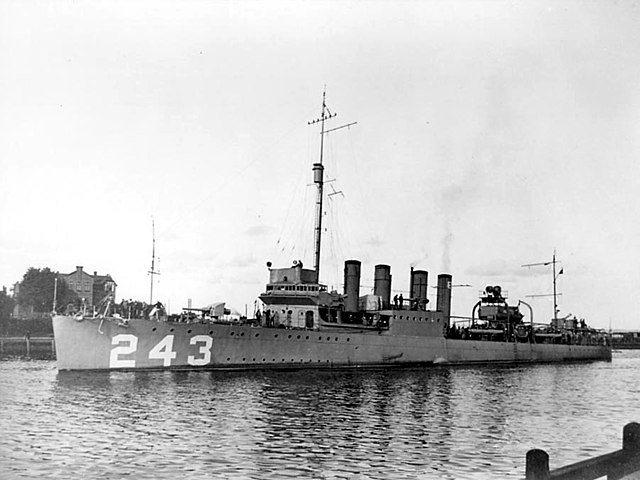
DD243 Sands was from New York SB (3/1919, 28.10.1919, 11/1920). She became of the most succeessful Clemson class destroyers thanks to her records in the Pacific as high speed transport, earning 9 battle stars. Philadelphia, European departure 14 December via Melville, Rhode Island, New York and sailed out 3 January 1921, Brest and runs French-British ports. Baltic and back to Cherbourg. Eastern Mediterranean-Black Sea TOD. 9 July 1922 Gibraltar, back home. OVL August-November Philadelphia. Scouting Fleet New York, Caribbean, Fleet Problem. Decom. 13 February-21 July 1931. Training West coast, San Diego, Hawaii. Rotating DesRon 20, DesDiv 9, Caribbean, North Pacific, east coast, New England, southern California, Hawaiian Islands. Decom. San Diego 15 September 1938 to 26 September 1939. Caribbean neutrality patrol, eastern Blacksea, Back to Pacific. Escort until spring 1942. Aleutian Islands campaign.
Converted 1943 as high speed transport APD-12.
Pearl Harbor, Espiritu Santo, Guadalcanal-Tulagi area. Another run to Guadalcanal, Tulagi, Koli Point, Russell Islands. Caledonia-New Hebrides-Solomons area. 7th Amphibious Force, New Hebrides. HP Townsville, Australia. Various missions, notably to New Britain. TG 76.1, Saidor, Buna, New Guinea, Humboldt Bay, Hollandia operation. OVL Alameda, Pearl Harbor. Palau operation, Peleliu, Anguar. Ulithi, Manus, Leyte Gulf, Tacloban area. Invasion of Luzon. Western Carolines, Iwo Jima, Saipan, Ryukyus, Okinawa area. San Diego until V-Day, decom. Philadelphia 10 October 1945.
 USS Williamson (DD-244)
USS Williamson (DD-244)
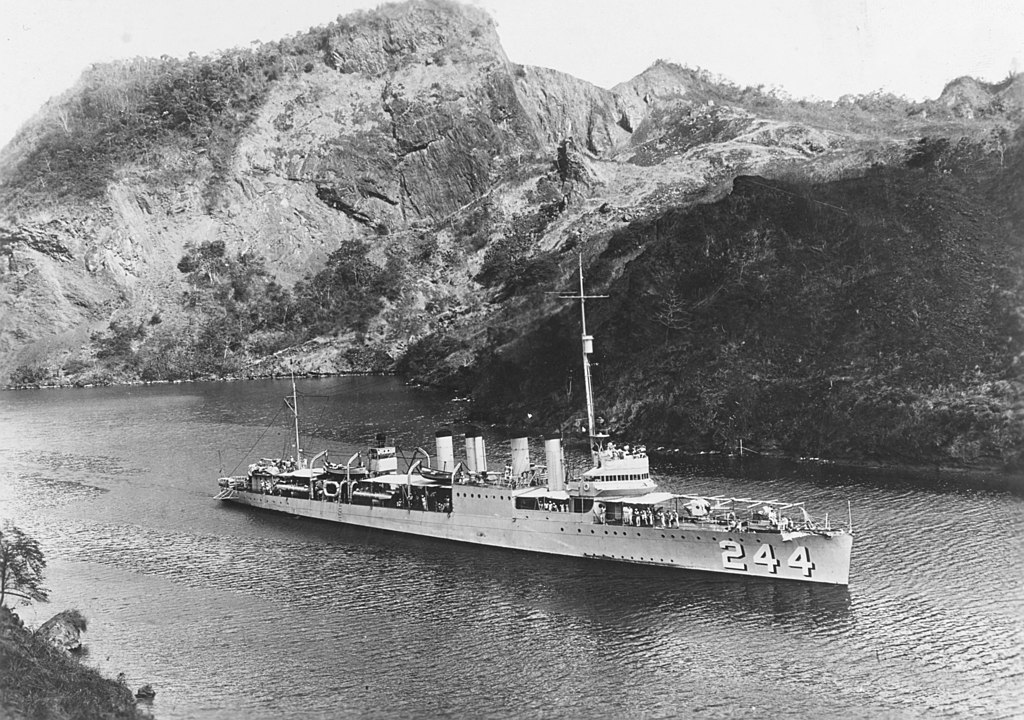
DD244 USS Williamson was from New York SB, Camden (3/1919, 16.10.1919, 10/1920 ). Dept. New York 3 January 1921 for Europe via Bermuda to Brest, France, Cherbourg, Gravesend, Portsmouth, eastern Mediterranean 23 May, Turkish waters. Ineboli 22 June. Back to Atlantic Fleet, Hampton Roads. Training routine, OVL 1928, reserve training cruises. 1931 DesDiv 9 San Diego and back East Coast. Rotating reserve. OVL 1935, DesRon 3. East Coast Philadelphia, conversion to light seaplane tender with USS Childs, experimental. AVP-15. Philadelphia on 3 January 1939, Norfolk, PatWing 5, Florida Keys, Newport, West Coast April. San Diego, Seattle. Kodiak Alaska VP-41 and VP-42 PBY Catalinas until September 1939. OVL Puget Sound February 1940. NAS Seattle, reclass. AVD-2.
Dec. Puget Sound OVL. DesRon) 82, then Aleutians PatWing 4. Back San Diego spring 1943, trained with submarines, plane-guarding for carriers. Redesignated DD-244.
OVL Mare Island January 1944, Pearl Harbor, South Pacific, Samoa, Espiritu Santo, Guadalcanal-Funafuti, TU 34.6.4 New Guinea. 5th Amphibious Force May 1944, tending OS2U Kingfisher and SOC Seagull scout planes. Saipan, Marianas, Eniwetok, occupation of Guam. Eniwetok, Pearl Harbor with convoy, OVL, then plane guard CarDiv 11. Until 8 January 1945 escort for USS Ranger, Saratoga, Bataan, Corregidor, and Makassar Strait. 5th Fleet, Carolines via Ulithi. Saipan-Tinian, Iwo Jima. Invasion of Okinawa. Kerama Retto, Guam, Marianas. Plane guard for USS Hoggatt Bay, Nehenta Bay, White Plains, Manila Bay, Velio, Vella Gulf, Makin Island, Makassar Strait, Casablanca. Back Philadelphia, decom. 8 November 1945. 4 battle stars.
 USS Reuben James (DD-245)
USS Reuben James (DD-245)
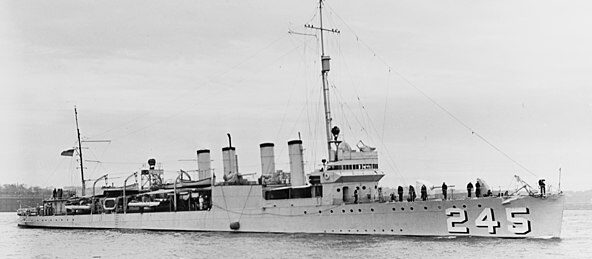
DD245 Reuben James was built at New York SB, Camden from 4/1919 launched 4.10.1919 and comp. 9/1920. She served in the interwar in the Mediterranean Atlantic and Pacific, and in neutrality patrols from 1939, and from March 1941 on the Halifax-Iceland convoy route (escorted two). Sunk by U-552 near Iceland on 31 October 1941.
 USS Bainbridge (DD-246)
USS Bainbridge (DD-246)
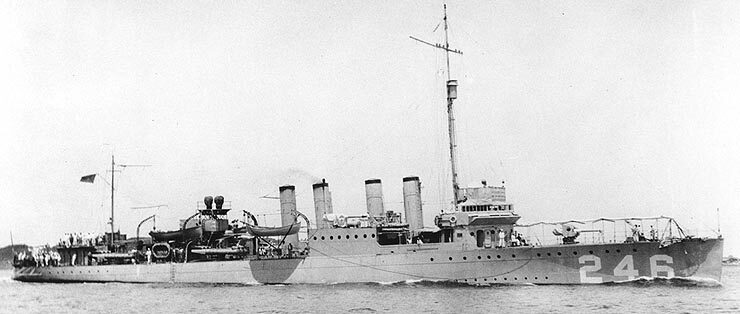
DD246 USS Bainbridge was from New York SB, Camden (5/1919, 12.6.1920, 2/1921). Atlantic Fleet. She operated on the eastern seaboard-Caribbean until October 1922, departed for Constantinople (Naval Detachment, Turkish waters). On 16 December 1922 she rescued 500 survivors of the burning French military transport Vinh-Long 10 miles off Constantinople earning a MoH to Lieutenant Commander Walter A. Edwards. Back to Newport, flagship Scouting Fleet and DesRon 14 Scouting Fleet Atlantic. 1923-1928 saw her in annual fleet exercises and tactical maneuvers. 1927 Special Service Squadron, Nicaragua. Training program with reservists. 23 December 1930, decom. Philadelphia to 9 March 1932, Rotating Reserve Division 19, Naval Reserve. Recom. 5 September 1933, DesRon 8. Florida Keys, Cuba, Pacific, San Diego November 1934. From Alaska to Hawaii. Decom. San Diego 20 November 1937 to 26 September 1939. DesDiv 62 Neutrality Patrol Panama Canal Zone until summer 1940. Key West patrol. 1941, northeast coast. Until November, three convoy escort to Newfoundland-Iceland. Between December 1941 and July 1945 convoy escort, US East and Gulf coasts, Caribbean and North Africa February–December 1943. HX 155, ON 31, HX 168, ON 57, AT 33, UGS 5A, GUS 9, UGS 16, GUS 15, UGS 22. Inactivated July 1945, decom. 21 July 1945 Philadelphia.
 USS Goff (DD-247)
USS Goff (DD-247)
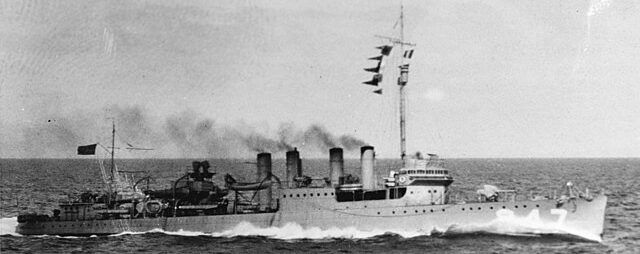
DD247 USS Goff was from New York SB, Camden (7/1919, 2.6.1920, 1/1921). 2 years Atlantic coast battle practice/exercises and Caribbean maneuvers. September 1922 Atlantic Fleet Europe, astern Mediterranean, Balkans, Greece, Turkey, Russia. Back homr 11 August, battle problems East Coast. OVL Norfolk, and 1925 PacFleet Pearl Harbor, back New York. Assisted Isle of Pines Cuba after hurricane. 1927 Special Service Squadron to Nicaragua. Resumed Atlantic coast routine. Decom. Philadelphia 13 January 1931 to 2 March 1932. Watched unrest in Cuba. 1935 Pacific Fleet San Diego. Back New York 1939, Neutrality Patrol. DesDiv 55 Azores June 1940, flagship. To Portugal, back Norfolk. DesDiv 67 as flagship. Caribbean patrol. From December 1941 Caribbean convoy escort/patrol. 16 June 1943 OVL New York. Norfolk 27 July, joined USS Card ASW TG. Convoys to Casablanca, credited 8 U-boats, awardared Presidential Unit Citation.
OVL New York, escort Norfolk-Casablanca and Reykjavík-New York, 7 months in 1944 with USS Albemarle: San Juan, Trinidad, Casablanca, Recife, Avonmouth. OVL Boston July 1944. Key West, Fleet Sound School. Philadelphia, decom. 21 July 1945. Awarded 2 battle stars.
 USS Barry (DD-248)
USS Barry (DD-248)

DD248, USS Barry was built at New York SB, Camden (7/1919, 28.10.1920, 12/1920). Commissioned with 50% complement she was held in reserve commission until 15 November 1921, then full commission Atlantic Fleet. By October 1922 she sailed to the Mediterranean, Turkish Waters, until July 1923. Back to the East Coast on 10 August 1923, joined DesRon 14. Plane guard for the “Around the World Flight” off Nova Scotia. 1925 Pacific Manoeuvers. Routine duties Scouting Fleet until Feb. 1932, Pacific, Atlantic Rotating Reserve DesDiv 19 Norfolk. San Diego DesDiv 7. May 1936 when, Atlantic, flagship DesDiv 8. Pacific Desdiv 22. May 1938 was DesDiv 21 Atlantic. DesDiv 67 Canal Zone October 1940. ASW patrols Caribbean and South Atlantic mid-1943. TG 21.14 North Atlantic. Converted high-speed transport Charleston until 17 February 1944, APD-29, East Coast April 1944, Mers-el-Kebir, Algeria, Operation Dragoon August 1944. Norfolk 23 December, OVL, Pearl Harbor March 1945, Okinawa Campaign. 25 May attacked by two kamikazes, onre hit below bridge, 22 wounded. Abandon ship, reboarded, fires extinguished towed to Kerama Retto. Inspected, stripped, decom. 21 June 1945, decoy for kamikazes. Hit by two Ki-43, sunk. Obtained 3 battle stars, for each theater.
 USS Hopkins (DD-238)
USS Hopkins (DD-238)

DD249 Hopkins was from New York SB (7/1919, 26.6.1920, 3/1921). Post shakedown, HP Newport in May, battle practice. November, DesRon 15 Atlantic Fleet. October, sailed to Constantinople. Back NyC 12 June. 7 years off New England and Charleston-Caribbean. February 1932 assisted Santiago de Cuba. February, San Diego. Escorted Pdt. Roosevelt’s to Canada July 1936. Norfolk April 1939, Neutrality Patrol. San Diego May, Pearl Harbor, converted DMS-13. Trained Johnston Island. Patrols Hawaiian Sea Frontier. Guadalcanal Campaign. Tulagi. 9 August shot down 2 enemy planes. Flagship Admiral Richmond K. Turner, Russell Islands February 1943. Shot down another Japanese plane. Rice Anchorage New Georgia, Bougainville, Convoy escort, patrols, sweeping in the Solomon Islands. Saipan 13 June 1944. Eniwetok then Guam. OVL San Francisco. Leyte Gulf 27 December 1944, Lingayen landings. Eniwetok, then Iwo Jima. Newt same and Okinaw. Kamikaze attacks: 4 May 1945 hit by glancing blow, 1 casualty, moderate damage. 7 June 1945 overhaul at Leyte until V-Day. 3rd Fleet, Tokyo Bay. Weathered two typhoons, October 1945 Eastern Seaboard, Norfolk, decom. 21 December. With 2 Navy Unit Commendations for heroism off Guadalcanal-Lingayen Gulf and 10 battle stars she is the most decorated Clemson-class destroyer.
 USS Lawrence (DD-250)
USS Lawrence (DD-250)
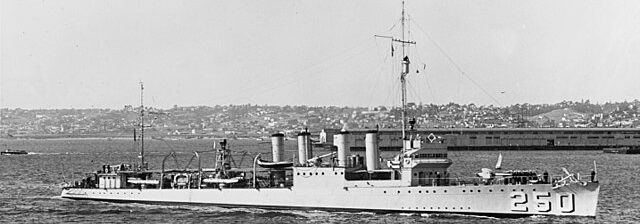
DD250 Lawrence was built at New York SB, Camden (8/1919, 10.7.1920, 4/1921). After shakedown, Destroyer Force Atlantic Fleet. Newport, dept. 13 June 1922, Mediterranean, Constantinople. New York 30 October 1923, returned Scouting Fleet. January 1924 joined exercizes Panama Canal. Labrador, Boston,3 years reserve training cruises east coast and Hawaii. Detached February 1927, Nicaragua; Decom. Philadelphia 6 January 1931 to 13 June 1932, Pacific Fleet until decom. San Diego 13 September 1938 to 26 September 1939. Patrols Caribbean. Boston March 1940, east coast sound school. December back Pacific, San Francisco, Sound School at San Diego. Convoys San Francisco-Seattle and Kodiak, Alaska. HP Treasure Island until 1945, covered convoys to San Francisco Bay. Philadelphia, decom. 24 October 1945.
 USS Belknap (DD-251)
USS Belknap (DD-251)
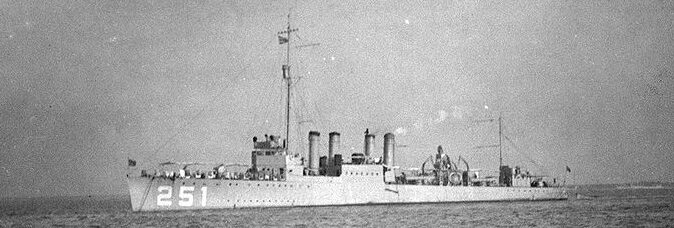
DD251 Belknap had been built at Fore River Yard, Quincy, Massachusetts (started 7/1918, launched 14.1.1919, completed 4/1919). Post shakedown cruise, joined eastern Mediterranean. Backn DesDiv 28 Atlantic Fleet, reserve Charleston, decom. 28 June 1922 until 1940. Converted seaplane tender AVD-8 2 August 1940, recom. 22 November. Patrol Wing 5, Hamilton, Bermuda. 1941 to Newport, 3 voyages Newport-Newfoundland-Iceland. Reykjavík September 1941-May 1942. OVL Charleston August 1942-January 1943. Caribbean Patrol. February 1943-January 1944 escort to USS Bogue, Croatan, Core ASW groups. DD-251 14 November 1943, earned Presidential Unit Citation for TG 21.12 Bogue. June 1944 conversion into high speed transport APD-34. Pacific September 1944, screen Leyte invasion fleet. January 1945 Lingayen Gulf landings. 11 January hiy by kamikaze (38 killed, 49wouned plus UDT9 team). Emergency repairs to 18 January and USS Hidatsa, ATF-102 towed to Manus, to Philadelphia NyD via west coast, 18 June. Decom. 4 August. 3 battle stars.
 USS McCook (DD-252)
USS McCook (DD-252)
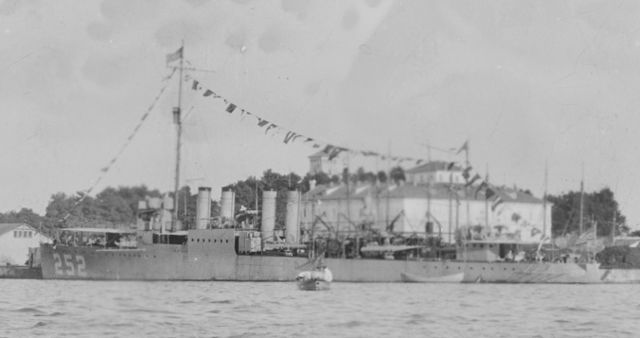
DD252 McCook was from Fore River also (9/1918, 31.1.1919, 4/1919). Following shakedown, Destroyer Force Atlantic Fleet, east coast, decom. Philadelphia 30 June 1922, Atlantic Reserve Fleet, until 18 December 1939. Neutrality Patrols, designated for exchange (Destroyers for Bases), sent Halifax, transferred to Canada as HCMS St.Croix 24 September Royal Navy and Royal Canadian Navy same day. Patrol duties in Canadian waters, Newfoundland Escort Force, Iceland, Mid-Ocean Escort Force, sank U-90 24 July 1942, 4 March 1943 assisted HMCS Shediac with U-87. St. Croix first escort sunk by U-305 (stern) 20 September 1943.
 USS McCalla (DD-253)
USS McCalla (DD-253)

DD253 McCalla was from Fore River (9/1918, 28.3.1919, 5/1919). McCalla remained active for 7 months: 26 November 1919 into reserve Norfolk, decom. 30 June 1922 to 18 December 1939. Neutrality Patrols, decommissioned Halifax, transferred Royal Navy 23 October 1940 as HMS Stanley (I73), 4th “Town” Flotilla. Modified for long range trade convoy escort service. Western Approaches Command, 40th Escort Group. Freetown and Gibraltar, co-claimed U-131 and U-434. 19 December 1941 spotted astern of the convoy, hit by U-574, exploded and sank, 16 survivors.
 USS Rodgers (DD-254)
USS Rodgers (DD-254)
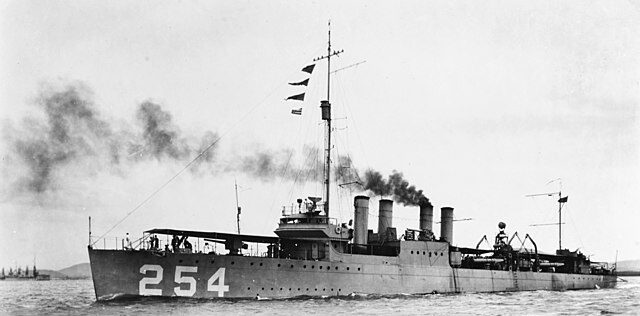
DD254 Rodgers (ex-Kalk) was from Fore River (9/1918, 26.4.1919, 7/1919). Assigned DesDiv 28, Atlantic Fleet until spring 1922 , decom. Philadelphia 20 July, reserve until 18 December 1939, Atlantic Fleet neutrality Patrols. October 1940, Halifax, transferred as HMS Sherwood 23 October 1940, 4th “Town” Flotilla. Belfast, Portsmouth, OVL, 12th Escort Group Western Approaches Command, HP Londonderry. Iceland OVL, then 2nd Escort Group,22nd, 1943 target ship for training aircraft RNAS Fearn Scotland. Newfoundland Command, Tunisia. Reserve Chatham, stricke, BU.
 USS Osmond Ingram (DD-255)
USS Osmond Ingram (DD-255)

DD255 Ingram (or Osmond Ingram) was also from Fore River (10/1918, 28.2.1919, 6/1919). Atlantic service, fleet operations 1919-1922, decom. Philadelphia 24 June 1922. Converted seaplane tender 22 November 1940. HP San Juan, Puerto Rico 15 January 1941. Operated to Trinidad, Antigua, San Juan. Panama Canal Zone, Salinas, Ecuador,Galápagos until June 1942. Escort duty Trinidad, Recife, Belém. NS Argentia Newfoundland, USS Bogue Group, sank U-172 with gunfire 13 December 1943, Presidential Unit Citation. Convoy to Gibraltar 1944, escort New York-Trinidad. OVL Charleston, conversion high speed transport, Mediterranean French coast 14 August 1944. Norfolk December, Pacific, escort New York-San Diego-Pearl Harbor, Eniwetok, Ulithi. Okinawa, Saipan, Guam, Hagushi Anchorage, Leyte-Hollandia, Philippines-Borneo. Wakayama, Kure, Nagoya occupation Forces. Decom. Philadelphia 8 January 1946, 6 battle stars.
 USS Bancroft (DD-256)
USS Bancroft (DD-256)
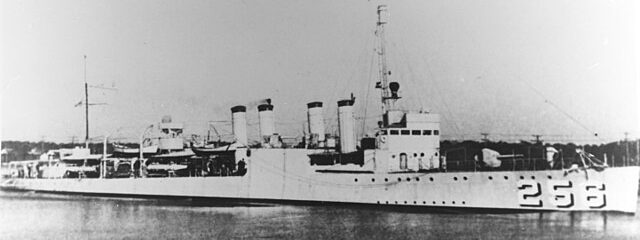
DD256 Bancroft was from Fore River (11/1918, 21.3.1919, 6/1919). Atlantic Fleet fleet training until 26 November 1919, reserve. Decom. Philadelphia 11 July 1922 to 18 December 1939, Atlantic Squadron east coast neutrality Patrols, Halifax, transferred 24 September 1940 as HMCS St. Francis. Royal Canadian Navy various convoys until 1 April 1945, declared surplus, towed to Baltimore for BU but collided with collier Windward Gulf, sunk on even keel in 60 feet water 2 miles off Acoaxet.
 USS Welles (DD-257)
USS Welles (DD-257)
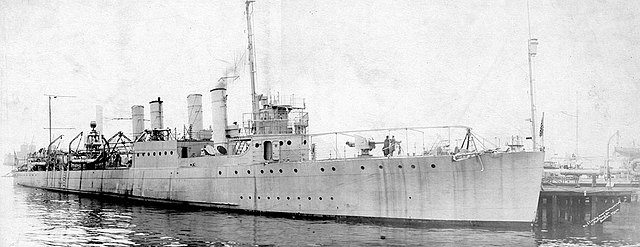
DD257 Welles was from Fore River (11/1918, 8.5.1919, 9/1919). Final sea trials east coast, DesRon 2 Pacific Fleet San Diego. Decom. 15 June 1922 until 6 November 1939. Refitted Mare Island. San Diego, Panama, Guantanamo Bay, HP Norfolk assigned to DesDiv 67, USS Omaha Neutrality Patrol by April; Back to San Juan in April, Cuban waters, Guantanamo Bay, battle practice. Norfolk 22 August, Newport, Boston refit, Halifax, decom. 9 September 1940, transferred as HMS Cameron. Refit Plymouth November. 5 December 1940 bombed by Luftwaffe. Badly damaged and capsized. Refloated 23 February 1941, used as hulk. Paid off 5 October 1943, BU.
 USS Aulick (DD-258)
USS Aulick (DD-258)
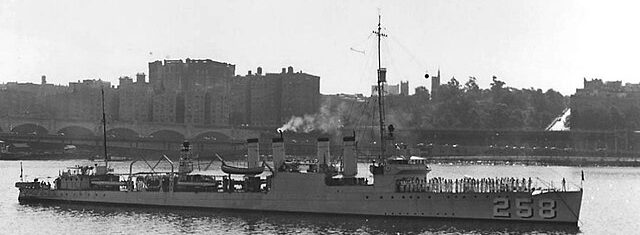
DD258 Aulick was from Fore River (12/1918, 11.4.1919, 7/1919). After her shakedown cruise, west coast, DesFlot 10, Pacific Fleet. California coast service, routine fleet duties. Decom. 27 May 1922 Mare Island Navy Yard. Recom. 18 June 1939 San Diego, transisted east coast. Neutrality patrols until October 1940, decom. Halifax transferred as HMS Burnham. Escort between Iceland and Newfoundland, modified. Escort Group C-2, Mid-Ocean Escort Force: ON 113, HX 201, ON 119, SC 97, ON 129, SC 102. Escort Group C-3: ON 152, HX 221, ON 163, HX 226, ON 172, SC 124, ON 180 HX 238. 1944 aircraft training duties, Western Approaches Command, reserve Milford Haven November 1944. Scrapped Pembroke December 1948.
 USS Turner (DD-259)
USS Turner (DD-259)

DD259 Turner was from Fore River (12/1918 , 17.5.1919, 9/1919). She had a very unusual career. After east and west coasts routine service, decom. San Diego 7 June 1922, reserve. Name struck from Navy list 5 August 1936, 28 September 1936 was authorized for conversion as self-propelled water barge to follow the fleet in operation. Converted San Diego, re-classified YW-56, based San Diego, 11th Naval District October 1940. May 1942 used as ferry between San Diego and San Clemente Island. Renamed USS Moosehead, IX-98 on 13 February 1943. Sonar and radar installed, recommissioned at San Diego 5 April 1943 for Operational Training Command Pacific Fleet. Flagship Rear Admiral Frank A. Braisted, out of San Diego. 11 round trips to San Clemente Island with passengers, mail and cargo, towed targets for various ships, served as a torpedo target, screened battleships and cruisers when training at home. At-sea platform for training officers of the Combat Information Center crews. Has the most up to date radar and sonar and a CIC classroom, berthing facilities. July 1943 did the same for escort carriers, Casablanca and Commencement Bay classes. Trained CIC teams from many other types in the Navt, and used as test and evaluation for experimental rockets, radars or radio jamming, making some 100,000 miles (160,000 km) at sea, training more than 4,200 officers and men. Flagship commander, Training Command West Coast until 24 December 1945. Decom. San Diego 19 March 1946, stricken 17 April.
 USS Gillis (DD-260)
USS Gillis (DD-260)

DD260 Gillis was from Fore River (12/1918, 29.4.1919, 9/1919). Newport 17 December 1919 to San Diego 20 January 1920, Pacific Fleet, manoeuvers West Coast until decom. San Diego 26 May 1922 to 28 June 1940. Reclassified 2 August as seaplane tender AVD-12, converted at San Francisco 25 March 1941. Patrol Wing 4 between San Diego and Seattle and Sitka, Alaska (14–17 June), Dutch Harbor, Kodiak (15–31 July). OVL Puget Sound, back to Kodiak 16 October 1941. OVL Puget Sound Naval 9 February 1942. Tender duties Kodiak May 1942. Atka 11–13 June, air-sea rescue patrol. One Catalina attacked unknown IJN sub, probably hit;
19 April 1944 OVL Puget Sound, San Diego, plane guard for aircraft carriers training. Pearl Harbor December 1944. Plane guard for USS Makassar Strait (CVE-91) until 20 February 1945. Marshalls, Marianas, Ulithi, invasion of Okinawa: Kerama Retto 25 March 1945, guarded minesweepers. Observation, air-sea rescue patrols. Philippines, escorted Wake Island (CVE-65). Guam 3 July 1945, home, San Pedro, decom. 15 October 1945. 2 battle stars.
 USS Delphy (DD-261)
USS Delphy (DD-261)
DD261 Delphy was from the Bethlehem Naval Yard in Squantum (4/1918, 18.7.1918, 11/1918); She was wrecked at Hond Point on 8.9.1923.
 USS McDermut (DD-262)
USS McDermut (DD-262)
DD262 McDermut was from Bethlehem (4/1918, 6.7.1918, 3/1919). After a career without significant event, she was stricken on 11.1931
 USS Laub (DD-263)
USS Laub (DD-263)
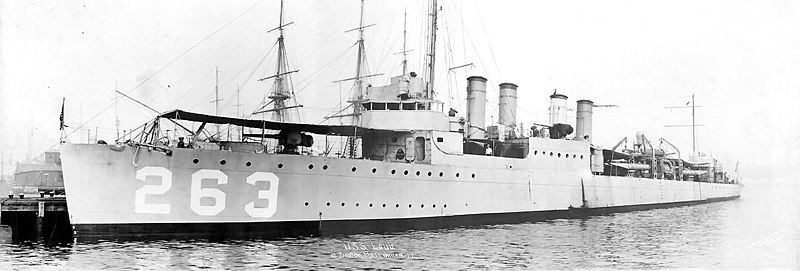
DD263 Laub was from Bethlehem (4/1918, 25.8.1918, 3/1919). Assigned Atlantic destroyer force, HP Newport. 2-17 May 1919 off Newfoundland as plane guard (NC-4 transatlantic flight). 30 June cruiser to European service, Brest 17 July. Western Europe and eastern Mediterranean, Constantinople 2 September, Food Commission relief. Back New York October, Pacific Fleet San Diego 27 November. December 1919 until decom. 15 June 1922 routine exercises Pacific coast. Recommissioned 18 December 1939. April 1940 Caribbean Neutrality patrol, and Gulf of Mexico. Halifax, decom. 8 October 1940, transferred RN as HMS Burwell. Modified for convoy escort, 24 Atlantic, 3 Gibraltar convoys. Captured U-570 August 1941. October 1943 Reserve, Air target Ship until January 1945, laid up.
 USS Mac Lanahan (DD-264)
USS Mac Lanahan (DD-264)

USS Maclahan and in the background, USS Melville, AD-2 at San Diego in 1919.
DD264 McLanahan was from Bethlehem (4/1918, 22.9.1918, 4/1919); After shakedown Massachusetts, sailed Europe. Transferred Pacific Fleet October 1919, San Diego. Reserve, decommissioned June 1922 to 18 December 1939. Transferred East coast, neutrality patrols. 8 October 1940 decommissioned at Halifax transferred as HMS Bradford (H72). Refitted Devonport, rebuilt as long-range escort. 43rd Escort Group October 1941 to Gibraltar. 18 April 1942 collision with sloop Scarborough. Convoys to North Africa, Operation Torch. 3 May 1943 decom. Devonport, accommodation ship.
 USS Edwards (DD-265)
USS Edwards (DD-265)
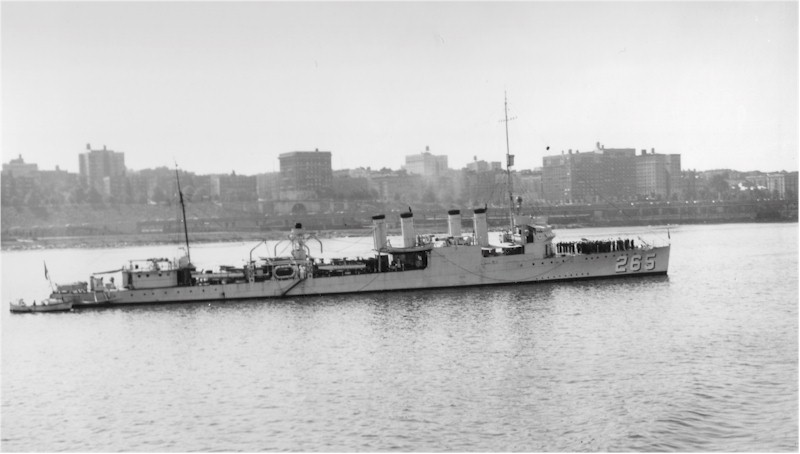
DD265 Edwards was from Bethlehem (4/1918, 10.10.1918, 4/1919). May 1919 carried spare parts for airplanes-seaplanes to St. John in Newfoundland for the first transatlantic seaplane flight. Boston, served in Europe with the Food Administration via Gibraltar, escorted SS George Washington to Brest, visited England, Germany. Pacific Fleet September 1919, San Diego 13 October, reduced commission. February 1920 Puget Sound, San Diego reserve, decom. 8 June 1922 to 18 December 1939. Neutrality Patrol, OVL, Galveston, Gulf-east coast patrol. Halifax, decom. 8 October 1940 transferred as HMS Buxton (H96), 3 “Town” Flotilla. Escort until late 1944, paid off early 1945.
 USS Greene (DD-266)
USS Greene (DD-266)
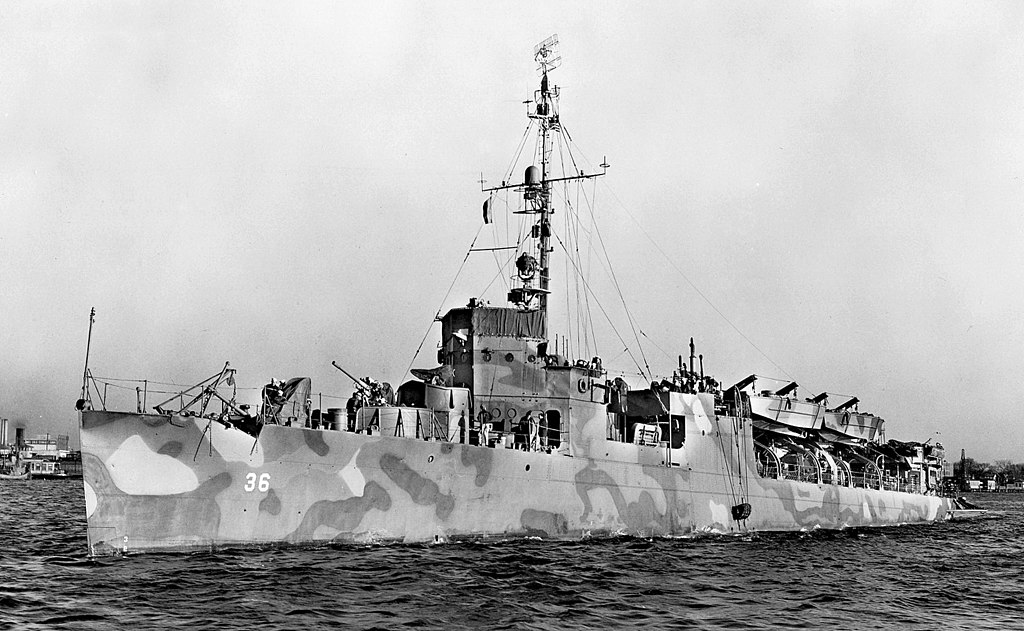
DD266 Greene (ex-Anthony) was from Bethlehem (6/1918, 2.11.1918, 5/1919). Newport June 1919 for Brest via Plymouth and New York 27 July. San Diego 22 December, decom. March 1920, Reserve Destroyer Force to 10 September 1921, Puget Sound, San Francisco, decom. 17 June 1922 to 28 June 1940 San Diego; Towed to San Francisco, converted as AVD-13, 6 April 1941. Caribbean training, Puerto Rico, Bermuda. Brazil up to summer 1942, NAS Natal, Rio de Janeiro OVL February 1942. Charleston July 1942. Escort to Bermuda, 6 months more.
To NS Argentia, joined USS Bogue escort carriers hunter killer group, North Atlantic. Based Northern Ireland. Took part in the sinking of U-569, U-317, U-118, Presidential Unit Citation. Troop convoy from Norfolk-UK and Bermuda. Joined USS Core HK group with Belknap and Goldsborough, sank U-378. Charleston 19 January 1944 converted, APD-36 February 1944. Sent to Oran, Operation Dragoon. Levant and Port Cros Islands landings. Escort Mediterranean. Norfolk, Panama, Ulithi March 1945, escort duties to Okinawa from Guam, Saipan and Philippines. Hit by Typhoon Louise, 9 October 1945 at Okinawa. Damaged beyond repair. Stripped, decom. 23 November 1945, destroyed with explosives 11 February 1946. 3 battle stars.
 USS Ballard (DD-267)
USS Ballard (DD-267)
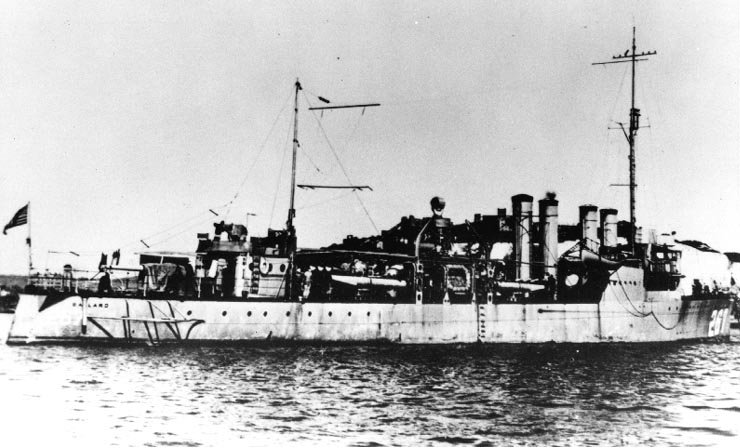
DD267 USS Ballard was from Bethlehem (6/1918, 7.12.1918, 6/1919). Reported to the Atlantic Fleet. Cruised to Europe and Mediterranean. To the Pacific, fleet maneuvers until decom. reserve San Diego 17 June 1922 to 25 June 1940. Converted Union Yard Bethlehem Steel Corporation San Francisco auxiliary seaplane tender AVD-10, recom. 2 January 1941 for Scouting Force, Pacific Fleet.
Pearl Harbor 28 January 1942. Picket duty Battle of Midway, rescued 35 Japanese seaman from IJN Hiryū. Up to November 1943, tending patrol planes and escort between Espiritu Santo, Guadalcanal, Florida, New Caledonia). OVL San Francisco 7 November-30 December 1943; Plane guard Carrier qualification off San Diego until May 1944. Saipan operation. Patrol duties, Palau Islands. Dec. 44 stationed at Seattle. Plane guard duties off San Diego until 1 October 1945. Decom. Philadelphia 5 December 1945.
 USS Shubrick (DD-268)
USS Shubrick (DD-268)
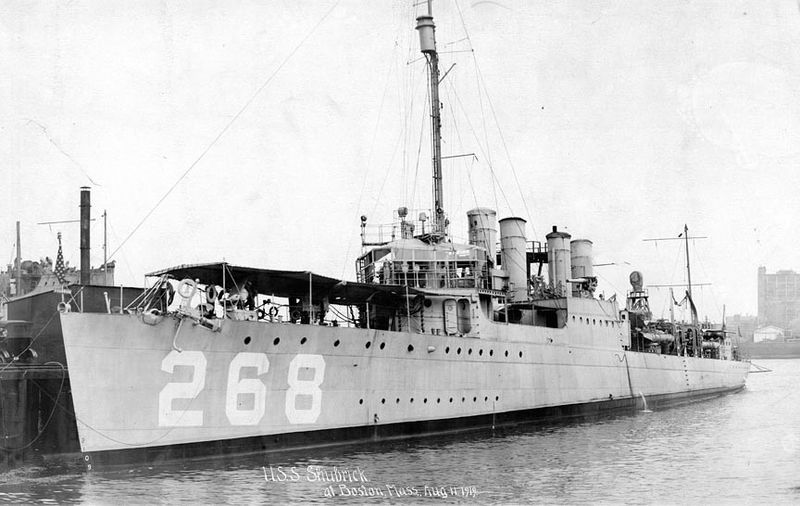
DD268 Shubrick was from Bethlehem (6/1918, 31.12.1918, 7/1919). After shakedown Newport, New York October 1919 to Port-au-Prince, Haiti. West coast exercises, HP San Diego, reserve destroyer division, decom. 8 June 1922 to 18 December 1939. OVL Mare Island 26 February-16 March 1940. Atlantic neutrality patrols March; Caribbean station until 29 June, West Gulf Patrol in July. TS Reservists from Miami, Boston, New York. OVL Norfolk, departed November for Halifax, decommissioned 26 November, transferred as HMS Ripley. Modified in UK, Escort Group B-7, Mid-Ocean Escort Force, convoy ON 142/ Reserve January 1944, BU.
 USS Bailey (DD-269)
USS Bailey (DD-269)
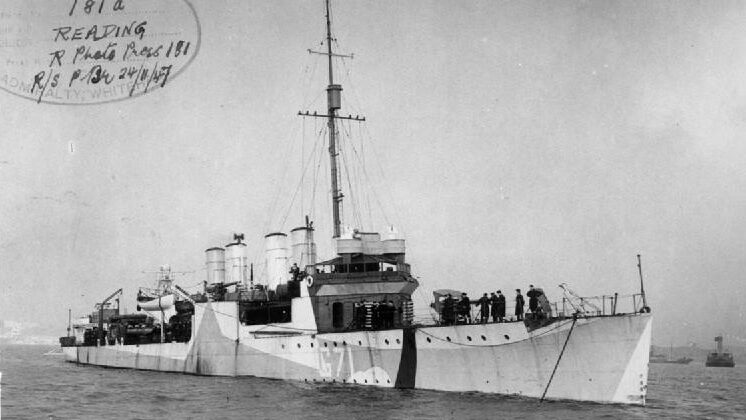
DD269 Bailey was from Bethlehem (6/1918, 5.2.1919, 6/1919). After commission, reported to the Pacific Fleet. Routine operations October 1919-June 1922. Patrol duty off Mexico; 1920. Decom. 16 June 1922 San Diego until 30 September 1939. Assigned DesDiv 72 Atlantic Squadron. Eastern seaboard until November 1940. November 1940 decom.Halifax, transferred as HMS Reading. Served with the 5th “Town” Flotilla, Plymouth December 1940, re-fitted, modified at Devonport. Escorted convoys Atlantic, HP Liverpool. Newfoundland Escort Group, escorted HMS Prince of Wales to Newfoundland Conference. May-October 1942 OVL London, target ship for aircraft: Air Station, Fearn, Scotland until July 1945, BU.
 USS Thornton (DD-270)
USS Thornton (DD-270)

DD270 Thornton was from Bethlehem, Squantum (6/1918, 22.3.1919, 7/1919). From August she sailed for Europe via the Azores, Gibraltar and toured the Mediterranean and Atlantic coast, back to Boston on 12 February 1920. Sent Pacific via Panama on 30 April 1920. HP San Diego 2 years California coast. Decom. there 24 May 1922 until 25 May 1940. Conversion to seaplane tender on 24 June 1940 at San Francisco yard, Bethlehem Steel Corp. August 1940 AVD-11, trials, official commission 5 March 1941. Sent Pacific Fleet, San Pedro, Pearl Harbor, until August 1942. Fired on planes Pearl Harbor attack. Stationed at French Frigate Shoals with USS Ballard (AVD-10). Served with 14th Naval District. Sent to Kodiak, TF 8. South Pacific: Suva (Fiji), Funafuti (Ellice), Vanikoro (Santa Cruz) Espiritu Santo (New Hebrides) July 1943-11 November 1943, Guadalcanal-Espiritu Santo as escort Chandeleur. OVL Mare Island February 1944, San Pedro, Pearl Harbor until late February 1945. Okinawa, collided with Ashtabula (AO-51) and Escalante (AO-70), repaired Kerama Retto, decommissioned 2 May 1945.
 USS Morris (DD-271)
USS Morris (DD-271)
DD271 Morris was from Bethlehem (7/1918, 12.4.1919, 7/1919) After a career without significant event, she was stricken on 5.1936
 USS Tingey (DD-272)
USS Tingey (DD-272)
DD272 Tingey was from Bethlehem, Squantum (8/1918, 14.4.1919, 7/1919). After a career without significant event, she was stricken on 5.1936
 USS Swasey (DD-273)
USS Swasey (DD-273)
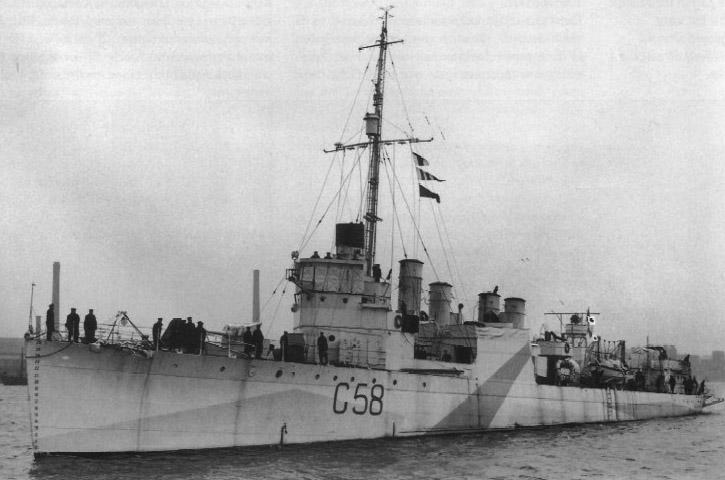
DD273 Swasey was from Bethlehem, Squantum (8/1918, 7.5.1919, 8/1919). She was assigned to the Pacific Fleet. After fitting, she left the west coast for Pearl Harbor in the fall of 1919 and served there until 1922, and sailed to San Diego, but was decommissioned at San Diego, 10 June 1922, reserve fleet, until 18 December 1939. Overhaul, modernization, after a neiutrality patrol tour of duty (TOD) she was sent to Halifax following the “Destroyer For Bases” agreement and transferred to Britain on 26 November 1940 as HMS Rockingham. The RN modified her further, with three, three triple torpedo tube removed, additional depth charge stowage, hedgehog. She served with Escort Group B-1, Mid-Ocean Escort Force (convoys ON 96, SC 105, SC 119, ON 171, HX 230 and HX 236) in 1942–43.
She sank on 27 September 1944 while under tow after striking a mine.
 USS Meade (DD-274)
USS Meade (DD-274)
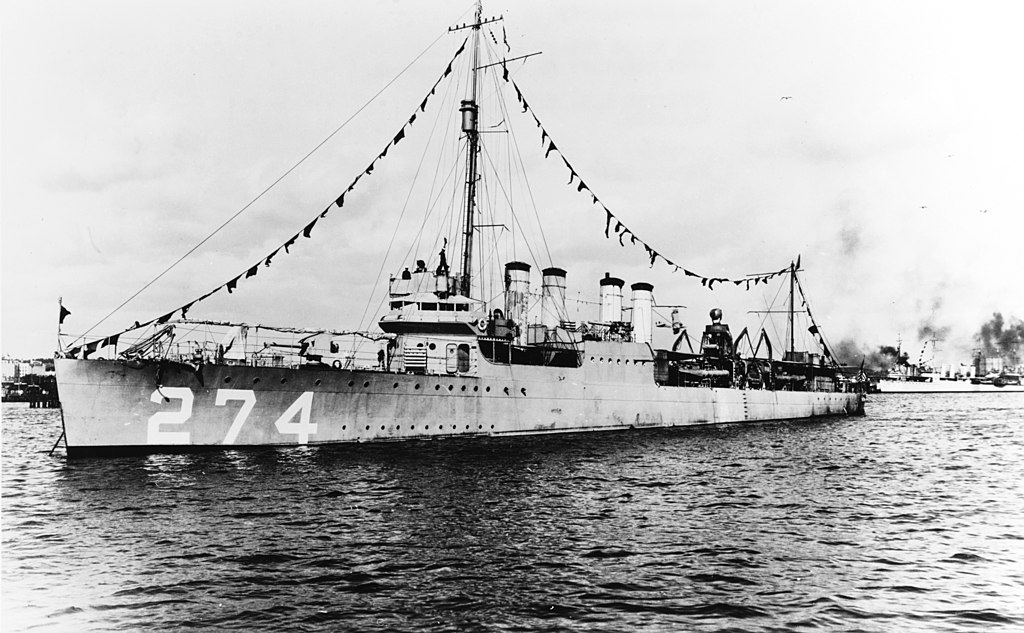
DD274 USS Meade was from Bethlehem (9/1918, 24.5.1919, 9/1919). After shakedown and trials on the east coast she was sent to the Pacific Fleet, HP San Diego, alternated to San Francisco in fleet and squadron maneuvers. She was decommissioned at San Diego, 25 May 1922, until 18 December 1939. Back to the east coast in 1940 she joined DesRon 9 for neutrality patrols along New England. Following the “Destroyers for Bases” Agreement she sailed to Halifax and was decommissioned there, transferred on 26 November 1940 as HMS Ramsey (G60). North Atlantic service, aircraft training ship until 30 June 1945, scrapped July 1947.
 USS Sinclair (DD-275)
USS Sinclair (DD-275)
DD275 USS Sinclair was from Bethlehem (10/1918, 2.6.1919, 10/1919). After a short peacetime career she was stricken on 6.1935
 USS McCalwey (DD-276)
USS McCalwey (DD-276)
DD276 USS McCawley was from Bethlehem, Squantum (11/1918, 14.6.1919, 9/1919). After a short peacetime career she was stricken on 8.1930
 USS Moody (DD-227)
USS Moody (DD-227)
DD277 USS Moody was from Bethlehem (12/1918, 28.6.1919, 12/1919). After a short peacetime career she was stricken on 11.1930
 USS Henshaw (DD-278)
USS Henshaw (DD-278)
DD278 Henshaw was from Bethlehem (1/1919, 28.6.1919, 12/1919). After a short peacetime career she was stricken on 7.1930
 USS Meyer (DD-279)
USS Meyer (DD-279)
DD279 USS Meyer was from Bethlehem (2/1919, 18.7.1919, 12/1919). After a short peacetime career she was stricken on 11.1930
 USS Doyen (DD-280)
USS Doyen (DD-280)
DD280 USS Doyen was from Bethlehem (3/1919, 26.7.1919, 12/1919). After a short peacetime career she was stricken on 7.1930
DD281 USS Sharkey was from Bethlehem (4/1919, 12.8.1919, 11/1919). After a short peacetime career she was stricken on 10.1930
 USS Toucey (DD-282)
USS Toucey (DD-282)
DD282 USS Toucey was from Bethlehem (4/1919, 5.9.1919, 12/1919). After a short peacetime career she was stricken on 10.1930
 USS Breck (DD-283)
USS Breck (DD-283)
DD283 USS Breck was from Bethlehem (5/1919, 5.9.1919, 12/1919). After a short peacetime career she was stricken on 10.1930
 USS Isherwood (DD-284)
USS Isherwood (DD-284)
DD284 USS Isherwood was from Bethlehem (5/1919, 21.9.1919, 12/1919). After a short peacetime career she was stricken on 10.1930
 USS Case (DD-285)
USS Case (DD-285)
DD285 USS Case was from Bethlehem (6/1919, 21.9.1919, 12/1919) After a short peacetime career she was stricken on 10.1930
 USS Lardner (DD-286)
USS Lardner (DD-286)
DD286 USS Lardner was from Bethlehem (6/1919, 29.9.1919, 12/1919) After a short peacetime career she was stricken on 10.1930
 USS Putnam (DD-287)
USS Putnam (DD-287)
DD287 USS Putnam was from Bethlehem (6/1919, 30.9.1919, 12/1919) After a short peacetime career she was stricken on 10.1930
 USS Worden (DD-288)
USS Worden (DD-288)
DD288 Worden was from Bethlehem (6/1919, 24.10.1919, 2/1920). After a short peacetime career she was stricken on 10.1930
 USS Flusser (DD-289)
USS Flusser (DD-289)
DD289 Flusser was from Bethlehem (7/1919, 7.11.1919, 2/1920). After a short peacetime career she was stricken on 10.1930
 USS Dale (DD-290)
USS Dale (DD-290)
DD290 Dale was from Bethlehem (7/1919, 19.11.1919, 2/1920). After a short peacetime career she was stricken on 10.1930
 USS Converse (DD-291)
USS Converse (DD-291)
DD291 Converse was from Bethehem (8/1919, 28.11.1919, 4/1920). After a short peacetime career she was stricken on 10.1930
 USS Reid (DD-292)
USS Reid (DD-292)
DD292 Reid was from Bethehem (9/1919, 15.10.1919, 12/1919). After a short peacetime career she was stricken on 10.1930
 USS Billingsley (DD-293)
USS Billingsley (DD-293)
DD293 Billingsley was from Bethehem (9/1919, 10.12.1919, 3/1920). After a short peacetime career she was stricken on 10.1930
 USS Charles Ausburne (DD-294)
USS Charles Ausburne (DD-294)
DD294 Charles Ausburn (ex-Ausburn) was from Bethehem (9/1919, 18.12.1919, 3/1920). After a short peacetime career she was stricken on 10.1930
 USS Osborne (DD-295)
USS Osborne (DD-295)
DD295 Osborne was from Bethehem (9/1919, 29.12.1919, 5/1920). After a short peacetime career she was stricken on 10.1930
 USS Chancey (DD-296)
USS Chancey (DD-296)
DD296 Chauncey was from Union Iron Wks, San Francisco (6/1918, 19.9.1919, 6/1919). She was ). She was wrecked on September, 9, 1923 at Honda Point, California. at Honda Point.
 USS Fuller (DD-297)
USS Fuller (DD-297)
DD297 Fuller was from Union Iron Wks, San Francisco. (7/1918, 5.12.1918, 2/1920). She was wrecked on September, 9, 1923 at Honda Point, California.
 USS Percival (DD-298)
USS Percival (DD-298)
DD298 Percival was from Union Iron Wks, San Francisco. (7/1918, 5.12.1918, 3/1920). After a short peacetime career she was stricken on 11.1930
 USS John Francis Burnes (DD-299)
USS John Francis Burnes (DD-299)
DD299 USS John Francis Burnes (ex-Swasey) was from Union Iron Wks, San Francisco. (7/1918, 10.11.1918, 5/1920). After a short peacetime career she was stricken on 7.1930
 USS Farragut (DD-300)
USS Farragut (DD-300)
DD300 Farragut was from Union Iron Wks, San Francisco. (7/1918, 10.11.1918, 6/1920). After a short peacetime career she was stricken on 7.1930
 USS Somers (DD-301)
USS Somers (DD-301)
DD301 Somers was from Union Iron Wks, San Francisco. (7/1918, 21.11.1918, 6/1920). After a short peacetime career she was stricken on 11.1930
 USS Stoddert (DD-302)
USS Stoddert (DD-302)
DD302 USS Stoddert was from Union Iron Wks, San Francisco. (7/1918, 8.1.1919, 6/1920). She was a miscellaneous auxiliary by June 1931, back as destroyer 4.1932 and stricken 6.1935
 USS Reno (DD-303)
USS Reno (DD-303)
DD303 Reno was from Union Iron Wks, San Francisco. (7/1918, 22.1.1919, 7/1920). After a short peacetime career she was stricken on 7.1930
 USS Farquhar (DD-304)
USS Farquhar (DD-304)
DD304 Farquhar was from Union Iron Wks, San Francisco. (8/1918, 18.1.1919, 8/1920). After a short peacetime career she was stricken on 11.1930
 USS Thompson (DD-305)
USS Thompson (DD-305)
DD305 Thompson was from Union Iron Wks, San Francisco. (8/1918, 19.1.1919, 8/1920). After a short peacetime career she was stricken on 6.1930
 USS Kennedy (DD-306)
USS Kennedy (DD-306)
DD306 Kennedy was from Union Iron Wks, San Francisco. (9/1918, 15.2.1919, 8/1920). After a short peacetime career she was stricken on 11.1930
 USS Paul Hamilton (DD-307)
USS Paul Hamilton (DD-307)
DD307 Paul Hamilton was from Union Iron Wks, San Francisco. (9/1918, 21.2.1919, 9/1920). After a short peacetime career she was stricken on 7.1930
 USS William Jones (DD-308)
USS William Jones (DD-308)
DD30 William Jones was from Union Iron Wks, San Francisco. (10/1918, 9.4.1919, 9/1920). After a short peacetime career she was stricken on 8.1930
 USS Woodbury (DD-309)
USS Woodbury (DD-309)
DD309 Woodbury was from Union Iron Wks, San Francisco. (10/1918, 6.2.1919, 10/1920). She was wrecked on September, 9, 1923 at Honda Point, California.
 USS S.P. Lee (DD-310)
USS S.P. Lee (DD-310)
DD310 S. P. Lee (ex-Branch) was from Union Iron Wks, San Francisco. (12/1918, 22.4.1919, 10/1920). She was wrecked on September, 9, 1923 at Honda Point, California.
 USS Nicholas (DD-311)
USS Nicholas (DD-311)
DD311 Nicholas was from Union Iron Wks, San Francisco. (1/1919, 1.5.1919, 11/1920). She was wrecked on September, 9, 1923 at Honda Point, California.
 USS Young (DD-312)
USS Young (DD-312)
DD312 Young was from Union Iron Wks, San Francisco. (1/1919, 8.5.1919, 11/1920). She was wrecked on September, 9, 1923 at Honda Point, California.
 USS Zeilin (DD-313)
USS Zeilin (DD-313)
DD313 Zeilin was from Union Iron Wks, San Francisco. (2/1919, 28.5.1919, 12/1920). After a short peacetime career she was stricken on 7.1930
 USS Yarborough (DD-314)
USS Yarborough (DD-314)
DD314 Yarborough was from Union Iron Wks, San Francisco. (2/1919, 20.6.1919, 12/1920). After a short peacetime career she was stricken on 11.1930
 USS La Vallette (DD-315)
USS La Vallette (DD-315)
DD315 La Vallette was from Union Iron Wks, San Francisco. (4/1919, 15.7.1919, 12/1920). After a short peacetime career she was stricken on 7.1930
 USS Sloat (DD-316)
USS Sloat (DD-316)
DD316 Sloat was from Union Iron Wks, San Francisco. (1/1919, 14.5.1919, 12/1920). After a short peacetime career she was stricken on 1.1935
 USS Wood (DD-317)
USS Wood (DD-317)
DD317 Wood was from Union Iron Wks, San Francisco. (1/1919, 28.5.1919, 1/1921). After a short peacetime career she was stricken on 7.1930
 USS Shirk (DD-318)
USS Shirk (DD-318)
DD318 Shirk was from Union Iron Wks, San Francisco. (2/1919, 20.6.1919, 2/1921). After a short peacetime career she was stricken on 7.1930
 USS Kidder (DD-319)
USS Kidder (DD-319)
DD319 Kidder was from Union Iron Wks, San Francisco. (3/1919, 10.7.1919, 2/1921). After a short peacetime career she was stricken on 7.1930
 USS Selfirdge (DD-320)
USS Selfirdge (DD-320)
DD320 Selfridge was from Union Iron Wks, San Francisco. (4/1919, 25.7.1919, 2/1921). After a short peacetime career she was stricken on 11.1930
 USS Marcus (DD-321)
USS Marcus (DD-321)
DD321 Marcus was from Union Iron Wks, San Francisco. (5/1919, 22.8.1919, 2/1921). After a short peacetime career she was stricken on 1.1935
 USS Mervine (DD-322)
USS Mervine (DD-322)
DD322 Mervine was from Union Iron Wks, San Francisco. (4/1919, 11.8.1919, 3/1921). After a short peacetime career she was stricken on 11.1930
 USS Chase (DD-323)
USS Chase (DD-323)
DD323 Chase was from Union Iron Wks, San Francisco. (5/1919, 2.9.1919, 3/1921). After a short peacetime career she was stricken on 8.1930
 USS Robert Smith (DD-324)
USS Robert Smith (DD-324)
DD324 Robert Smith was from Union Iron Wks, San Francisco. (5/1919, 19.9.1919, 3/1921). After a short peacetime career she was stricken on 7.1930
 USS Mullany (DD-325)
USS Mullany (DD-325)
DD325 Mullany was from Union Iron Wks, San Francisco. (6/1919, 9.7.1920, 3/1921). After a short peacetime career she was stricken on 11.1930
 USS Coghman (DD-326)
USS Coghman (DD-326)
DD326 Coghlan was from Union Iron Wks, San Francisco. (6/1919, 16.6.1920, 3/1921). After a short peacetime career she was stricken on 10.1930
 USS Preston (DD-327)
USS Preston (DD-327)
DD327 Preston was from Union Iron Wks, San Francisco. (7/1919, 7.8.1920, 4/1921). After a short peacetime career she was stricken on 11.1931
 USS Lamson (DD-328)
USS Lamson (DD-328)
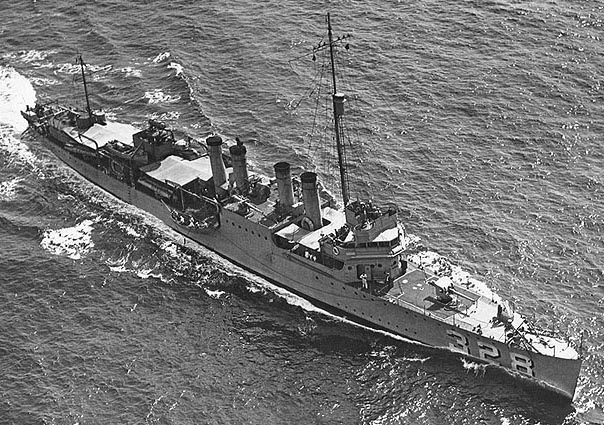
DD328 Lamson was from Union Iron Wks, San Francisco. (8/1919, 1.9.1920, 4/1921). After a short peacetime career she was stricken on 10.1930.
 USS Bruce (DD-329)
USS Bruce (DD-329)
DD329 Bruce was from Union Iron Wks, San Francisco. (7/1919, 20.5.1920, 9/1921). After a short peacetime career she was stricken on 11.1931
 USS Hull (DD-330)
USS Hull (DD-330)
DD330 USS Hull was from Union Iron Wks (9/1920, 18.2.1921, 9/1921). After a short peacetime career she was stricken 7.1930.
 USS MacDonough (DD-331)
USS MacDonough (DD-331)
DD331 USS MacDonough was from Union Iron Wks (5/1920, 15.12.1920, 4/1921). After a short peacetime career she was stricken 7.1930.
 USS Farenholt (DD-332)
USS Farenholt (DD-332)
DD332 USS Farenholt was from Union Iron Wks (9/1920, 9.3.1921, 5/1921). After a short peacetime career she was stricken 7.1930.
 USS Sumner (DD-333)
USS Sumner (DD-333)
DD333 Sumner was from Union Iron Wks (8/1919, 24.11.1920, 5/1921). After a short peacetime career she was stricken 7.1930.
 USS Corry (DD-334)
USS Corry (DD-334)
DD334 USS Corry was from Union Iron Wks (9/1919, 28.3.1921, 5/1921). After a short peacetime career she was stricken 7.1930.
 USS Melvin (DD-335)
USS Melvin (DD-335)
DD335 Melvin was from Union Iron Wk (9/1920, 11.4.1921, 5/1921). After a short peacetime career she was stricken 7.1930.
 USS Lichtfield (DD-336)
USS Lichtfield (DD-336)

DD336 Litchfield was from Mare Island Navay Yard in Vallejo, California (1/1919, 12.8.1919, 5/1920). Shakedown cruise west coast, dept. San Diego for Charleston, HP Newport, DesDiv 39 eastern Mediterranean, Constantinople 28 June 1922. Evacuation, relief. Bacl home late 1923. OVL New York 30 October 1923, DesDiv 12 San Diego 24 May 1924. 1925 cruise to Australia-New Zealand. Presidential review off Newport, Nicaragua expedition. HP Pearl Harbor, flagship SubRon 4. Escorted U.S. submarines. OVL Bremerton. January 1944 escorted convoys to Midway and Eniwetok. Submarine training. March 1945 to Guam, redesignated AG-95. San Diego, Philadelphia decom. 5 November 1945.
 USS Zane (DD-337)
USS Zane (DD-337)
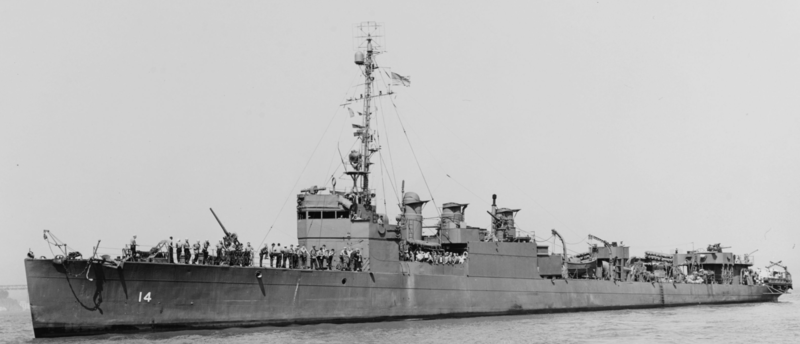
DD337 Zane was from Mare Island (1/1919, 12.8.1919, 2/1921). Fitting out, shakedown, Port Costa California June 1921,e Puget Sound, Bremerton, Mare Island, DesDiv 14 San Francisco, Asiatic Station via Pearl Harbor, Midway, Guam. HP Cavite. Yangtze estuary, Huangpu River, Shanghai, rammed by Chinese river steamer Tse Kiang aft. Repaired Yangtsepoo drydock 15 June. Chefoo 5 July, Chinwangtao. Back home, Decom. San Diego 1 February 1923 to 25 February 1930. Battle Force, Rotating Reserve Squadron 20 1934. DesDiv 10, DesDiv 4, DesFlot 2, fleet problems. Converted DMS-14 November 1940. Hawaii in December 1941. MinDiv 4 patrol offshore spring 1942. San Pedro, Los Angeles, Pearl Harbor by June.
Operation Watchtower. Sent Port Purvis on Florida Island. Zane and Trever carried supplies to Guadalcanal, Tulagi October 1942. Caught by Akatsuki, Ikazuchi, Shiratsuyu. Zane had a direct hit fwd. Escaped eastward. Were in Australia, in January 1943. Guadalcanal late February. Attack on the Russells in TU 61.1.3, Operation Cleanslate, Operation Toenails. 30 June heavy rain squall, Zane aground forward until back free but grounded, propellers damaged. Pulled off by fleet tug. Repaired Tulag, Mare Island. Staued Pearl Harbor until mid-January 1944. Operation Flintlock with TU 52.7.1. Operation Forager TG 12.13. Palaus, Marianas, Carolines, Philippines until mid-August 1945. San Diego, Panama, Norfolk, decom. 14 December 1945. 6 battle stars.
 USS Wasmuth (DD-1)
USS Wasmuth (DD-1)

DD338 Wasmuth was from Mare Island (8/1919, 15.9.1919, 12/1921). Shakedown Richmond, Mare Island, San Francisco, San Diego, San Pedro. Decom. San Diego 26 July 1922 to 11 March 1930. DesFlot 2 western seaboard, Rotating Reserve Squadron 10. Converted minesweeper DMS-15 19 November 1940. Trained Palmyra Island. Was in Pearl Harbor 7 December 1941, shot down one Val. MineDiv 4 ordered underway. Later operated Hawaiian chain spring of 1942. Convoy 4111 to San Francisco, Convoy 2113 to Parl harbor. Aleutian Islands Campaign; TF 8. 27 Dec. 1942 while escorting convoy in storm, 2 depth charges wrenched from their tracks, fell over the side, exploded beneath fantail. Wasmuth sank but crew saved by Ramapo, 29 December 1942.
 USS Trever (DD-339)
USS Trever (DD-339)

DD339 Trever was from Mare Island N Yd (8/1919, 15.9.1920, 8/1922). Service west coast. Decom. January 1923 to 2 June 1930, HP San Diego. Destroyer minesweeper DMS-16 19 November 1940, Pearl Harbor. 7 December 1941 moored in West Loch with USS Zane, Wasmuth, Perry; shoot don one, contributed others. Sortied under command of USS Henley (DD-391) captain and later Dwight Agnew on board Wasmuth. Until 1942 minesweeping operations. 28 January 1942 off Maui escorting 2-ship convoy to Hilo when attacked by I-71, hit General Royal T. Frank. I-71 escaped. OVL Mare Island. Sent to Solomon Islands. Destroyed Gavutu batteries, shot Mitsubishi G4M. 9 August Battle of Savo Island. Supplies Espiritu-Guadalcanal. New HP Nouméa. Battle of Cape Esperance.
Resupply runs until January 1943, OVL Sydney. Espiritu Santo, escorted LST-343 Russell Islands. New Georgia campaign. Attacked at Kula Gulf. Cpnvoy Pearl-San Francisco, OVL Mare Island. Empress Augusta Bay, Cape Torokina, Bougainville campaign. 18 December 1944 Western Caroline typhoon. December 1944 Eniwetok. OVL San Diego. Based Pearl Harbor until V-Day as AG-110.
Norfolk, decom. 23 November 1945. 5 battle stars.
 USS Perry (DD-340)
USS Perry (DD-340)

DD340 Perry was from Mare Island (9/1920, 29.10.1921, 8/1922). San Diego until 17 January 1923, decom. until 1 April 1930. Cruise to Alaska (US Senate embarked), Army–Navy–Coast Guard exercises eastern Pacific, Caribbean, western Atlantic. 2 April 1940, HP Pearl Harbor with USS Arizona. October converted high speed minesweeper DMS–17, MinRon 2 January 1941. Offshore patrols until 31 May 1942. OVL Mare Island. Convoy escort, Kodiak, Kiska, Adak, OVL San Francisco. Marshall Islands campaign January 1944. Kwajalein, New Guinea, 7th Fleet Milne Bay. TG 77.3 Aitape, Tamara, Alli Islands. Solomons, invasion of the Marianas with TG 51.17 with battleships of TF 58. Battle of the Philippine Sea with TG 53.1. Guam, Marianas, Rota, Palau invasion. Peleliu. At 8:11 12 Sept. 1944, mine explosion, port sweep gear destroyed. ASW patrols. Angaur shook by violent underwater explosion. Forward fireroom exploded and flooded. Abandon ship, assisted by Preble (DD-345), capsized, broke in two. 6 battle stars.
 USS Decatur (DD-341)
USS Decatur (DD-341)

DD341 Decatur was from Mare Islan (9/1920, 29.10.1921, 8/1922). San Diego, decom.n 17 January 1923 to 26 September 1923, flagship DesRon 11. Until 1937 she western seaboard-Caribbean, Hawaii. Cruise to Samoa September 1925, New Zealand-Australia. April 1926 extensive survey, Mexican coast. Carried Secretary of the Navy C. D. Wilbur at Bremerton 28 July 1926, Alaskan ports. Carried Haitian Commission to Santiago March 1930. Presidential Fleet Review 19 May. HP Norfolk February 1937. Escorted President Roosevelt Potomac-New Orleans, Texas. TS Midshipman, Naval Reserve. Neutrality patrols. Sent Argentia, Newfoundland September 1941, convoy escort Iceland-Boston May 1942. Norfolk-Key West, New York-Cuba, Boston-New York, Mediterranean and back, New York-Aruba-Mediterranean. Joined USS Card TG November 1943, back January 1944. Flagship TF 64 to Bizerte, Oran, Algiers. OVL Boston, Norfolk July 1944 TS Caribbean; Philadelphia decomm. 28 July 1945.
 USS Hulbert (DD-342)
USS Hulbert (DD-342)

DD342 Hulbert was from Norfolk Naval Yard, Virginia (11/1918, 28.6.1919, 10/1920). After shakedown Norfolk, Atlantic manoeuvers. Assisted ordnance tests captured German ships. HP Newport, 20 June 1922 Asiatic Station via Mediterranean, to Chefoo. 28 February 1923 furnace oil flared back, 6 dead. Evacuation March 1927 and September 1928. Visited Yokohama, back San Diego, plane guard Langley and Saratoga 1930-1934 decom. Philadelphia 17 October 1934, but converted as seaplane tender AVD-6 2 August 1940, San Diego, Patrol Wing 1 West Coast. May 1941 to Pearl Harbor, HQ for seaplane wing. December 1941 at the Submarine Base in Pearl Harbor. Shot down a dive bomber and damaged others. 30 December 1941 engaged by Jap. sub. I-1 while moored. Supply runs to Palmyra Atoll, Kodiak 6 June 1942, tend seaplanes of VP-43. Seguam Island August 1942, Atka, San Francisco, Seattle for Kodiak 1943. Amchitka as communications ship, Attu in June. Severe storm 30 June 1943, blown ashore, damaged, repaired and OVL Seattle, DD-342 December 1943, San Diego, escort ship and plane guard, screen for new escort carriers. Philadelphia, decom. 2 November 1945. 2 battle stars.
 USS Noa (DD-343)
USS Noa (DD-343)
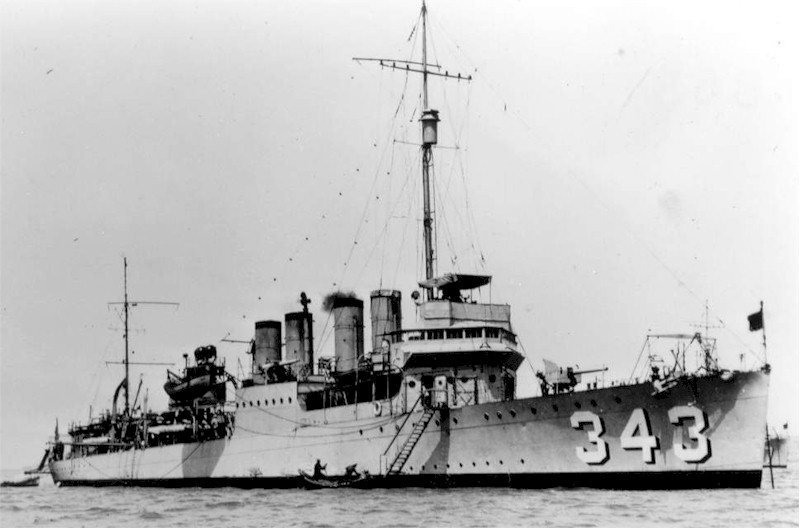
DD343 Noa was from Norfolk N Yd (11/1918, 28.6.1919, 2/1921). Charleston, Atlantic Coast training maneuvers. Asiatic Station via Mediterranean, Singapore in August 1922a, Cavite. 1927 helped rescue foreigners from Nanjing. Fired on Socony Hill (hostile Chinese force). Back home August 1929, OVL Mare Island, West Coast operations HP San Diego. Plane guarduss Langley, Saratoga. Decom. Philadelphia 11 November 1934 to 1 April 1940. Fitted with seaplane forward of the after deckhouse (after torpedo tubes removed) plus boom in place of the mainmast, tested the XSOC-1 seaplane, to convince the Navy of destroyer-based scout planes. Was to be applie don six Fletcher-class but cancelled in 1943. TS midshipman Annapolis. Plane guard USS Hornet. Mod. Boston for ASW patrols from 25 March 1943. Sound School Key West. 6th Amphibious Forces, converted at Norfolk as APD-24 August-September 1943. San Diego sent new New Hebrides, Buna, New Guinea, Cape Gloucester in New Britain twice and Green Island. Purvis Bay escort operations, Guadalcanal 4th Marine Division to Emirau Island, Hollandia operations. 2nd Marine Division to Saipan. Eniwetok to Saipan. Guam operations from Purvis Bay. Palau Islands with UDTs. Rammed by USS Fullam (DD-474) 12 September 1944, sank. Won 5 battle stars.
 USS William B. Preston (DD-344)
USS William B. Preston (DD-344)

DD344 William B. Preston was from Norfolk N Yd (11/1918, 9.9.1919, 8/1920). DesDiv 19 east coast, DesDiv 45, DesRon 14 Asiatic Fleet mid-1922. Nanking Incident, fired her 4-inch guns on Chinese battery and invading soldiers, Sailors firing with bolt-action Springfield rifles, drum-fed Lewis guns. Assisted by HMS Emerald and destroyer HMS Wolsey. Philadelphia, decom. 15 October 1934 until 14 June 1940. Converted destroyer-seaplane tender AVD-7. Caribbean, Panama, San Diego, Hawaii. Philippines, Asiatic Fleet. OVL Cavite. Catalinas patrolling the Celebes Sea. Attacked by 9 A5M Claude and 13 D3A Val from IJN Ryūjō. William B. Preston zigzagged and escaped unscathed. Tutu Bay, Tawi Tawi, tended OS2U Kingfishers to Tarakan, Borneo. Makassar, East Indies, Surabaya, Darwin, Australia in 1942. Ambon, Kendari, camouflaged to blend in with verdant hillside where moored. Attack of Darwing, hit aft. Escaped western coast, repaired Derby, Broome. Patrol Wing 10 with two PBY-5. Fremantle for upkeep. Exmouth Gulf with USS Heron and Childs. 1944 New Guinea, Milne Bay, Admiralties, Manus, Ellice Islands, Funafuti. Ordered by ComAir-Pac for home, San Francisco 18 September 1944; San Pedro, OVL Terminal Island. Plane guard and ASW escort off San Diego. Philadelphia, decom. 6 December 1945. 1 battle star.
 USS Preble (DD-345)
USS Preble (DD-345)
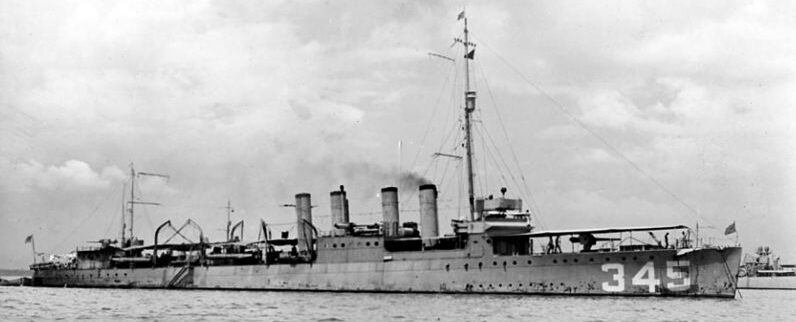
DD345 Preble was from Bath Iron Wks (4/1919, 8.3.1920, 3/1920). After shakedown, Mexican waters, Galveston for medical supplies to fight bubonic plague in Sonora. Atlantic Fleet, East Coast exercises or Panama Canal Zone, cruise to South America. HP Newport, sent to Asiatic Station via Suez DesRon 15, Chefoo August 1922, 7 years cruising from Manchuria to Burma. Dept. Tsingtao 1929 for San Diego. Hoster movie “Suicide Fleet”. Rotating Reserve DesRon 20 Mare Island Navy 1932-1934, fleet problems until 1937. Converted to light minelayer DM-20 June 1937. Pearl Harbor in Dec. 1941, unable to get underway. January dept. with Mine Division 1, French Frigate Shoals, Kodiak, OVL Seattle. Dec. 42 Fiji, New Caledonia as escort, New Hebrides January 1943.
ML Guadalcanal, New Hebrides, Russell Islands. ML Gizo-Wanawana Islands (Solomons), sank Japanese destroyer, damaged two others. OVL Pearl Harbor. Majuro, Marshall February 1944 as escort, joined TG 32.5. Peleliu. Admiralty Islands with TG 77.5, Leyte Gulf. OVL San Francisco. AG-99 in June, escorting aircraft carriers training/plane guard USS Vella Gulf, Sitkoh Bay. Norfolk, decom. 7 December 1945. 8 battle stars.
 USS Sicard (DD-346)
USS Sicard (DD-346)
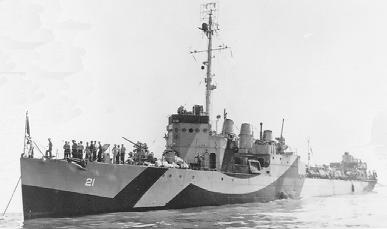 DD346 Sicard was from Bath Iron Wks (6/1919, 20.4.1920, 6/1920). From 26 June she joined the destroyer squadron Atlantic Fleet, HP Newport. East coast-Caribbean-Panama Canal Zone until 1922. Combined Atlantic-Pacific Fleet war games, stopped in Peru. West Indies, Asiatic Station via the Mediterranean Sea and Indian Ocean. Chefoo-Tsingtao and Manila. Assisted relief Nagasaki earthquake. OVL San Diego and later Mare Island, fleet problems. 1930 cruise Atlantic-Caribbean. 1934 Rotating Reserve Squadron 20 San Diego. DesRon 4. 12 May 1935 rammed by USS Lea (DD-118), badly damaged, repaired Pearl. May 1937 conversion as light minelayer DM-21. Hawaiian are utntil 1941. OVL Pearl Harbor from 21 November 1941 until 28 January 1942. Sent to Midway, Kodiak and Aleutian Islands, OVL San Francisco until 22 December 1942. Aleutians compaign as assault escort. Collided with USS Macdonough (DD-351) dense fog, San Francisco for repairs until 29 July 1943. September, escort Nouméa-Espiritu Santo-Purvis Bay, minelaying Bougainville, Shortland Islands, saw the Battle of Empress Augusta Bay.
DD346 Sicard was from Bath Iron Wks (6/1919, 20.4.1920, 6/1920). From 26 June she joined the destroyer squadron Atlantic Fleet, HP Newport. East coast-Caribbean-Panama Canal Zone until 1922. Combined Atlantic-Pacific Fleet war games, stopped in Peru. West Indies, Asiatic Station via the Mediterranean Sea and Indian Ocean. Chefoo-Tsingtao and Manila. Assisted relief Nagasaki earthquake. OVL San Diego and later Mare Island, fleet problems. 1930 cruise Atlantic-Caribbean. 1934 Rotating Reserve Squadron 20 San Diego. DesRon 4. 12 May 1935 rammed by USS Lea (DD-118), badly damaged, repaired Pearl. May 1937 conversion as light minelayer DM-21. Hawaiian are utntil 1941. OVL Pearl Harbor from 21 November 1941 until 28 January 1942. Sent to Midway, Kodiak and Aleutian Islands, OVL San Francisco until 22 December 1942. Aleutians compaign as assault escort. Collided with USS Macdonough (DD-351) dense fog, San Francisco for repairs until 29 July 1943. September, escort Nouméa-Espiritu Santo-Purvis Bay, minelaying Bougainville, Shortland Islands, saw the Battle of Empress Augusta Bay.
Alternated mineyaing/escort OVL Alameda, California July-September 1944. TS for submarines off Oahu until 9 January 1945 and Midway 2 September 1945 as AG-100. Decom. Philadelphia 21 November 19452. 2 battle stars.
 USS Pruitt (DD-347)
USS Pruitt (DD-347)
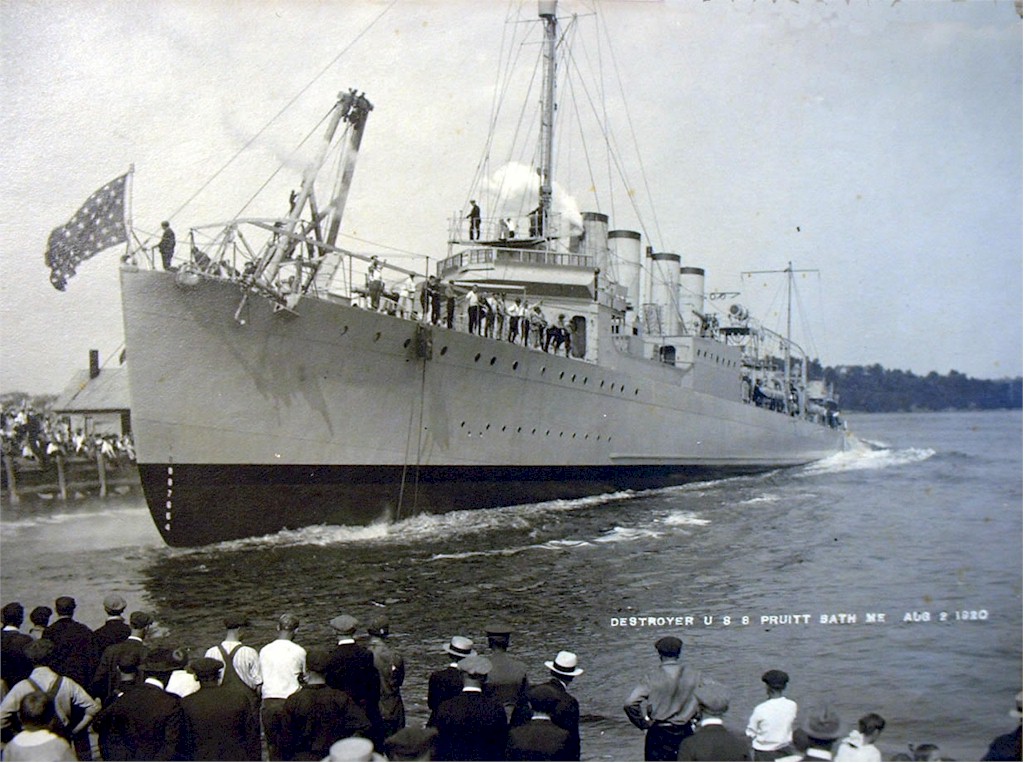
DD347 Pruitt was from Bath Iron Wks (7/1919, 28.3.1920, 9/1920). The intrwar saw her in the Western Pacific, and she was converted to a light minelayer when, back home, redesignated DM-22 on 30 June 1937. In Mine Division 1 she had another OVL at Pearl Harbor on 7 December 1941, under orders by Stephen Morrison (future rear admiral). Her crew went to other ships to man AA guns and replicate or fire hoses. Late January 1942 ofter overhaul complet, she started offshore patrol-minelaying up to June. Bremerton, Aleutian Islands (minelaying/escort) off Kodiak. In 1943, trained with 4th Marine Raider Battalion. Dpt. San Francisco for the Aleutians, TF 51, Cold Bay and Attu. Massacre Bay, Holtz Bay, Amchitka-Adak. Back San Francisco. September 43 sent to Solomon Islands and Bougainville, mined southern coast in November in support. Escorts Solomons, New Hebrides, New Caledonia, Societies. OVL San Francisco July 1944, October Pearl Harbor, submarine TS, Midway and later trained submarines SW of Oahu as AG–101 from 5 June 1945. Decom. Philadelphia 16 November 1945, stricken, sold. 3 battle stars.

 Latest Facebook Entry -
Latest Facebook Entry -  X(Tweeter) Naval Encyclopedia's deck archive
X(Tweeter) Naval Encyclopedia's deck archive Instagram (@navalencyc)
Instagram (@navalencyc)





 French Navy
French Navy Royal Navy
Royal Navy Russian Navy
Russian Navy Armada Espanola
Armada Espanola Austrian Navy
Austrian Navy K.u.K. Kriegsmarine
K.u.K. Kriegsmarine Dansk Marine
Dansk Marine Nautiko Hellenon
Nautiko Hellenon Koninklije Marine 1870
Koninklije Marine 1870 Marinha do Brasil
Marinha do Brasil Osmanlı Donanması
Osmanlı Donanması Marina Do Peru
Marina Do Peru Marinha do Portugal
Marinha do Portugal Regia Marina 1870
Regia Marina 1870 Nihhon Kaigun 1870
Nihhon Kaigun 1870 Preußische Marine 1870
Preußische Marine 1870 Russkiy Flot 1870
Russkiy Flot 1870 Svenska marinen
Svenska marinen Søværnet
Søværnet Union Navy
Union Navy Confederate Navy
Confederate Navy Armada de Argentina
Armada de Argentina Imperial Chinese Navy
Imperial Chinese Navy Marinha do Portugal
Marinha do Portugal Mexico
Mexico Kaiserliche Marine
Kaiserliche Marine 1898 US Navy
1898 US Navy Sovietskiy Flot
Sovietskiy Flot Royal Canadian Navy
Royal Canadian Navy Royal Australian Navy
Royal Australian Navy RNZN Fleet
RNZN Fleet Chinese Navy 1937
Chinese Navy 1937 Kriegsmarine
Kriegsmarine Chilean Navy
Chilean Navy Danish Navy
Danish Navy Finnish Navy
Finnish Navy Hellenic Navy
Hellenic Navy Polish Navy
Polish Navy Romanian Navy
Romanian Navy Turkish Navy
Turkish Navy Royal Yugoslav Navy
Royal Yugoslav Navy Royal Thai Navy
Royal Thai Navy Minor Navies
Minor Navies Albania
Albania Austria
Austria Belgium
Belgium Columbia
Columbia Costa Rica
Costa Rica Cuba
Cuba Czechoslovakia
Czechoslovakia Dominican Republic
Dominican Republic Haiti
Haiti Hungary
Hungary Honduras
Honduras Estonia
Estonia Iceland
Iceland Eire
Eire Equador
Equador Iran
Iran Iraq
Iraq Latvia
Latvia Liberia
Liberia Lithuania
Lithuania Mandchukuo
Mandchukuo Morocco
Morocco Nicaragua
Nicaragua Persia
Persia San Salvador
San Salvador Sarawak
Sarawak Uruguay
Uruguay Venezuela
Venezuela Zanzibar
Zanzibar Warsaw Pact Navies
Warsaw Pact Navies Bulgaria
Bulgaria Hungary
Hungary

 Bundesmarine
Bundesmarine Dutch Navy
Dutch Navy Hellenic Navy
Hellenic Navy Marina Militare
Marina Militare Yugoslav Navy
Yugoslav Navy Chinese Navy
Chinese Navy Indian Navy
Indian Navy Indonesian Navy
Indonesian Navy JMSDF
JMSDF North Korean Navy
North Korean Navy Pakistani Navy
Pakistani Navy Philippines Navy
Philippines Navy ROKN
ROKN Rep. of Singapore Navy
Rep. of Singapore Navy Taiwanese Navy
Taiwanese Navy IDF Navy
IDF Navy Saudi Navy
Saudi Navy Royal New Zealand Navy
Royal New Zealand Navy Egyptian Navy
Egyptian Navy South African Navy
South African Navy






























 Ukrainian Navy
Ukrainian Navy dbodesign
dbodesign